ENJOYING SANGIOVESE
Sangiovese can age, and age well, but most of its wines are intended to be drunk within a year or two of the harvest; they may develop an almost tomato-like leanness if left hanging around for too long. In fact, with so many different styles and qualities being made in Italy and with many of these being very recent innovations, it’s pretty tricky to generalize about aging. In most regions there are a few producers trying to do something smart with Sangiovese that could merit aging, but even they themselves couldn’t guarantee you a successful conclusion, especially when the use of new oak has been overdone.
The longest-lived wines are Brunello di Montalcino and the finest Sangiovese-based super-Tuscans. (Originally these all held the lowly status of vino da tavola, but now they have to move up the ranks of the Italian wine classification system, to DOC or IGT – Indicazione Geografica Tipica). In a good vintage these wines may well keep for 20 years, but most can start to be drunk after about five.
Vino Nobile di Montepulciano and the lighter Rosso di Montalcino can also be broached after five years, or sometimes less; all these should be drunk within eight to ten years. Carmignano has roughly the same lifespan.
Chianti is even more variable. Most basic Chianti should be drunk within three or four years of the vintage; Riserva may need a year or two more before it is ready. The very top wines, but only these, may last up to 15 years or more.
Other Italian Sangioveses should be drunk young unless they come from a producer who is specifically making a wine for aging. The same goes for New World Sangioveses: nearly all should be drunk within three or four years, and examples from Argentina are good within a year of the vintage.
The taste of Sangiovese
The traditional flavours of Tuscan Sangiovese are of bitter cherries and violets, with a certain tomatoey savouriness to the fruit, a definite rasp of herbs and a tea-like finish. Acidity is high and so is tannin: upfront fruit flavours are not the be-all and end-all of traditional Tuscan reds.
That has partly, though by no means entirely, changed. Those traditional flavours are likely nowadays to be richer and more concentrated, with better textures and finer tannins; the acidity is still there, but the greater concentration of flavour makes it less obvious.
The most international styles have a seasoning of vanilla and spice from new oak barriques, and the fruit leans more towards black cherry, plums and mulberries; where Cabernet Sauvignon joins the blend it is likely to be disproportionately dominant, with blackcurrant and plum flavours. These may become less noticeable as the wine ages.
Less ripe and concentrated Sangiovese can be stringy and rustic; that from warm climates can be heavier, broader and more alcoholic, tasting rather stewy and soupy and lacking the finesse of Tuscany’s finest.
New World flavours vary from oaky, plummy Cabernet lookalikes to attractively bright, cherry-fruited bottles to those with high alcohol but unripe tannins. None so far really have the poise and finesse of good Montalcino. Not for the first time, emulators have found it surprisingly difficult to capture the quintessence of Italy.
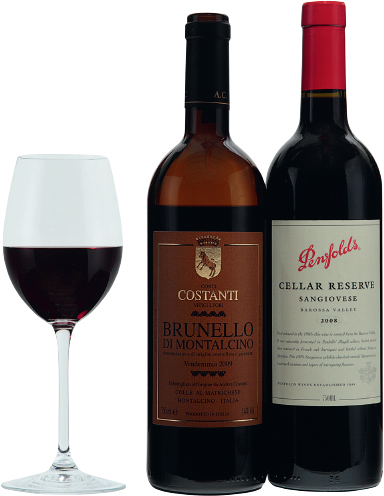
Brunello di Montalcino is now the world’s most famous and sought-after Sangiovese wine, but this success dates from as recently as the 1980s. It is well-deserved, since the best vineyards are fairly high, with infertile friable rocky soils. They are warmer than those of nearby Chianti, and also dryer, due to the looming Monte Amiata diverting most of the region’s bad weather away from the vines. Constanti’s 10ha (25 acres) of vines just below the hilltop town of Montalcino deliver consistently intense but elegant wines. Australia makes a richer, fruiter style, but Penfolds and others manage to keep the sweet sour Sangiovese character along with the juicier fruit.
MATCHING SANGIOVESE AND FOOD
Tuscany is where Sangiovese best expresses the qualities that can lead it, in the right circumstances, to be numbered among the great grapes of the world. And Tuscany is very much food-with-wine territory. Sangiovese-based wines such as Chianti, Rosso di Montalcino or Montepulciano, Vino Nobile and the biggest of them all, Brunello, positively demand to be drunk with food – such as bistecca alla fiorentina (succulent grilled T-bone steak), roast meats and game, calves’ liver, porcini mushrooms, casseroles, pizza, hearty pasta dishes and almost anything in a tomato sauce (Sangiovese’s acidity helps here), and tangy Pecorino cheese.
CONSUMER INFORMATION
Synonyms & local names
Also known (especially in Tuscany) as Sangioveto, Brunello or Prugnolo Gentile and Morellino. Corsica calls it Nielluccio.
Best producers
TUSCANY/Brunello di Montalcino
Agostini Pieri, Altesino, Argiano, Biondi-Santi, Brunelli, Camigliano, Caparzo, Casanova di Neri, Casanuova delle Cerbaie, Case Basse, Castelgiocando/Frescobaldi, Centolani, Cerbaiona, Ciacci Piccolomini d’Aragona, Donatella Cinelli Colombini, Col d’Orcia, Costanti, Fuligni, La Gerla, Greppone Mazzi, Lambardi, Lisini, Mastrojanni, Siro Pacenti, Pian dell’Orino, Pian delle Vigne, Piancornello, Pieve Santa Restituta/Gaja, La Poderina, Poggio Antico, Pogio San Polo, le Potazzine, Salvioni, San Giuseppe, Livio Sassetti, Scopetone, Sesti, Talenti, Valdicava, Villa Le Prata; Carmignano Ambra, Arteminio, Capezzana, Piaggia, Pratesi, Villa di Trefiano; Chianti Classico Riserva Ama, Antinori, Badia a Coltibuono, Bibbiano, Il Borghetto, Brancaia, Cacchiano, Capaccia, Carpineto, Casaloste, Castellare, Castell’in Villa, Collelungo, Colombaio di Cencio, Casa Emma, Felsina, Fonterutoli, Fontodi, Isole e Olena, Il Mandorlo, Monsanto, Il Palazzino, Paneretta, Panzanello, Poggerino, Poggio al Sole, Poggiopiano, Querciabella, Rampolla, Ricasoli, Riecine, Rietine, Rignana, Rocca di Castagnoli, San Felice, San Giusto a Rentennano, San Polo in Rosso, Casa Solo, Terrabianca, Vecchie Terre di Montefili, Vignamaggio, Villa Cafaggio, Villa Calcinaia, Villa Rosa; Chianti Rufina Basciano, Bossi, Colognole, Frascole, Frescobaldi, Grati/Villa di Vetrice, Grignano, Lavacchio, Selvapiana, Trebbio; Vino Nobile di Montepulciano Avignonesi, Bindella, Boscarelli, La Braccesca/Antinori, Le Casalte, La Ciarlana, Dei, Del Cerro, Fassatti, Gracchiano, Il Macchione, Nottola, Palazzo Vecchio, Poliziano, Redi, Romeo, Salcheto, Sanguineto I e II, Trerose, Valdipiatta; other central Italy Boccadigabbia, La Carraia, Castelluccio, Lungarotti, Zerbina.
GREECE Karipidis.
USA/California Alexander Valley Vineyards, Altamura, Bonny Doon, Frey, Monte Volpe, Ortman, Pedroncelli, Seghesio, Sobon Estate; New Mexico Luna Rossa; Washington State Cavatappi. Kiona, Leonetti, Long Shadows.
AUSTRALIA Brown Brothers, Cardinham Estate, Chapel Hill, Coriole, Crittenden, Greenstone, Oatley, Penfolds, Pizzini, Scaffidi, Stonehaven.
ARGENTINA Norton.
SOUTH AFRICA Bouchard Finlayson, Kleine Zalze, Morgenster.
RECOMMENDED WINES TO TRY
20 classic Tuscan reds (Sangiovese and with other Tuscan varieties)
Biondi-Santi Sassoalloro
Castello di Brolio Chianti Classico
Castellare I Sodi di San Niccolò
Fattoria di Felsina Fontalloro
Castello di Fonterutoli Chianti Classico Riserva
Fontodi Flaccianello
Frescobaldi Chianti Rufina Montesodi
Isole e Olena Cepparello
Castello di Lilliano Anagallis
La Massa Chianti Classico Giorgio Prima
Monte Bernardi Sa’etta
Montevertine Le Pergole Torte
Castello della Paneretta Quattrocentenario
Poggio Scalette Il Carbonaione
Fattoria Petrolo Torrione
Riecine La Gioia
Rocca di Montegrossi Geremia
San Giusto a Rentennano Percarlo
Selvapiana Chianti Rufina Riserva Vigneto Bucerchiale
Castello di Volpaia Coltassala
Five Tuscan Sangiovese-Bordeaux blends
Antinori Tignanello
Castello di Ama Chianti Classico La Casuccia
Castello di Fonterutoli Siepi
Querciabella Camartina
Poggerino Primamateria
Nine New World Sangiovese wines
Bouchard Finlayson Hannibal (South Africa)
Coriole McLaren Vale Sangiovese (Australia)
Dalle Valle Napa Valley Pietre Rosse (California)
Long Shadows Saggi (Washington State)
Leonetti Walla Walla Valley Sangiovese (Washington State)
Ortman Paso Robles (California)
Penfolds Cellar Reserve (Australia)
Pizzini Sangiovese Shiraz (Australia)
Seghesio Omaggio (California)
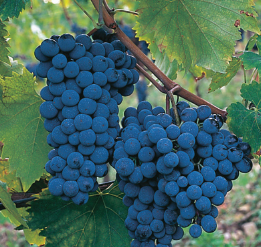
Intensive research is pushing the quality of Sangiovese further and further forward. We have probably not yet seen the best it can do – and if that applies to Tuscany, which it does, it applies even more to the New World.
Maturity charts
Simple wines can and should be drunk within a few years; more concentrated, tannic versions need longer.
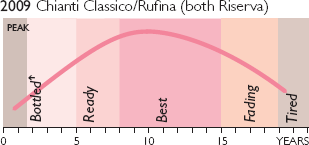
2009 was a hot, dry year in Tuscany, but the best Chiantis from the top estates are dark, ripe and long-lasting.
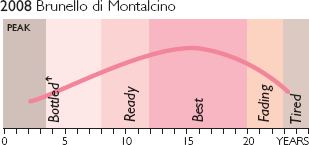
2008 was a hot year, but the heat wasn’t extreme and nights were cool, creating deep, balanced wine which will age well.
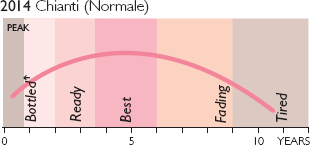
The 2011 vintage saw very difficult weather conditions in Tuscany; near drought in summer and blistering heat. Drink the wines young. .
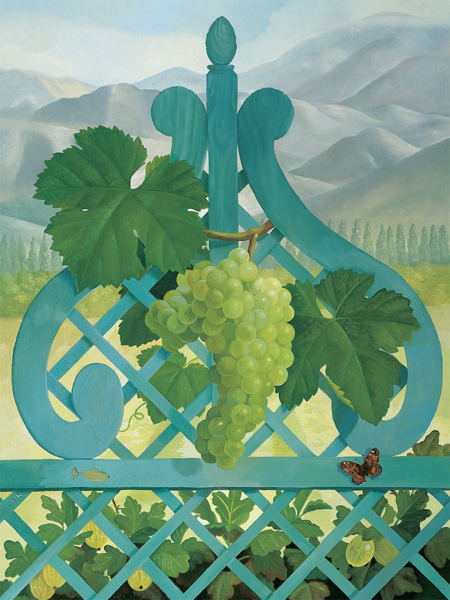
SAUVIGNON BLANC
Sauvignon Blanc: from Grape to Glass
Geography and History here; Viticulture and Vinification here; Sauvignon Blanc around the World here; Enjoying Sauvignon Blanc here
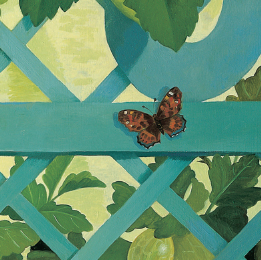
A piece of the trellis from the potager garden at the château of Villandry illustrates the Loire Valley’s long association with Sauvignon Blanc. The flavours of Sauvignon Blanc are linked to myriad fruit and vegetables but none more so than gooseberries. Behind the trellis stretch the vineyards and hills of the Marlborough region in New Zealand’s South Island, the world’s new classic area for Sauvignon Blanc.
Why on earth does everyone make such a goddammed fuss about Sauvignon Blanc? Why can’t they let it be? After all, it’s such a simple grape, isn’t it? The wine’s not complex, it’s not intellectually challenging, it’s just a cracking good drink. You get a bottle, you whack it in the chiller, you whip off the screwcap, slosh it into everybody’s glass and – hey – crisp, pure, tangy, thirst-quenching, yum. What a great drink! And I mean drink. A good glass of Sauvignon Blanc is like a good Gin & Tonic or a good chilled pint of golden ale. Just drink it. That’s what it’s there for.
The trouble is, winemakers can’t leave well alone. They can’t quite believe that what their audience love so much is Sauvignon’s simplicity. Especially since a great part of Sauvignon’s appeal is in its slightly underripe citrous, leafy flavours in a world gone mad for ripeness and even overripeness. One of the most worrying dogmas in wine today is a determination to achieve maximum phenolic ripeness in the wine grapes, and abhor anything with a sniff of underripeness about it. People who bang on about maximum ripeness – I wonder, have they ever tasted a perfect pear, a perfect Cox’s apple or a perfect plum. Perfection is always at the ‘just ripe’ stage, never at the overripe stage.
The bigger argument with Sauvignon Blanc is between methoxypyrazine proponents and devotees of thiols. Sorry about the science. In bluntest terms, methoxypyrazines are the green element in Sauvignon’s flavours, whereas thiols are the more exotic, tropical (if you’re lucky) passion fruit flavours – if you’re not lucky, armpit. I mean it. And not a washed one, either. I call Sauvignon a green grape – one that revels in the cool side of its personality, the green side, and one which is therefore almost always at its best coming from cool areas and cool vintages. The great classic cool area is Marlborough in New Zealand’s South Island, followed by the cool coastal regions of South Africa and Chile. Grapes have a natural green quality from those areas. They also get decently ripe because the sun shines most of the time. And that makes it possible to keep crunchy, lime zesty, leafy freshness in the wine and add just a little exotic passion fruit and nectarine ripeness. Doesn’t that make your mouth water? Well, that’s probably the perfect style.
It’s strange saying that the great classic areas for Sauvignon are places where grapes were hardly planted 30 years ago, sometimes hardly planted 10 years ago. But it’s true. Sauvignon Blanc has been growing in Bordeaux and the Loire Valley for centuries. Bordeaux has made some great wines from it in Pessac-Léognan, but only as part of a blend with Semillon. The Loire made the most famous Sauvignons in pre-New Zealand history, but they had names like Sancerre or Pouilly Blanc Fumé – they never mentioned the grape’s name on the label, so you didn’t know you were drinking it.
It took the South Island of New Zealand, and the Marlborough region in particular, to show Sauvignon’s astonishing flavours. This was an entirely new wine area with no terroir, no history, no reputation to protect. People realized that this brilliant, pungent, aggressively green yet exotically ripe style of wine was unlike anything the world had ever seen before. There had never been a wine with such outspoken, cut-glass purity of flavours whose whole purpose is to be refreshing and pleasurable.
I think it’s fair to say that New Zealand Sauvignon Blanc changed the wine world by changing our ideas of what wine could be like, just as the Chardonnays of California and Australia did. And for a long time these two wines occupied seats in the opposite corners of the White Wine boxing ring: the pungent, green, aggressive Sauvignon, bare and unoaked, and the warm, round, soft, creamy, spicy, tropical Chardonnay with oak a key part of its attraction. Now, many other varieties are filling in the gaps between the two, but in the early years of the Wine Revolution, when we looked for leaders we found two whites – sexy Chardonnay, swathed in oak, and Sauvignon, naked as nature intended – and with attitude. Chardonnay has already started to reinvent itself in a perkier, less oaky style. Let’s leave Sauvignon as it is.
GEOGRAPHY AND HISTORY
I’m tempted to say there’s no geography and no history of Sauvignon Blanc before 1973. That’s when the first Sauvignon vines were planted in the Marlborough region of New Zealand’s South Island. Within a few years they’d produced a wine of such shocking, tongue-tingling pungency that the world of wine was never the same again. Well, I’m tempted, but in fact Sauvignon Blanc had been around elsewhere for donkey’s years, except that it never gave a wine with half so much excitement as New Zealand’s offerings, and you virtually never saw the name Sauvignon on the label, so in any case you probably didn’t know you were drinking it.
But look at the map – it’s all over the place. New Zealand, sure, Australia, South Africa, Chile, northern Italy, Hungary, the Loire Valley, Bordeaux – almost everywhere you look you’ll find Sauvignon planted. Which might imply it’s a marvellously adaptable grape. But in fact it isn’t. Sauvignon Blanc is, in fact, quite picky about its site, and what we’re seeing at the moment is a sorting-out of styles, with only some places succeeding.
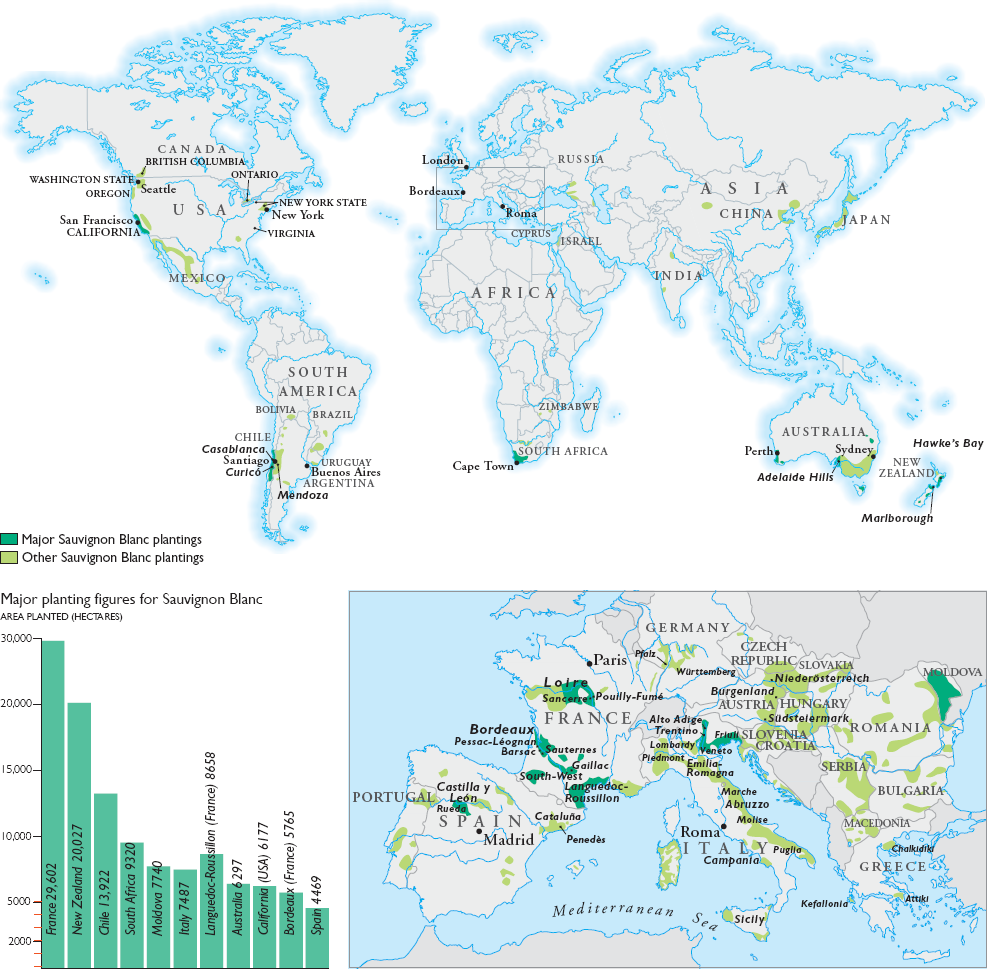
New Zealand, which first made us realize what Sauvignon could do, is suffering from a bit of an attack of confidence. Having shown the world how good Sauvignon could be, producers are now striving to find different experiences and flavours. I’d say: remember what made you famous in the first place; the audience still love it. By all means search for different sites and conditions which will naturally produce different flavours, but don’t try to force the issue. Rant over.
Drier, sometimes tangy, sometimes more delicate, more subtle wines are appearing from South Africa in a variety of areas, both coastal and inland. Chile’s coastal sites are providing real zing. Australia, with a few exceptions, is proving that Sauvignon grows better elsewhere. And California struggles gamely on. France just keeps on going much the same as usual.
HISTORICAL BACKGROUND
Both southwest France and the Loire Valley claim Sauvignon Blanc as an indigenous grape. The Loire looks more likely, but at some time in or before the 18th century, and presumably in Bordeaux, it got together with Cabernet Franc to produce the seedling that became known as Cabernet Sauvignon, and if it had done nothing else in its existence, wine lovers would have to thank it for that.
Its current fame in the southwest, however, is of quite recent date. Until the late 1980s it languished behind Sémillon and Ugni Blanc in terms of the numbers of hectares planted and its wine was generally rather raw and earthy. If it did indeed originate in the southwest and spread from there to the Loire (the opposite seems more likely), then we would have a rare instance of the sort of happy accident by which a vine that produces generally indifferent wine at home (and frankly ‘indifferent’ is high praise for most of the Bordeaux Sauvignon that was creeping out into the critical spotlight until the 1990s) suddenly excels elsewhere.
The Sauvignon Blanc planted in Bordeaux in the 19th century must have been mixed up with Sauvignon Vert, alias Sauvigonasse, a pretty uninspired poor relation of the real Sauvignon. Since Chile got its Sauvignon from Bordeaux cuttings before phylloxera and the two were mixed up there, it is reasonable to assume its field blend was inherited.
There is also a pink mutation of Sauvignon Blanc, known as Sauvignon Gris: Chile and Bordeaux both have some of this. It gives 20 per cent lower yields than Sauvignon Blanc, one degree more alcohol and a less pungent but spicier aroma. The berries are more deeply coloured than those of Sauvignon Blanc. However, Sauvignon Gris seems not to be the same as the Sauvignon Rouge mutation found in small quantities in the Loire. And modern history – well, that started in New Zealand, in 1973.
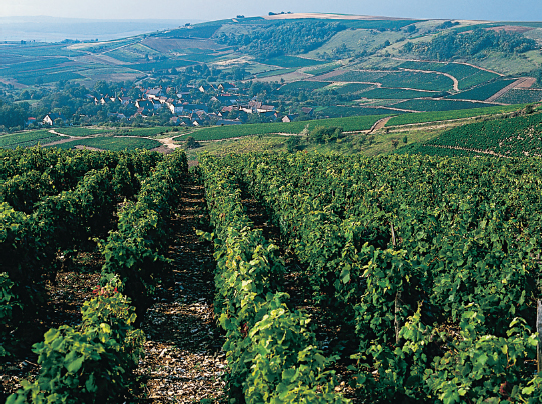
Vineyards in the rolling hills above Bué and Venoize in the Sancerre appellation in the eastern Loire Valley. There are 14 different communes in the appellation, so wine styles are necessarily heterogeneous. In fact, the much-vaunted differences between Sancerre and Pouilly-Fumé are far less than the differences to be found within the Sancerre appellation, with its varying soil types and its hills that rise to 400m (1320ft).
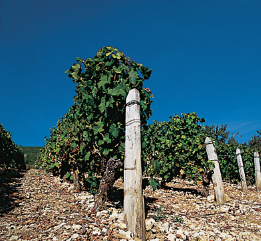
Pale chalky soils – these are at Bué – are crucial to the freshness and minerality of the best Sancerres, and their alkaline nature gives finely balanced, sharply focused flavours.
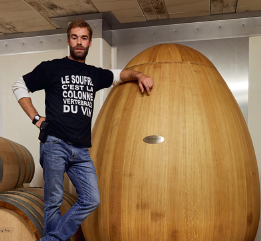
The late Didier Dagueneau was always the Pouilly-Fumé producer most determined to push the boundaries. Here his son Benjamin shows off his new egg-shaped oak fermenter.
VITICULTURE AND VINIFICATION
The ideal style of Sauvignon Blanc seems to be up for grabs at the moment. There are far fewer really raw, green, underripe flavours around. The good greenness you’ll find is that of nettles, blackcurrant leaves, lime zest and green apple skins – thrillingly refreshing, when you can find it. But there is a trend to greater ripeness, and that brings a risk of low acidity which some producers correct by throwing buckets of tartaric acid into the vat. It sort of works – but you can taste the acidity separately if they’ve been too enthusiastic. Overripe Sauvignon goes oily, sweaty and over-rich, which is even less nice. So warmer regions just don’t suit it. Many producers in Australia, New Zealand and South Africa deal with the problem by picking at different levels of ripeness – some underripe, some perfectly ripe, and some overripe. Done cleverly, this can produce palate-tingling wines of seamless balance. But why not plant the vines in a cool but sunny spot in the first place?
Climate
To get that too-often-elusive balance between sugar ripeness, acidity and aroma, the right climate is crucial. Once you’ve got it then the soil can certainly influence the flavour of Sauvignon; but the climate must be the first priority for anyone thinking of planting Sauvignon Blanc.
It’s both a late budder and an early ripener: it doesn’t therefore need enormous heat. In France it flourishes in both the maritime climate of Bordeaux and the more continental climate of Sancerre in the Loire Valley; New Zealand’s climates, too, are maritime. Slow ripening gives better flavour development, but optimum aroma occurs just before optimum sugar ripeness. This is important. The greatest intensity of aroma is found just before the ideal balance of sugar and acidity; choosing the picking date means a slight compromise in one direction or the other. Ideally, it should, of course, be as slight as possible. Part of the improvement in quality in Sancerre in recent years has been produced by better-judged picking dates; and while logically these should be later, since the wines clearly taste riper, better balanced and more interesting than they did, most growers, when questioned, claim they pick earlier. Global warming, they say, has advanced the maturity of the grapes. I’d say awareness of the success of Sauvignon from New Zealand’s South Island is an equally likely answer.
In New Zealand, different systems of canopy management have been aimed at producing riper grapes in a cool but sunny climate and with soils of high potential vigour. Fatter, more tropical wines have become common, but with raised levels, too, of residual sugar. There’s a bit of a battle going on between the green, zesty champions and the tropical fruit boys. Since New Zealand set a world standard for tangy, citrus styles that other wine countries desperately try to copy, the move to a fatter, riper, indeed sometimes sweaty style is bonkers.
In warmer climates growers generally pick early to keep acidity in their grapes, but in so doing seldom get the best aromas. California is a classic example: few of its Sauvignon Blanc wines have any character, so much so that the belief that Americans don’t like Sauvignon Blanc becomes a self-fulfilling prophecy.
In Chile, many winemakers pick Sauvignon Blanc at several different times: unripe for grapes with high malic acid; riper for red and green pepper flavours; at perfect ripeness, and at overripeness. Where did they learn such habits? Why, the South Island of New Zealand, and as some New Zealand producers try to soften up their wines they should remember the original, brilliant formula.
Soil
The question of soil and Sauvignon Blanc is really confined to France, with a glance at New Zealand; no other countries pay such attention to the issue.
In the Loire Valley soils in Sancerre and neighbouring Pouilly vary from chalk over Kimmeridgean marl – this produces the best balanced wines, with richness and complexity – to the compact chalk, or caillotte, found at the base of the hills – this gives finesse and perfume – to flint, or silex, which gives wines with a certain gunflint sparkiness and vigour. There are also warm terraces of sandy or gravelly soil near the river which give spicy, floral flavours to wines which are the earliest maturing of all. Marl gives wines that age better, but the longest-lasting wines come from silex.
In Bordeaux the soils usually allotted to Sauvignon are more alluvial and produce high yields, which accounts for the lesser pungency of the wine here.
In New Zealand’s Marlborough region the soils are particularly varied. Stony or sandy soils over shingle with poor fertility and good drainage compete with heavier, fertile clays and fertile silt. All produce good but different styles of Sauvignon. Further south in the Awatere Valley a mixture of silt loams, gravels and sands produce exciting results, and there is even limestone in the Ure Valley.
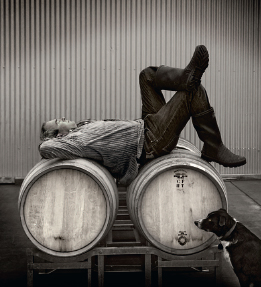
Kevin Judd was the original winemaker at mould-breaking Cloudy Bay in Marlborough, New Zealand, whose startling Sauvignon Blanc changed our wine world for ever. Now he has a new winery, Greywacke, also in Marlborough. Here he is taking a bit of a nap on some old barrels containing Wild Sauvignon. The dog looks thirsty.
In the Sauvignon Blanc heartland of the flood plain of the Wairau Valley soil types, both fertile and infertile, run in bands that go from east to west. This means that if vines are planted from north to south, then a single row can contain vigorous, late-ripening vines with large canopies and weaker, early-ripening ones with small canopies. Interestingly, this mix of weak and strong, of tropical and citrus, unripe and ripe, can produce really interesting, pungent stuff. The heavier soils tend to be later ripening, and give more herbaceous flavours; stony soils are warmer and thus earlier ripening, and give riper, lusher flavours. Mix them cleverly and you’ve got pungency plus ripeness.
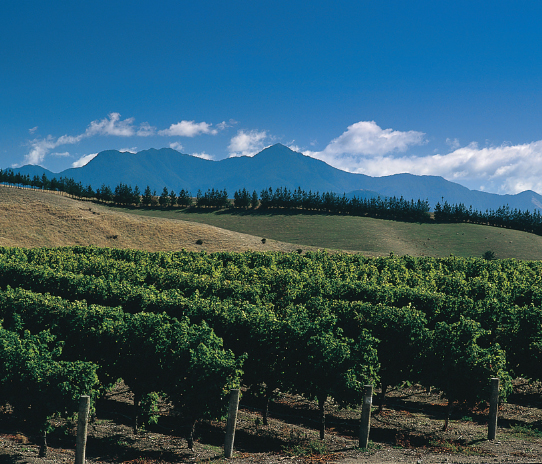
Sauvignon Blanc vines at Montana’s Brancott Estate near Blenheim, Marlborough – the original Sauvignon vineyard in the South Island. Blenheim usually gets more sunshine hours than any other town in New Zealand, thanks to the Southern Alps, which provide a handy rain shadow. Yet it’s still quite cool in viticultural terms, so Sauvignon Blanc doesn’t race to overripeness and flabbiness.
Yields
If what you’re after with Sauvignon Blanc is aromatic, crisp, fresh wine for early drinking, then yields are not an enormous problem. The maximum yield in Sancerre is 68hl/ha, including the plafond limite de classement, by which growers are allowed an increase in yield in prolific years, and actually Sauvignon Blanc tolerates these sort of levels reasonably well. If you want more serious, fatter, weightier wines, ones that will last and improve for several years, then 50hl/ha is enough. At 40hl/ha the wine may well be very serious, with extract and staying power, but it will not be most people’s idea of Sancerre. Yields are lower than this at good Graves and Pessac-Léognan estates in Bordeaux: under 40hl/ha at a few estates, notably Château Pape-Clément, but more usually between 40hl/ha and 55hl/ha. Since most top Bordeaux whites are barrel-fermented, these lower yields are crucial for a deep, balanced, ageworthy wine.
In the New World yields are higher again: at least six tons per acre (108hl/ha) in California, and around 8–12 tonnes per hectare (58–87hl/ha) even in Chile’s relatively low-yielding Casablanca Valley. In the Central Valley yields can top 15 tonnes per hectare (109hl/ha).
At the winery
Fermentation temperatures are a major point of difference between producing Sauvignon in the Loire Valley and the New World. In the Loire, fermentation (either in steel or wood) is at 16–18°C (61–64°F), in order to avoid the tropical fruit aromas that the New World seeks with its cooler temperatures. These relatively warm fermentations produce wines that are minerally rather than exuberantly fruity: Loire winemakers prefer their wines to reflect their terroir rather than the grape variety.
Denis Dubourdieu, Professor of Enology at Bordeaux University and high priest of Sauvignon, whose work has lifted Bordeaux Sauvignon to a level inconceivable 20 years ago, points out that it is the peaks of temperature during barrel fermentation – these peaks can touch 25°C (77°F) – which give richness and varietal aroma to the wine. Fermentation in stainless steel, with tightly controlled temperatures, gives wines with fewer terroir characteristics but the potential for explosive varietal fruit.
But there are far more ways of tinkering with Sauvignon in the winery than merely adjusting fermentation temperatures. Pre-fermentation skin contact is used by some producers for more expressive fruit flavours.
When South Island New Zealand Sauvignon Blanc first hurled itself on to our unsuspecting palate with thrilling flavours of gooseberry, green pepper, asparagus and passionfruit, one reason for the wine’s intensity was an unavoidable period of skin contact. Why? Well: there were no wineries at the time in the whole of South Island and grapes had to travel by truck and ferry all the way to Auckland up through North Island. At the height of harvest time that could mean grapes and juice sloshing around together for up to 24 hours. A wine of particular pungency could always be blamed on a traffic jam at the ferry.
The gooseberry/green pepper/lime zest flavours come from a group of flavour compounds called methoxypyrazines, which can be created, even in warmer areas, by shading the grapes from the sun. Many producers now eschew methoxypyrazines in favour of the more tropical-tasting, lusher thiols, but these carry with them an ever-present threat of armpit sweat. A skilful viticulturalist will try to balance the canopy shading to maximize the good points of both.
Aging on the fine lees works well: the lees protect against oxidation, and if the wine is in barrel they prevent it from becoming too oaky. Bâtonnage is used to increase weight; there is even some malolactic fermentation and new oak creeping into the Loire, though the style is atypical and I don’t find the addition of creaminess and the reduction in tangy acidity that malolactic brings to be a particularly attractive objective. New oak is more usually thought of as belonging to Bordeaux and the New World: the term Fumé Blanc, which has no legal meaning, may be applied to New World Sauvignons (or indeed wines from other white grapes) with new oak aging. Most of the examples come from California where the term originated. I suppose the idea for the name came from Pouilly-Blanc Fumé in the Loire, but the flavours of these wines have nothing whatever to do with traditional Loire Sauvignon Blanc.
SAUVIGNON BLANC AROUND THE WORLD
Frankly, I generally prefer my Sauvignon Blanc as a pure thrilling blast of all the grape has to offer – unashamed, unblended, love it or loathe it. But some faint hearts prefer to temper the wine’s fierceness by blending – and Sémillon is usually the grape of choice. Indeed, in Pessac-Léognan, even I actually prefer the Sémillon-Sauvignon Blanc blend.
France: Loire Valley
The finest appellations here for Sauvignon Blanc are Sancerre and its neighbour, Pouilly-Fumé; and in spite of the tradition that Pouilly-Fumé is marked by a characteristic whiff of gunflint, the difference between the two wines is less than differences found between Sancerre’s different soils and villages. The ‘Fumé’ was appended to Pouilly to distinguish the area’s Sauvignon from its Chasselas, which has the AC of Pouilly-sur-Loire.
At the moment Sancerre is a more go-ahead AC than Pouilly-Fumé. The older style of grassy, gooseberryish fruit is being replaced by richer, more peach and melon notes. The growers of the Loire have certainly been spurred into doing better by the success of New Zealand’s South Island. New Zealand Sauvignon is not made in a style they admire. They want to achieve something different. Hmm. That’s fair enough. But I would suggest that their first step towards making the best wine they can might be to respect New Zealand’s brilliance, rather than turn their noses up at it.
Lesser, but cheaper, and attractive, distinctive wines are produced nearby in Quincy, Reuilly and Menetou-Salon. These are snappy, fresh wines, but lack the depth of a good Sancerre or Pouilly-Fumé: Quincy is the most intense and gooseberryish; Reuilly and Menetou-Salon have some of the Sancerre snap and nettly tang; Touraine Sauvignon is satisfyingly green and crunchy.
France: Bordeaux
Denis Dubourdieu, Professor of Enology at Bordeaux university and highly respected enologist, has been the greatest single influence behind the enormous improvement in quality of Sauvignon Blanc at all levels. Winemaking, viticulture and clones have all improved, particularly in the last 10 years; even basic Bordeaux Blanc (which may be 100 per cent Sauvignon or Sémillon, or a blend of Sauvignon and Sémillon with or without a little Muscadelle) is now pretty reliably fresh. The scented dry white wines of the Graves and Pessac-Léognan are often fermented and aged in new oak.
In the sweet wine appellations of Sauternes, Barsac, Loupiac, Cérons, Cadillac and Ste-Croix-du-Mont, the proportion of Sauvignon Blanc in the vineyards varies between 10 and 40 per cent. Its thin skin makes it highly susceptible to botrytis, and its acidity adds freshness to the blend.
Rest of France
Sauvignon Blanc is widely planted throughout the southwest, and is particularly successful in Gascony and the Dordogne. In the Languedoc it is fairly popular for IGP wines, usually made in a slightly fat, fruity style. However, the warm climate and high yields combine to make it difficult to produce tangy Sauvignon with Loire-style aroma and freshness though there are one or two standouts. Burgundy has one tiny outpost at St-Bris near Chablis.
Rest of Europe
Spain’s most notable Sauvignon Blanc comes from the Rueda DO in Castilla y León, where it was introduced in the early 1980s. Styles are ripe, but the peachy fruit is balanced by a nettly acidity, usually achieved by picking the grapes as early as August. Some new oak may be used. It is also an authorized variety for the La Mancha and Rioja DOs.
Austrian versions of Sauvignon Blanc often have classic nettly, blackcurrant-leaves fruit, and restrained, understated, often excellent wines come from the Sudsteiermark region.
It is not known when Sauvignon Blanc was first planted in Italy, but it seems, in its early days at least, to have been grown alongside Sauvignonasse. Its first port of call was in Piedmont, although such Sauvignon Blanc as is made there today (there isn’t much, and Gaja’s is the best) was planted in the 1980s and 1990s. It is a grape of the Italian North and produces its most typical varietal aromas further east, in Collio, Friuli and Alto Adige. Italian producers may make Sauvignon as a varietal, or they may blend it with anything and everything: Chardonnay, Müller-Thurgau, Ribolla, Picolit, Vermentino, Inzolia, Tocai, Malvazia Istriana, Pinot Bianco and Erbamatt (a very rare white from Lake Garda).
The grape has potential for good quality in central and eastern Europe; there are large plantings in Romania and Moldova; the Czech Republic, Slovenia and, especially, Hungary are making appetizing wines.
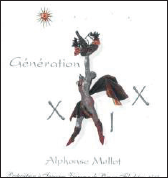
Alphonse Mellot
Wine from 87-year-old vines in the La Moussière vineyard, fermented and aged in 900-litre vats to mark the 19th generation of winemaking Mellots.
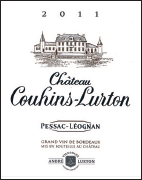
Château Couhins-Lurton
This property produces a wonderfully rich and intense barrel-fermented Sauvignon Blanc which, unlike most Pessac-Léognan wines, contains no Sémillon.
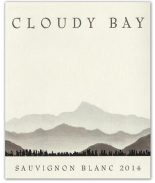
Cloudy Bay
The most famous New Zealand Sauvignon Blanc of them all, Cloudy Bay achieved instant cult status with its first vintage in 1985.
New Zealand
The first Sauvignon Blanc was not planted in Marlborough, in the South Island, until the 1970s, when Montana made the inspired decision to plant a trial plot. The main attraction of this then little-known region was its cheapness, and its possible suitability for Müller-Thurgau, then a far more important vine in New Zealand. Montana’s first Marlborough Sauvignon was made in 1980; it is now the leading region for the grape. The typical Marlborough style of Sauvignon Blanc – the climate is cool, dry and sunny – is distinctly tangy and citrussy, though some producers now seek more tropical fruit. The Awatere subzone to the south produces Marlborough’s sharpest, most mouthwatering Sauvignons, lime zest fresh with tomato leaf and green capsicum crunch. Elsewhere in the South Island, Nelson’s wines are softer, but citrous and Central Otago’s are bitingly fresh. In the North Island, Hawkes Bay wines are mellow and some Wairarapa examples are tangy and earthy.
Chile and South America
Much of Chile’s original Sauvignon Blanc is in fact Sauvignonasse, though just how much is not clear: a distinction between the two varieties was made in the early 1990s. Plantings after about 1995 are of Sauvignon Blanc proper. The leading region though not the largest, is the cool Casablanca Valley, where plantings began in about 1990, but far more is planted further south in the Central Valley in much hotter conditions. Casablanca, with its Mediterranean climate, has similar daily temperature variation to Marlborough. The new regions, where everybody is scrambling to find land and grapes, are nearby San Antonio and Leyda, Limarí, coastal Aconcagua and several other new, chilly coastal locations, as well as Bío-Bío and further south. The wines are light and crisp but intense, with flavours ranging from gooseberry, mint and tomato leaf to light green melon and crunchy apple flesh and greengage plums. Sauvignon Blanc is also found in Mexico, Argentina, Uruguay and Bolivia. In Brazil, according to Galet, the vine called Sauvignon Blanc is really Seyval Blanc.
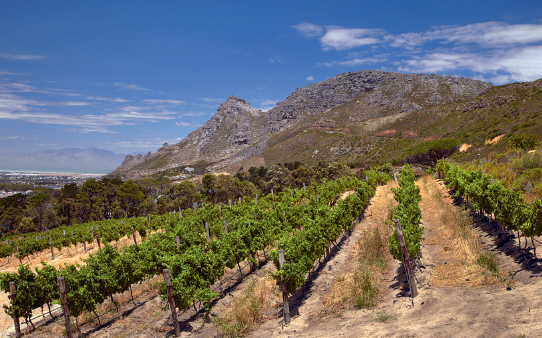
Wine was first made at Steenberg in Constantia in 1695. Vines were replanted in the 1990s as it became clear that the vineyards were ideally suited to cool climate varieties, with False Bay (seen in the distance) chilling the air and slowing ripeness. These vines produce one of South Africa’s best Sauvignon Blancs.
Australia
Australia isn’t a Sauvignon paradise. There are good examples from Adelaide Hills, Padthaway, Orange and Tasmania, and Margaret River, in Western Australia, makes some excellent blends with Semillon. But on the whole one has to wonder if Australia is really suited to it. Most wines are simple and may taste slightly confected.
USA
Sauvignon Blanc is widely planted in California and even though it is now the third most planted white grape, it still lies way behind Chardonnay and French Colombard. Oaked versions of the wine often use the name Fumé Blanc. There is some in Washington State and Oregon, but acreage is declining. It is also planted on Long Island, New York State, and in Virginia.
South Africa
Vivid flavours of nettles, herbs, lime zest and gooseberries are common here. In the last decade, South Africa has become one of the world’s most stylish Sauvignon producers, by making a considerable effort in identifying numerous different sites which give a variety of fascinating flavours, sometimes green but gentle, sometimes really crunchy. The West Coast north of Durbanville, and the far south near Cape Aghulas, produce the tangier styles, but the gentler delights come from Elgin, Constantia, Robertson and Stellenbosch.
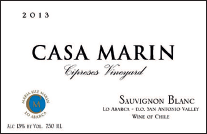
Casa Marin
Chile has outstanding growing conditions for Sauvignon near the coast, where stiff Pacific breezes keep temperatures down and freshness up.
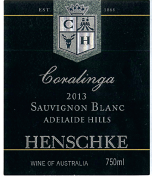
Henschke
Henschke are better known for their profound Shiraz reds, but they also take advantage of the cool Adelaide Hills to produce crisp Sauvignon.
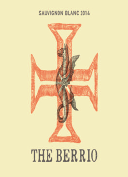
The Berrio
Wonderfully snappy Sauvignon from Elim, on the tip of Africa, where breezes from the Antarctic Benguela Current provide chilly conditions.
ENJOYING SAUVIGNON BLANC
Generally speaking, Sauvignon Blanc is not a wine made to last. Its attraction is its youthful freshness and zest, and the fact that it can be drunk immediately, in the spring following the harvest. Most Sauvignon Blancs, if kept longer than a couple of years, fade rapidly and lose their aroma.
Those that will improve in bottle come not just from particular areas but from particular growers who take a decision to make a wine for keeping. This means, first and foremost, restricting yields: serious, ageworthy wines do not come from the same generous crops as light, early-drinking ones.
The best Marlborough Sauvignon Blancs intensify their flavours for between five and 10 years, depending on the vintage. Top Sancerres and Pouilly-Fumés can develop in bottle for five to eight years, developing flavours of honey and toast to replace those of nettly fruit, but always keeping a mineral streak; top white Graves and Pessac-Léognan change dramatically with age. They often start out with nettly acidity, bright nectarine fruit and gentle custardy oak and change over 10 to 15 years to magnificently deep nutty, creamy wines. Domaine de Chevalier, Smith-Haut-Lafitte, Malartic-Lagravière, Haut-Brion and Laville-Haut-Brion can last even longer, and may well stay in excellent shape for 20 years or even longer.
Sweet wines are made from blends of Sauvignon and Sémillon in Sauternes and Barsac, and sometimes from pure Sauvignon in California and New Zealand. Classed growth Sauternes reach maturity after a decade or so, but are nevertheless delicious younger; California and New Zealand sweet versions vary in their ageability, but most will improve for up to five years. Top Australian examples are beautiful at two to three years, but should age for a decade or so.
The taste of Sauvignon Blanc
When I’m trying to describe why I absolutely love the flavour of Sauvignon Blanc, I have to accept it’s one of those grapes some wine people simply can’t stand. That’s okay. They don’t have to drink it. All I ask is that they don’t try to change it into something bland and soft or they’ll find me challenging them to a furious fistfight. I love its taste of gooseberries, its taste of green peppers sliced with a silver knife, passion fruit and kiwi scattered with lime zest, nettles crushed up with blackcurrant leaves. These are the kind of flavours that make Sauvignon for me irresistibly refreshing.
If you like riper tastes, well, Sauvignon develops a spectrum of white peach, nectarine and melon masking any excess acidity; wines with a touch of botrytis may have a whiff of apricot. Sancerre and Pouilly-Fumé often have a minerally streak, particularly if they are grown on flinty silex soil: generally clay gives more richness, chalk lightness and perfume.
Lower fermentation temperatures produce a range of tropical fruit flavours: pineapple, banana and guava – dangerous unless balanced by good acidity.
New oak aging will give the wines a vanilla sheen; malolactic fermentation may add butter to the palate. With bottle age Sauvignon takes on tastes of honey and toast and quince, less obviously fruity, but rich and complex.
Botrytized sweet wines have flavours of pineapple and marzipan, oranges and apricots, with often piercing acidity to cut through the richness.
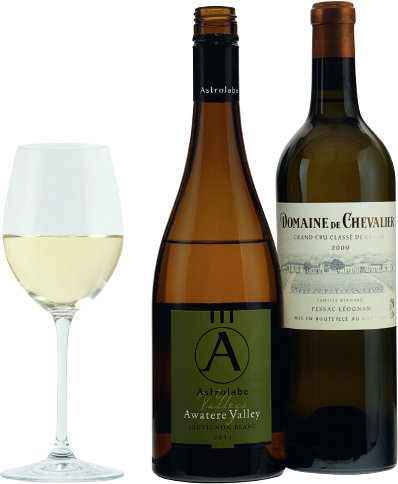
Although Sauvignon Blanc originates in Western France, its modern fame rests squarely on New Zealand’s shoulders. New Zealand Sauvignon hit the world in the 1980s with tingling, mouthwatering green fruit and a citrussy attack that virtually ushered in an entire new era of modern white wine. Astrolabe continue the tradition in the coolest part of Marlborough on the South Island – Awatere Valley, dry, challenging and open to the cold southern winds. Domaine de Chevalier makes one of France’s classier, barrel-fermented whites by blending 30% Semillon in with the Sauvignon Blanc – a practice also copied in other parts of the world like California, South Africa, Western Australia and New Zealand.
MATCHING SAUVIGNON BLANC AND FOOD
This grape makes wines with enough bite and sharpness to accompany quite rich fish dishes as well as being an obvious choice for seafood and for Thai dishes. The characteristic acid intensity makes a brilliant match with dishes made with tomato, but the best match of all is white Sancerre or Pouilly-Fumé with the local sharp crottin goats’ cheese of the Upper Loire Valley. With their strong, gooseberry-fresh taste, Sauvignons make good thirst-quenching apéritifs.
CONSUMER INFORMATION
Synonyms & local names
Sometimes called Blanc Fumé in the central Loire; there are variations called Jaune, Noir, Rose or Gris and Violet according to the berry colour; it is called Muskat-Silvaner or Muskat-Sylvaner in Germany and Austria (though Steiermark often uses the name Sauvignon Blanc); oaked versions are also known as Fumé Blanc in California and Australia. The variety Sauvignon Vert or Sauvignonasse is unrelated.
Best producers
FRANCE/Pouilly-Fumé J-C Chatelain, Didier Dagueneau, Ladoucette, Masson-Blondelet, de Tracy; Sancerre G Boulay, H Bourgeois, F Cotat, F Crochet, Alphonse Mellot, Vacheron; Bordeaux/Pessac-Léognan Brown, Dom. de Chevalier, Couhins-Lurton, Fieuzal, Haut-Brion, la Louvière, Malartic-Lagravière, Smith-Haut-Lafitte; Graves Clos Floridène.
ITALY Colterenzio co-op, Peter Dipoli, Edi Kante, Lageder, Vie di Romans, Villa Russiz.
AUSTRIA Gross, Lackner-Tinnacher, Neumeister, Polz, E Sabathi, Sattlerhof, E & M Tement.
SPAIN Hermanos Lurton, Palacio de Bornos, Marqués de Riscal, Javier Sanz, Sitios de Bodega, Torres.
USA/California Araujo, Brander, Coquerel, Dry Creek, Flora Springs, Grgich Hills, Heitz, Honig, Kenwood, Mondavi, St Supery, Spottswoode.
AUSTRALIA Angullong, Bannockburn, Bird in Hand, Brookland Valley, Larry Cherubino, De Bortoli, Hanging Rock, Houghton, Karribindi, Katnook, Lenton Brae, Logan, Longview, Nepenthe, S C Pannell, Philip Shaw, Shaw & Smith, Stella Bella, Tamar Ridge, Word of Mouth.
NEW ZEALAND Astrolabe, Blind River, Brancott, Cloudy Bay, Dog Point, Gladstone, Greywacke, Lawson’s Dry Hills, Man O’War, Matua Valley, Neudorf, Palliser, Pegasus Bay, Sacred Hill, Saint Clair, Stoneleigh, Te Kairanga, Te Mata, TerraVin, Vavasour, Villa Maria, Yealands.
CHILE Casa Marín, Casas del Bosque, Concha y Toro, Cono Sur (20 Barrels), Errázuriz, O Fournier, Viña Leyda, Luis Felipe Edwards, Montes, San Pedro (Castillo de Molina), Santa Rita (Floresta), Undurraga.
SOUTH AFRICA Graham Beck, Cape Point, Cedarberg Ghost Corner, Constantia Glen, Neil Ellis, Flagstone, Fleur du Cap, Fryer’s Cove, Hermanuspietersfontein, Iona, Klein Constantia, Mulderbosch, Oak Valley, Quoin Rock, Springfield, Steenberg, Thelema, Vergelegen.
RECOMMENDED WINES TO TRY
Ten New Zealand Sauvignon wines
Astrolabe Marlborough
Blind River Marlborough
Cloudy Bay Marlborough
Dog Point Marlborough
Te Kairanga Wairarapa
Greywacke Marlborough
Saint Clair Marlborough
Vavasour Marlborough Single Vineyard
Villa Maria Marlborough Clifford Bay Reserve
Yealands Marlborough
Five classic Loire Sauvignon wines
J-C Chatelain Pouilly-Fumé
Francis & Paul Cotat Sancerre Chavignol la Grande Côte
Lucien Crochet Sancerre Cuvée Prestige
Didier Dagueneau Pouilly-Fumé Pur Sang
Alphonse Mellot Sancerre Cuvée Edmond
Eight classic Sauvignon-dominated dry white Bordeaux wines
Ch. Brown Pessac-Léognan
Domaine de Chevalier Pessac-Léognan
Ch. Couhins-Lurton Pessac-Léognan
Ch. la Louvière Pessac-Léognan
Ch. Malartic-Lagravière Pessac-Léognan
Ch. Margaux Bordeaux Pavillon Blanc
Ch. Pape-Clément Pessac-Léognan
Ch. Smith-Haut-Lafitte Pessac-Léognan
Eleven other New World Sauvignon wines
Casa Marín Cipreses (Chile)
Cederberg Ghost Corner Sauvignon Blanc (South Africa)
Concha y Toro Terrunyo (Chile)
Errázuriz Aconcagua Coastal (Chile)
O Fournier Centauri (Chile)
Luis Felipe Edwards Marea de Leyda (Chile)
Montes Outer Limits (Chile)
Viña Leyda Sauvignon Blanc (Garuma) (Chile)
Shaw & Smith Sauvignon Blanc (Australia)
Steenberg Black Swan (South Africa)
Vergelegen Sauvignon Blanc (South Africa)
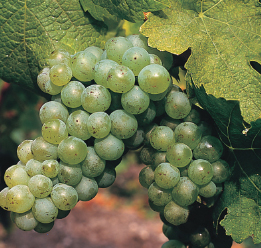
The exciting thing about Sauvignon Blanc is its wonderful, unabashed fruit salad bowlful of flavours, all tumbling over one another. These tastes are most obvious when the wine is young, but, especially when barrel-fermented and blended with Sémillon, Sauvignon can produce deep, complex, long-lasting wines.
Maturity charts
Sauvignon is usually made for early drinking, though some Sancerres and Pouilly-Fumés will keep and improve for much longer.
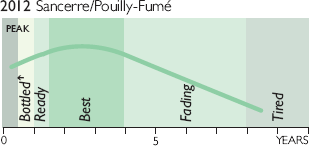
A few producers make Sancerre that will age in bottle, but generally it is a light, fresh wine intended for early drinking.
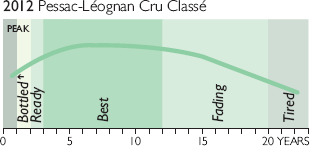
Recent vintages, even of slow developers like Dom. de Chevalier, are brilliant young, but also age beautifully.
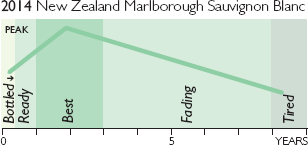
A couple of years in bottle is generally enough for even the top wines; more everyday bottles are best drunk within the year of the vintage.
SAUVIGNONASSE 
It was only in the early 1990s that a distinction was made in Chilean vineyards between Sauvignon Blanc, which was what producers thought they had, and Sauvignonasse, which was what they actually did have much of the time. The two varieties look similar: it is an easy mistake to make. And since the original cuttings of ‘Sauvignon Blanc’ that populated Chile’s vineyards came from Bordeaux in the 19th century, the Chilean field mix merely reflected the 19th century Bordelais field mix.
Sauvignonasse is also known as Sauvignon Vert, but unlike Sauvignon Gris (also found in small amounts in Chile) it is not a mutation of the more pungent Sauvignon Blanc. Sauvignonasse did share the vineyards of Bordeaux with Sauvignon Blanc, but it lacks the assertive nose, the acidity and the staying power of the latter. Until it’s about three months old it can have quite good aroma and flavour, but it is an aroma of green apples rather than the blackcurrant leaf and gooseberries of Sauvignon Blanc. It has little character if picked underripe, and reaches high levels of alcohol – up to 14.5 per cent – very easily. Acidity, however, drops rapidly, and at more than 13 per cent alcohol the wine can taste dull and featureless.
It’s not clear just how much Sauvignonasse lingers in Chilean vineyards – the authorities recognize only Sauvignon Blanc, so that’s how it appears in the records – but it may be as little as 200ha (500 acres). New plantings in the north and on the coast are all Sauvignon Blanc.
Sauvignonasse used to be known as Tocai Friulano in Italy, where it was imported in the 19th century, but its official name now is simply Friulano to prevent confusion with Hungary’s Tokaji. It would be interesting to see if Chile could produce versions as impressive as those of the best growers of Collio and Colli Orientali del Friuli by dramatically lowering yields and taking their winemaking a little more seriously. See also Sauvignon Blanc here.
SAUVIGNON GRIS 
An alternative name for Sauvignon Rosé, which is a pink-skinned version of Sauvignon Blanc (see here). It is much less aromatic than Sauvignon Blanc, but makes powerful, rather interesting wines. Chile has some, as does Bordeaux: Château Smith-Haut-Lafitte in Pessac-Léognan, for example, sometimes adds around 5 per cent Sauvignon Gris to its dry white which is otherwise entirely Sauvignon Blanc. Best producers: (France) Carsin, Courteillac, la Ragotière.
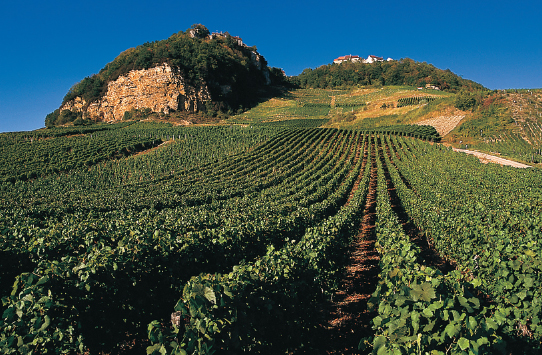
Savagnin vines growing on the limestone and marl soils of the Château Chalon appellation, in the Jura region of eastern France. The Vin Jaune from here is one of the very few flor-growing wines in the world. I’m not convinced that it’s as good as good sherry, but I’m beginning to understand its hidden charms.
SAUVIGNON VERT 
An alternative name for Sauvignonasse and its official title in Chile.
SAVAGNIN 
A very old variety that probably comes from northeast France (where its main stronghold is still the Jura) or southern Germany. There is a possibility that it is directly descended from wild vines; but on the other hand, Pinot might be one of its parents. The only thing that is certain is that Savagnin has an enormous number of mutations. Gewürztraminer, Traminer and Heida (Païen) are all, in fact, Savagnin, even though all are discussed separately in this book. And they are very different.
For Savagnin Rose and its aromatic form Gewürztraminer, see Gewürztraminer here. Here we’ll look at Savagnin Blanc, which seems to be its earliest form.
Savagnin is found in the Jura region, and is best known for the local speciality Vin Jaune, though it also makes straight table wines of startling structure, pungency and minerality. For Vin Jaune, the Savagnin ripens late, being picked at 13 to 15 per cent potential alcohol in November or even December. The flor-like yeast covering, here called voile or veil, grows more slowly and more thinly than the flor of Jerez (see Palomino Fino here), and dies earlier. There is no solera system used in the Jura; in Jerez and the other sherry towns it is the constant refreshing of wine in solera that keeps the flor alive. In addition, the much cooler temperatures of the Jura do not encourage such lavish growth. The wine is left in cask for six years and three months, by the end of which time it has developed a pungent, oxidized, nutty flavour with piercing acidity. Once bottled it is said to be able to last 50 years or more. I’m still keeping my one bottle.
Savagnin is grown throughout the Jura region, and while it is a permitted addition to any white wine there, it is usually kept for Vin Jaune. To recap, there is also a Savagnin Rose which is the same as Traminer (see here). The musqué form of Savagnin Rose is the more aromatic Gewürztraminer (see here). Australia makes good examples tasting of green apple core and lemony acid, although the growers thought they were planting Albariño. In Switzerland, as Heida or Païen it is full-bodied and fairly spicy. It‘s a speciality of the Valais, and is grown high up (1100m/3610ft high up) in Visperterminen. Best producers: (France) Arlay, Jean Bourdy, Hubert Clavelin, Jean-Marie Courbet, Durand-Perron, l’Étoile, Henri Maire, Montbourgeau.
SAVAGNIN NOIR 
A name occasionally used in the Jura and parts of Switzerland for Pinot Noir (see here). It should not be confused with the local grape Savagnin (see left).
SAVATIANO 
Greece’s workhorse grape, usually neutral and low in acidity, and used for inexpensive branded wines and for retsina. More acidic grapes, especially Assyrtiko and Roditis, are often added to retsina to give balance. The pine resin is added in pieces to the must, and removed only when the wine is racked. If grown on good sites and picked slightly earlier, Savatiano can produce surprisingly well-structured wines. Best producers: (Greece) Achaia-Clauss, Kourtakis, Semeli Winery, Skouras, Strofilia.
SCHEUREBE 
Scheurebe was long thought to be a crossing of Riesling with Silvaner, aimed at finding an improved version of Riesling – or possibly a more perfumed version of Silvaner, depending on who you talked to. However, while one of its parents is certainly Riesling, the other is unknown.
Its wine lacks the taut elegance of good Riesling and even at its best tends to be clumsier, but it is complex and rich at high Prädikat levels, making powerful sweet wines with a fantastic flavour of ripe pink grapefruit swathed in honey which age quite well, though not for as long as equivalent Rieslings. It ripens to higher sugar levels, is high-yielding, and seems to produce its most exciting wines in the Pfalz. When made dry, there is a danger of catty, white grapefruit flavours if the grapes are underripe; Scheurebe like this can be raw and aggressive. It is, however, far and away the most successful of the modern German crossings, and the only one highly regarded by serious winemakers.
In Austria it is known as Sämling 88 (see here) – seedling number 88 was the seedling selected from all those propagated by Scheu in 1916. Best producers: (Germany) Andreas Laible, Lingenfelder, Müller-Catoir, Hans Wirsching, Wolff-Metternich; (Austria) Alois Kracher.
SCHIAVA 
This Italian red grape (or grapes, since the name covers several more or less similar but genetically different vines) produces perfectly pleasant everyday wines in Trentino-Alto Adige, but doesn’t seem capable of anything of real excitement. It yields generously, and gives wines of light smoky strawberry fruit and a mildly creamy texture. Concentration, depth and complexity, however, are generally lacking. It is declining as growers see the greater commercial opportunities of weightier reds, but still covers a substantial area.
Its Italian name means ‘little slave’ – the variety is very amenable, though its Süd-Tirol German name, Vernatsch, means ‘of local origin’, suggesting that it has long been thought of there as being a local variety. The name it is given in Germany itself, Trollinger, also suggests a link with the Tyrol. Records of the vine in Trentino-Alto Adige go back to the 13th century. (See Vernatsch here and Trollinger here.) The range of Schiavas includes Schiava Grigia, or Grauvernatsch; Schiava Gentile, or Edelvernatsch; and Schiava Grossa, or Grossvernatsch; and Schiava Lombarda. Schiava Grossa is the least distinguished, but particularly high yielding, so inevitably it is the most planted.
It is the main grape in DOC Santa Maddalena, where it may be given more character by Lagrein or some other red grape and I have to say I’ve had some really lovely gentle, fresh picnic wines sitting among the vines high above the city of Bolzano. It is also found in numerous other DOC and non-DOC wines in the area. Declining Schiava may be, but in the high mountains of Alto Adige in early summer, well, find me a more delightful red than one of these. Best producers: (Italy) Cornaiano co-op, Cortaccia co-op, Franz Gojer, Gries co-op, Lageder, Josephus Mayr, Thomas Mayr, Niedermayr, Georg Ramoser, Hans Rottensteiner, Heinrich Rottensteiner, San Michele Appiano co-op, Santa Maddalena co-op, Termeno co-op.
SCHIOPPETTINO 
A fairly characterful northeastern Italian variety recently rescued from terminal decline. It is native to Friuli, and is also known there as Ribolla Nera. Its flavour is peppery and raspberryish, fairly light in body and alcohol, and with high acidity. There is also a local young and fizzy version. Best producers: (Italy) Dorigo, Davide Moschioni, Petrussa, Ronchi di Cialla, Ronco del Gnemiz, La Viarte.
SCHÖNBURGER 
A German crossing (Pinot Noir with a crossing of Chasselas Rose and Muscat Hamburg) now more grown in England than in Germany, where it is concentrated in the Rheinhessen and Pfalz. It ripens easily, yields well and is disease-resistant. Its berries are pink but it is used for making white wine. Its perfume is heavy and somewhat Muscatty which is very attractive in a light English wine grown in England’s cool climate, but can be rather cloying in wine from warmer climes. Best producers: (Canada) Gehringer; (England) Carr Taylor, Danebury.
SCHWARZRIESLING 
The German name for Pinot Meunier (see here); it is found mostly in the Württemberg. region. Best producers: (Germany) Dautel, Drautz-Able, Fürst zu Hohenlohe-Öhringen, von Neipperg.
SCIACARELLO 
A grape once thought to be unique to Corsica but now revealed as the Tuscan Mammolo. However, since it’s probably been growing in Corsica since the 11th century, you can see why the Corsicans claimed it as their own. It is at its best in the southwest of the island, around Sartène and Ajaccio, and while its wines are light in colour and not particularly tannic, they have a lively herby pepperiness. With age they develop hints of woodsmoke and tobacco. The name means ‘the grape that bursts under the teeth’ and – guess what – the grapes have tough skins and lots of juice. Best producers: (France) Albertini Frères, Clos Capitoro, Clos Laudry, Martini, Peraldi, Torraccia.
SCUPPERNONG 
A vine found in the southwestern states of the USA and in Mexico, Scuppernong is a Vitis rotundifolia vine, and belongs to the genus Muscadinia. The thick-skinned berries grow in small clusters and are low in sugar; chaptalization is normal. Pressing can be difficult, too, because of the thick, fleshy pulp. The flavour is strong and musky and the wines are usually made sweet.
Virginia Dare, a North Carolina wine that enjoyed great popularity in the early years of the 20th century, was made from Scuppernong and named after the first child born in the American colonies to English settlers. It seems bizarre now, with the dominance of California as a USA grape grower, but, largely due to Scuppernong, North Carolina was, for a time in the 19th century, the USA’s most prolific grape grower, and Scuppernong is still the official state fruit.
SEIBEL 
A group of French hybrids produced by Albert Seibel (1844–1936). Seibel 4643, also known by the somewhat ambitious name of Roi des Noirs, used to be widely planted in western France, though is so no longer: its wine was rustic and dark. Other Seibels include 7053, otherwise known as Chancellor; and 5279, or Aurore, both early ripeners planted here and there in North America.

SÉMILLON
Sémillon: from Grape to Glass
Geography and History here; Viticulture and Vinification here; Sémillon around the World here; Enjoying Sémillon here
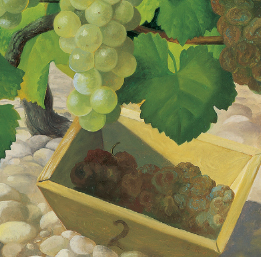
Seen here in the honeyed autumnal light evocative of its precious golden wine, Château d’Yquem is the supreme example of the majestic sweet wines of Sauternes. Pickers will go through the vineyards up to a dozen times during the harvest, picking only the most ‘nobly rotted’ grapes in a constant attempt to make the best sweet wine in the world.
You can’t say that Sémillon hasn’t been given a chance. Half the wine countries in the world have given it a chance, and almost as many have decided that it can’t seem to produce anything remotely interesting, so let’s rip most of it out again. That happened in South Africa – where it was very popular largely because Semillon rewarded the very favourable, benign vineyard conditions there with oceans of dull, tasteless juice that just happened to be fine for distilling into brandy if little else. Luckily brandy was what most South Africans drank at the time. Chile was overrun with it for much of the 20th century. Argentina and the rest of South America also gave it its head, and Sémillon thanked them by making wines that were a byword for dullness and which revelled in attracting sulphur like carrion attracts crows.
And, of course, there’s Bordeaux in southwest France. Bordeaux has the biggest plantings in the world, but even these are a fraction of what they used to be. Barely 50 years ago, half of Bordeaux’s production was white, mostly from the Sémillon grape. Now Bordeaux has 121,270ha (299,665 acres) of vines. Only 7021ha (17,350 acres) of these are Sémillon, and the most important of these are to the southeast of the city of Bordeaux, in Graves, Pessac–Léognan and Sauternes. And it’s here that Sémillon can excel, though not without help. In the first case, human intervention has discovered that if you ferment Sémillon in barrels it takes on a wonderful waxy, creamy quality. Blend it with Sauvignon, which adds crispness, leafiness, citrous tang, and you have memorable dry white wine, as good as white Burgundy. A few people round the world have succeeded with this formula, mostly in South Africa and Western Australia.
But it’s greatest triumph is due to nature’s helping hand. In the Sauternes region, nature creates perfect conditions for the grapes to rot in the vineyard. Now, rot is the curse of the red wine grower. Yet rot is the making of the crop in Sauternes. But not any old rot. Noble rot, so called because it concentrates the sugar in the grapes without turning the juice sour and undrinkable, needs very special conditions to flourish, and in Sauternes’ little patch of land it gets them. The local rivers Ciron and Garonne get very foggy in the autumn mornings. If that fog is compounded by rain, we’re in trouble. All kinds of rot will threaten, none of them noble. But if the sun fills the sky and burns off the morning fog, the whole vineyard becomes muggy and humid – and hot. And in these conditions noble rot sets to work thinning the skins of the Sémillon grape and intensifying the sugar to such an extent that memorable sweet wine is created.
There’s one other place where terrible weather has conspired to make great Semillon wine – Australia’s Hunter Valley, north of Sydney. Nature knows that no sane person would try to grow grapes there, and ever since the first magnificent obsessives decided to have a go in the 1830s nature has done her best to flout their efforts. She’s washed away the decent soils with a never-ending succession of tropical storms. She’s arranged subtropical heat during the summer, brackish bore water unfit for irrigation, and frequent winter droughts, just in case you were thinking you might build a few dams to store water to help your vines survive. And to make quite sure you got the message that grape-growing is doomed in the Hunter, she arranges cyclones to sweep down the coast and batter the valley just before the hapless grapes are ripe – just so you know who’s really in charge. And without me attempting to seek refuge in rhyme or reason, it is precisely these woeful conditions that have created the classic Hunter Valley Semillon.
In the occasional perfect summer, with the grapes fully ripe and the harvest safely in, Hunter Semillon is full and fat, a bit blowzy – good grog, but quick to flower and fade. But in the years when nature does her worst, when the grape’s alcohol level sometimes barely reaches 10 per cent alcohol, the result – if you wait 10 years for it to mature – is one of the world’s great classic whites. Unsurprisingly, completely unlike any other white wine in the world.
GEOGRAPHY AND HISTORY
Where has all the Sémillon gone? Look at the map and it’s just isolated patches: southwest France has the most, and there’s some in Australia, some in Chile and other South American countries, and a bit in South Africa.
Yet 50 years ago some three-quarters of Chile’s white vines were Semillon (it’s usually seen without the accent in New World winemaking countries). It smothered South Africa – in 1822 it covered 93 per cent of the vineyard area, and was referred to with perfect logic simply as Wyndruif, or wine grape.
Chile now has much less. South Africa has much, much less. First of all, Sémillon gave way to Chardonnay; now white grapes are in their turn giving way to red. And Sémillon, planted all over the world for its disease resistance and its ability to produce large quantities of grapes, might have had its day, were it not for two facts. One is that it produces outstanding sweet wine in Sauternes and Barsac on the left bank of the Garonne in Bordeaux. The other is that it produces outstanding dry wine in Australia’s Hunter Valley north of Sydney, and blended with Sauvignon, in Western Australia’s Margaret River, a few spots in South Africa, and, above all, in Pessac-Léognan and Graves, next door to Sauternes. And that’s just enough of a CV to keep Sémillon being planted around the world.
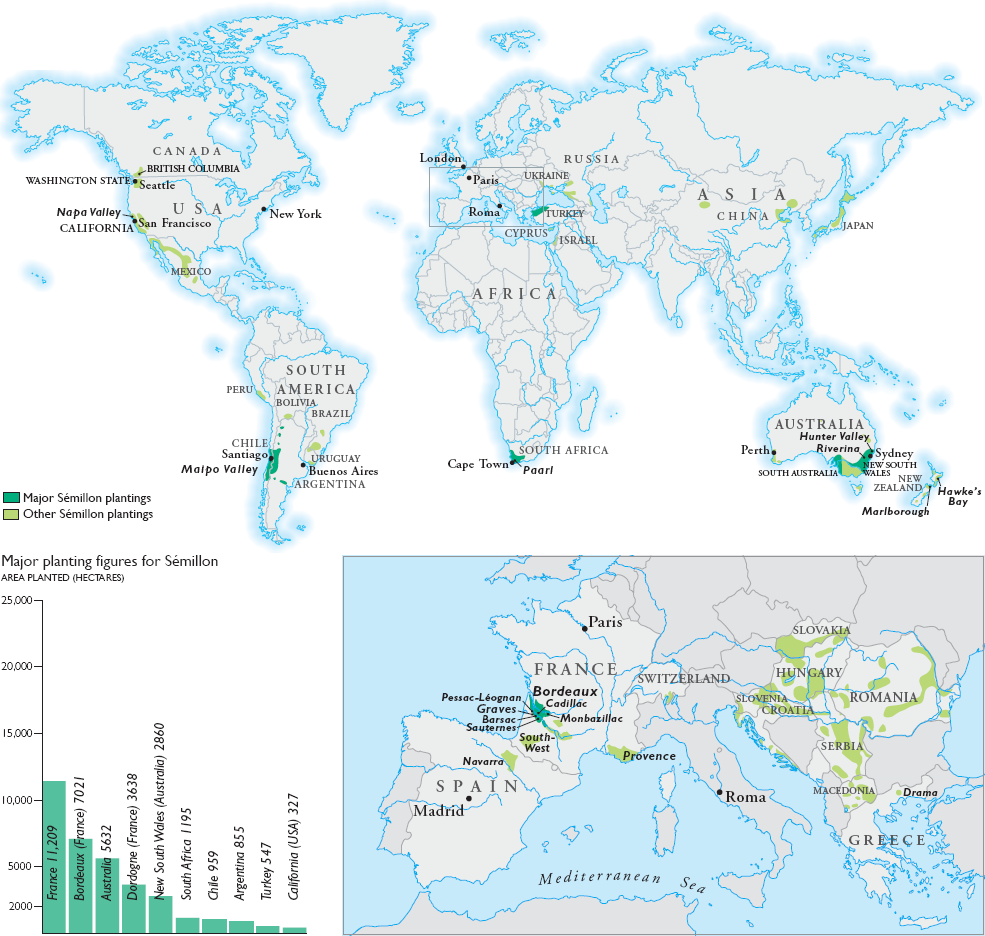
The thing is, Sémillon was planted as an all-purpose grape – you could make dry or sweet wine from it, sherry, brandy, whatever. Yet it isn’t an all-purpose grape. At high yields it is dilute and thin; when underripe it is green and stringy. Even its sweet wines usually need a touch of Sauvignon Blanc to brighten them up. And then, in misty, humid Sauternes and the subtropical Hunter Valley where the conditions are hardly suitable for grape growing at all, it produces world-class wine. So why does it make so few great wines in much easier conditions? Let’s have a look.
HISTORICAL BACKGROUND
The ampelographer Galet thinks that Sémillon probably originated in Sauternes and spread from there to the rest of the Gironde. It was found in St-Émilion by the 18th century, and indeed St-Émilion used to be one of its local synonyms; nowadays this is a synonym for the Ugni Blanc variety, which Sémillon does not remotely resemble. It was still planted in St-Émilion on a small scale, along with Sauvignon Blanc and Muscadelle, for white wines well into the 20th century, and even now there are a few fugitive vines there.
When was Sauternes first made sweet? The usual date given, for want of concrete evidence of an earlier date, is the mid-19th century. To suppose that it was not made sweet before, however, requires a suspension of disbelief: Tokaj had been famous for its botrytis-affected sweet wines since the late 17th century, so the technique of making sweet wines from botrytized grapes was well known; and Botrytis cinerea occurred in Sauternes and Barsac then just as it does now. Picking in the region in the 18th century was not until late November; in Cadillac – on the right bank of the Garonne – the Abbé Bellet, who kept records of every vintage from 1717 to 1736, confirms that by October the grapes were affected by noble rot, and were picked in selective tries. He does not confirm that only the rotten ones were used, but if the non-rotten ones had been the most desired, and had been picked in the first trie, it is hard to see the point of further pickings. Clearly the selective trips through the rows of vines were to pick out the grapes affected by noble rot. And he would have found it pretty hard to make ordinary dry wine from such grapes.
If you judged a grape solely on its appearance, it’s hard to see why anyone would make wine from ugly, squishy, noble-rotted grapes. But squeeze the gooey syrup from the grapes and lick your fingers and the fabulous rich flavour will persuade you in a flash.
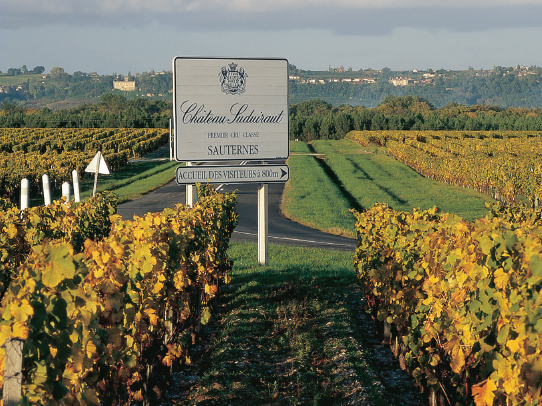
A golden autumn day at Château Suduiraut at Preignac in the Sauternes appellation. This is just the sort of weather that favours the development of noble rot: humid, foggy nights are essential, but if dampness persists throughout the day, the rot will turn grey and ignoble and there will be little chance of rich, sweet wine.
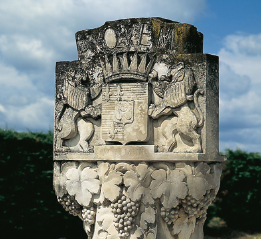
A carved coat of arms at Château d’Yquem, Sauternes. The Sauvage family owned d’Yquem until 1785, when the Lur-Saluces family acquired it. They held it until 1999, when it was bought by LVMH.
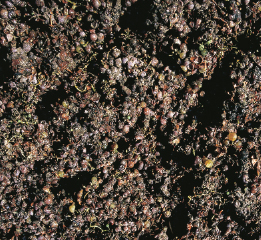
A gooey mess of nobly rotten Sémillon grapes. Grapes in this state may look hideous but they are highly desirable for their super-concentrated sugars. They are difficult to press and slow to ferment.
VITICULTURE AND VINIFICATION
I can see why Sémillon was such a popular variety in the old days. It will grow just about anywhere and will recklessly produce gigantic crops of grapes. Which taste of...? Er, nothing really. Just vatsful of juice of no discernible personality but enough sugar to ferment into whatever kind of concoction you fancy. From dry white to sweet, from sherry to brandy. But in one or two little corners of the globe, if you really restrict its crop and vinify it skilfully, it has for centuries produced world-class dry and sweet whites. It buds slightly later than Sauvignon Blanc but ripens earlier, and is actually less subject to noble rot than Sauvignon. It is resistant to most other diseases, but rainy years can produce attacks of grey rot. This is caused by the same fungus as noble rot, but has different, more harmful results – most importantly it tastes horrible.
Climate
It is an unarguable fact that if you were to match your vine varieties with your sites on a rigid degree-day basis you would never plant Semillon in the Hunter Valley. It is, by this reckoning, far too warm there to produce dry Semillon, and indeed far too humid, especially when the humidity takes the form of tropical downpours at harvest time. But Semillon thrives there, and even more curiously, it is rainy years that often produce the best Hunter Semillon, years which are so poor in accepted terms that the alcohol level hardly reaches 10 per cent. There’s got to be a reason. Up to a point, there is. So here’s the science. It still won’t all add up, because Hunter Semillon is one of the wine world’s great enigmas. But here goes.
That the region produces such good Semillon is partly due to its cloud cover: the temperature may rise to 42°C (108°F) during the day, but the sunlight is muted. The Hunter has a relatively low ratio of hours of bright sunshine to effective day degrees, and this helps to keep sugar levels down. (It also helps to mitigate tannins and astringency in the red wines of the region.) The humidity also helps: high afternoon relative humidity is associated with higher acidity levels in grapes, and low-acidity Semillon needs all the help it can get in this department.
The climate in the Hunter Valley could hardly be less like that of Bordeaux, except that autumn humidity here is essential for the growth of Botrytis cinerea in Sauternes. Early morning mists, caused by the confluence of the ice-cold river Ciron and the warmer Garonne, spread back up the Ciron valley and encourage the growth of botrytis in the neighbouring Sauternes vineyards. The botrytis has the effect of concentrating both sugar and acidity, again giving the grape’s low acidity levels a helping hand.
Interestingly, Bordeaux’s relative humidity and sunshine hours compare with those of the Upper Hunter, though of course the latter is much, much hotter. The Lower Hunter, however, has less relative humidity than Bordeaux, and slightly fewer sunshine hours.
Soil
In the Hunter Valley the usual soils for growing vines are light, sandy ones, simply because heavy soils become quagmires after heavy rain. In a way, suitable doesn’t come into it in the Hunter. There are some soils that will support vines – whatever variety – and there are poor clays that won’t support anything at all. Period. The best-drained soils in the Lower Hunter Valley include the friable loam and friable red soils. In the Upper Hunter black silty loams over dark clay loam are successful; the red-brown duplex soils, which resemble those of the Lower Hunter, are better drained, which is not automatically an advantage in this hotter, drier region where irrigation is essential.
The soil in Sauternes is sandy gravel in varying depths over calcareous clay; Barsac is much flatter, and lacks the gravel of Sauternes. Barsac has well-drained, sandy, limy soil, and vine stress can be a problem in very dry years. In Sauternes, by contrast, the clay subsoil can be poorly drained where the topsoil is very thin: Château d’Yquem put in some 10km (6 miles) of drainage in the 19th century to correct this. Because Sémillon ripens earlier than Sauvignon Blanc, it may be planted on more clayey soil in Sauternes; it is sometimes suggested that clay can favour the development of botrytis. Sauvignon Blanc may be planted on the gravel. In the Graves, however, where a different style of wine is desirable, Sémillon gets the warmer soils and the better-exposed sites. The AC rules state that the vines must be eight years old for Sauternes; some châteaux maintain that they don’t get good levels of botrytis until they are 10. Root depth seems to be a factor in determining whether rot turns noble or grey; shallow-rooted vines tend to get grey rot.
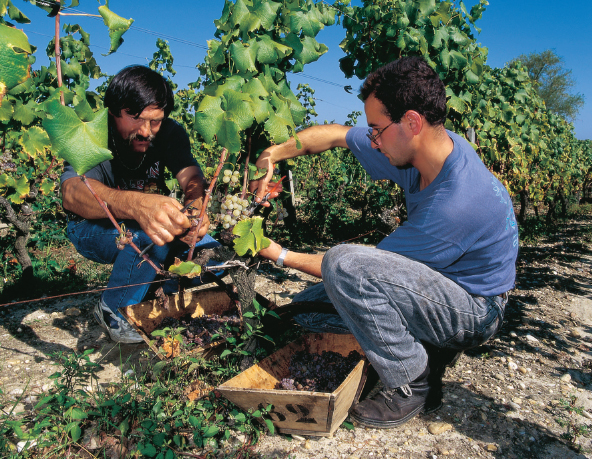
Picking grapes is never easy work – it’s backbreaking at the best of times. But when you have to search each cluster for berries of the right degree of noble rot, as is happening here at Château d’Yquem in Sauternes, then it requires great concentration. Only skilled pickers can be trusted with such a task.
Cultivation and yields
In Bordeaux growers may leave a long cane in order to have some spare buds in case of spring frost; what may happen is that the buds at the end of the cane grow vigorously and impede the development of those further down. The cane may be trained in an arcure to balance this.
Yields must be low if quality is the aim. Sauternes is the lowest: the legal limit is 25hl/ha, and most leading properties make much less. Yquem famously makes just one glass of wine per vine, or 9hl/ha. In Monbazillac legal maximum yields have been cut from an overgenerous 40hl/ha to a sensible 27hl/ha. In the lesser regions of Bordeaux yields may reach 80–100hl/ha. Australian yields are around 3.5 tons per acre or 8 to 9 tonnes per hectare (roughly 60hl/ha); in New Zealand Semillon produces thinner, grassier wine at 10–17 tonnes/ha.
At the winery
The big question with Sémillon is to oak or not to oak? It certainly has a great affinity with oak, in particular with new oak, and the increased proportion of new oak used by the Sauternes châteaux since the mid-1980s has been a factor in the improvement of the region’s wines. In the Graves, too, it is commonly fermented and aged in new oak; in youth these blends of Sémillon and Sauvignon Blanc can seem too intensely oaky but they age remarkably well. New oak here is being used with a more delicate hand than it was a few years ago, as is sulphur in Sauternes: Sémillon oxidizes easily, and one of the effects of noble rot is to make it require extra sulphur to protect it against oxidation. It takes a strong nerve for a grower to hold back. A few Sauternes are still noticeably sulphurous in youth, though this should fade with age.
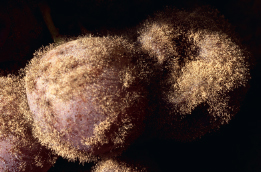
They look terrible, don’t they – awful, soggy, covered with furry rot. But this is noble rot at work, and the worse the grapes look, the sweeter their juice will be and the more luscious the wine.
The alternative style in Bordeaux and the southwest is the stainless steel-fermented one of crisp fruit and youthful acidity. Such wines are not intended to age, and a large proportion of Sauvignon Blanc is essential if the wine is to have sufficient flavour; young, unoaked Sémillon can taste lemony and grassy, but that’s about all. If it doesn’t have Sauvignon to help it along, then it needs oak. Sometimes, as in the great Sémillon-based dry whites of the Graves and Pessac-Léognan, it gets both.
In Australia, unoaked Semillon is a classic style of the Hunter Valley north of Sydney, where unpredictable, subtropical conditions often mean the grapes have to be picked very early or they rot on the vine. These wines, neutral – indeed positively acidic and tart – in youth, mature (after a decade or so) into rich, honeyed toastiness – tasting for all the world as though they had spent their infancy in new oak barrels, although they haven’t. Australian wine buffs love to bemuse visiting Brits in blind tastings with these unoaked beauties that we unerringly pronounce to be mature French Burgundy. The Hunter has toyed with oak-aging and now mostly rejected it; in South Australia, too, producers have mostly pulled back on the oak, though some is still successfully used in Western Australia. For the consumer, and perhaps for the producer, oak-aging means that the wine has more complexity at a young age: unoaked Hunter ones are beloved by those who know them, but they are about as far removed from wines for instant gratification as it is possible for a white wine to get. It’s not a difficult wine to make. As Bruce Tyrrell says, ‘just chuck it in a tank and leave it’.
SÉMILLON AND BOTRYTIS
What makes Sémillon and Botrytis cinerea so suited to each other? And what makes some rot noble and delicious and other rot merely grey and unpleasant-tasting?
Noble rot and grey bunch rot are the same fungus: both are Botrytis cinerea. The fungus is now thought to infect the berry at fruit set, and can develop in either direction, depending on circumstances; and it is by no means unknown to have grey rot and noble rot together, even on the same cluster.
For botrytis to turn noble, fluctuating humidity is necessary: just the sort of damp, foggy nights and early mornings, followed by warm sunny days, that are typical of a Sauternais autumn. Under these conditions fungal growth will be limited, and its metabolism modified. Constantly high humidity favours grey rot and heavy rain encourages berry-splitting; you need a team of experienced pickers to tell one from the other.
The flavour of botrytized Sémillon is not solely due to the concentration of sugars and acidity, though the drying and shrivelling of the grapes (which helps to protect against invasion by other bacteria that could produce off-flavours) is an important part. Noble rot metabolizes grape acids, especially tartaric, which falls dramatically in infected grapes. The concentration of the remaining acidity, however, means that the pH of botrytized Sémillon grapes is slightly, but only slightly, higher than that of healthy ones. It also metabolizes sugar, and total sugar content drops by 35–45 per cent; this is compensated by water loss as the grapes shrivel, and the remaining sugar becomes more concentrated. It produces glycerol, which contributes to the silky mouthfeel of botrytized wines, and it both degrades the esters that give white wines their fruitiness, and destroys the terpenes that give varietal aroma. Sémillon has so little varietal aroma and so few fruity flavours to start with that this is no great loss; and in their place the wine gains great aromatic complexity. (Muscat, by contrast, loses more than it gains, which is why most sweet Muscats are made sweet by the fortification method or by shrivelling.)
Sweet Sémillon’s youthful aromas come from over 20 aromatic compounds synthesized by noble rot. Sotolon is one: in conjunction with others, it helps to give nobly rotten wines their distinctive honeyed aroma.
SÉMILLON AROUND THE WORLD
Sémillon’s classic styles – Sauternes, white Pessac-Léognan and Graves, and the Hunter Valley – are so unlike each other that if growers elsewhere wanted to make serious Sémillon they would be forgiven for not knowing where to aim. Sémillon also seems to be its own worst enemy: unless severely regulated it produces huge amounts of insipid wine.
Sweet white Bordeaux
Sémillon is the main grape throughout Sauternes, Barsac, Monbazillac and the lesser sweet and semisweet white regions of Cadillac, Ste-Croix-du-Mont, Loupiac and Cérons. It accounts for between 60 and 90 per cent of most vineyards, the balance being Sauvignon Blanc (of which yields are slightly higher, so the percentage of Sauvignon in the wine may be greater than in the vineyard); and sometimes a few per cent of Muscadelle. Sauvignon adds freshness, lightness and acidity and Muscadelle aroma.
All these regions follow, more or less closely, the practices of Sauternes and Barsac, and the great improvements in quality in the latter regions since the 1980s have spread, with encouraging results. Monbazillac, for example, used to permit mechanical harvesters – a complete contradiction of the style of the wine, since botrytized wines depend on selection, and the hand and eye of the picker. Since 1994 these harvesters have been phased out, and minimum must weights have been increased from 13 per cent potential alcohol to 14.5 per cent. In fact, careful selection here can regularly produce potential alcohol levels of 18–19 per cent, and more in top years.
The rules in Sauternes are stricter. The alcohol in the finished wine must be at least 13 per cent, and is usually 14 per cent; the residual sugar usually amounts to another four to seven per cent potential alcohol. Château d’Yquem, for example, picks at between 20 and 22 per cent potential alcohol. It might be necessary to send the pickers through the vineyards for up to 10 separate passages to attain these levels, though three or four times is more usual. Much depends on the year: noble rot arrives more years than not, but it is unpredictable and often patchy. Years in which it blankets the vineyards, like 1990, are few and far between. Balance can also be a problem in Sauternes: Yquem sends constant instructions to its pickers to select more botrytized grapes or more healthy ones, as the balance of the must requires.
Chaptalization is permitted, though the best properties claim only to use it in poor years; cryoextraction is also permitted. This is an expensive technique which involves leaving the picked grapes for about 20 hours in a cold room to freeze their water content so that just the sweet juice runs from the press. It can be useful in a rainy year, but it is no substitute for careful selection. There are, inevitably, years in which noble rot fails to appear. In these years wine will be made from overripe and shrivelled grapes only: it may be sweet and concentrated and pretty tasty, but will lack the characteristic flavours of Sauternes.
Dry white Bordeaux
The lighter, sandier soils of Pessac-Léognan (where reds outnumber whites four to one) are the ones usually given over to white wines, of which at least 25 per cent of the blend must be Sauvignon Blanc. Usually Sauvignon’s figure is much higher, and may even be 100 per cent, though Sémillon is valued for the richness it brings to the blend, and for its affinity for the new oak in which the wine is usually fermented and aged. Flavours can be remarkably exotic, with apricot, nectarine and mango, nuts, custard and buttered toast complementing the leafy greeness of the Sauvignon Blanc, and the wines can age for many years. Dry whites from the rest of Bordeaux and the southwest are seldom intended for aging. The blend may range from 100 per cent to no Sémillon. It is being outplanted not just by Sauvignon, but by more fashionable red varieties.
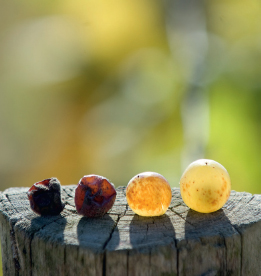
These four Sémillon grapes show different levels of botrytis infection – barely infected on the right through to shrivelled and furry, but intensely sweet, on the left. Most Sauternes will contain some of each level and only the best châteaux in the best years will manage nothing but the two on the left.
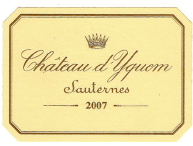
Château d’Yquem
This most famous of all Sauternes properties is owned by the multinational company LVMH, which also makes luggage, perfume and champagne.
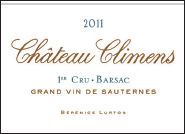
Château Climens
Climens produces one of the richest wines in Barsac, where the rules allow wines to be labelled either as Barsac or as Sauternes.
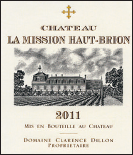
Château La Mission Haut-Brion
This wine used to be called Laville-Haut-Brion. Slow to open out, good vintages become deeper and more complex over 20 to 30 years.
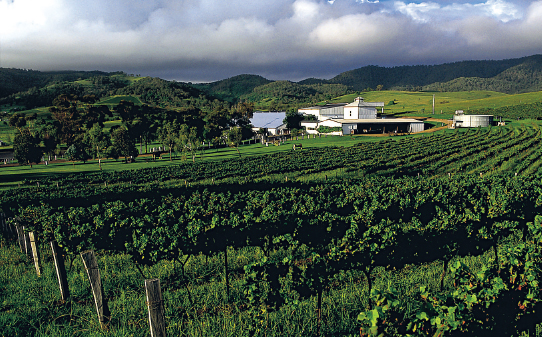
The Lindemans Ben Ean winery in the Lower Hunter Valley. This is one of the great historic wineries of an historic region: vines have been grown in the Lower Hunter since the 19th century. The unoaked Semillons for which it is known are a unique world wine style and predate by many years the birth of modern Australian wine. Difficult to appreciate when young, they were nearly washed away by a tide of fashionable Chardonnay – nearly but luckily not quite – and now they’re back, better than ever.
Australia
Hunter producer Bruce Tyrrell’s comment that ‘Semillon has a structure and acidity like Riesling; it’s like Riesling in everything except flavour’ might come as a shock to anyone comparing a high-acid Saar Riesling with a low-acid Bordeaux Sémillon. But Semillon in the Hunter Valley does have much higher acidity than it manages in France. The ripeness at which it is picked is a factor: for unoaked Semillon, which needs acidity to age for a decade or more in bottle, picking is often at 10.5–11 Baumé. For Semillon destined for oak-aging, more ripeness and substance is required, and picking is at 12–12.5 Baumé, to prevent the wine being swamped by the wood. If you pick at that ripeness for unoaked Semillon, the fruit loses its freshness and gets broad and blowzy after five or six years. The best vintages for unoaked Hunter Semillon are often the rainy ones: in 1971, says Tyrrell, it rained for three months, ‘and the wine is still going strong’. A bit of botrytis – say 10–20 per cent – is also useful for the complexity and aroma it adds.
Semillon from the rest of Australia is usually oaked; only that from Hilltops in New South Wales seems to share the Hunter structure. The warm irrigated regions produce large amounts of fairly basic but pleasant dry white that is often blended with Chardonnay and seasoned with oak chips. The Riverina area of New South Wales gets natural botrytis infection and has produced some astonishing Sauternes-like sweet wines.
USA
Plantings in California are falling rapidly, and what little there is is usually blended with Sauvignon Blanc. Clones and yields may be at fault, but the main problem is probably that few care enough to treat the vine seriously. Clos du Val makes a good varietal, though it is not as long lived as a Graves or Hunter version; Semillon in California is often more successful as a sweet late-harvest wine. There were experiments in the 1950s and 1960s by Myron and Alice Nightingale with spraying picked grapes with botrytis spores; Beringer made some wines commercially this way into the 1990s. The results were astonishingly intense, but lacked finesse. Results from botrytis infection in the vineyard have generally been better – occasionally, in Napa, excellent. Both Oregon and Washington State make a little, generally grassy, Sauvignon-ish wine, though Washington can excel in a nutty style.
New Zealand
Marlborough, Gisborne and Hawkes Bay are the main regions for Semillon in New Zealand but plantings in 2013 accounted for less than 1 per cent of the overall total. The usual clone here – UCD2 – has loose knit clusters like the Semillon in California, and unlike the compact clusters of Bordeaux. It is often blended with Sauvignon Blanc, and can improve the longevity of the latter. One or two interesting sweet wines have been made from Semillon.
Rest of the world
Chile had 959ha (2370 acres) in 2011 – which shows how great the decline has been since 1985’s figure of 6195ha (15,308 acres). A few producers, notably Morandé and Casa Silva, see it as having potential, and there are some old vines capable of interesting quality. Argentina has some. In South Africa, it is usually seen as a bulk variety except in Stellenbosch and Constantia, which makes fine barrel-fermented Sémillon–Sauvignon blends, and in Franschhoek and Swartland, which possess precious, ancient bushes. There is some in Croatia and other parts of Eastern Europe.

L’Ecole No 41
Washington State’s Sémillon plantings are in decline, but L’Ecole No 41 continues to make a world-class example, helped by a small addition of Sauvignon.
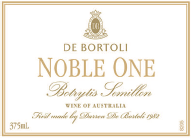
De Bortoli
The wine that has shown that Australia, too, can produce outstanding nobly rotten Semillon. Intense and sweet, it compares favourably with top Sauternes.
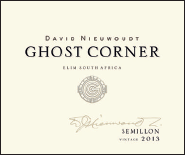
Ghost Corner
The extremely cool, windy conditions at Elim – on the southern tip of Africa – give leafy, crunchy flavours similar to Sauvignon Blanc.
ENJOYING SÉMILLON
Ask most of the world’s winemakers how Sémillon ages, and you’ll be told that it doesn’t. In most countries it’s a bland, bulk wine for drinking young.
Australia and France know differently. This is where Sémillon from a serious producer can last 20 years – and if botrytis is brought into the equation, wines from top châteaux can still be drinking a century later. Most Australian and French Sémillons, happily for those of us with neither the cellar nor the expected lifespan to keep wines for a century, are less extreme in their longevity.
Simple Bordeaux Blanc should be drunk within a year or two of the vintage; even decent quality white Pessac-Léognan and Graves should mostly be drunk within five years. Classed Growth wines can last longer, from 10 to 20 years in a good vintage, and are good at almost any age; the exceptions, and the longest-lived wines, are the magically rich yet dry Haut-Brion and Laville-Haut-Brion, which are seldom at their best before their fifth birthday but which positively demand 20 years in a good vintage.
Much is written about Sauternes needing time to mature. Of course it does improve in bottle, but it is also utterly delicious young, and while Classed Growth wines should probably not be touched for at least 10 years, lesser wines, and those from Monbazillac, can be drunk with great enjoyment earlier.
Unoaked Hunter Semillon is, however, less expressive in youth. It needs five or six years to show much character, but the rainiest, most acidic vintages (the best ones, in other words) can last 20 years or more. Upper Hunter Semillon develops faster than Lower Hunter wine. Oaked Semillon can sometimes last three or four years, but the point of the oak is to make the grape more complex, and therefore drinkable, at a younger age. It is always drinkable immediately upon release, though many improve with a little extra aging.
The taste of Sémillon
‘Battery acid’ is how winemaker Michael Hill Smith succinctly describes the flavour of young, unoaked Hunter Valley Semillon. The same could be said of much German Riesling; and like Riesling, Hunter Semillon develops astonishing flavours of honey and toast. After six or 10 years in bottle it does not have clear fruit flavours, although in youth it is citrous and fresh; maturity subsumes its fruit into a rich, silky wininess.
Oaked Australian Semillon is different: being picked riper it has richer fruit flavours, of greengages and apricots and mangoes, all mixed with the custardy vanilla of the wood. It is richer, broader and fuller than good white Graves or Pessac-Léognans, which usually have a substantial addition of Sauvignon Blanc for acidity and freshness; they are generally tighter and more subtle, and elegance, finesse and a complex nuttiness are more to the fore, particularly with maturity. In young Graves wines, if they are not dominated by new oak, the Sémillon adds creaminess, sometimes almost like egg custard, and nectarines to the Sauvignon, which in any case is less grassy in Bordeaux than it is in somewhere like New Zealand.
The flavours of Sauternes are of marzipan, apricots, mangoes, honey, nuts, toast, pineapple, peach, orange, honeysuckle, beeswax, barley sugar and coconut, all wrapped up in a creamy, silky, unctuous texture, enthralling and rich. If that seems like an awful lot of flavours, get yourself a mature bottle of top Sauternes and sip it reflectively – don’t hurry. You may end up needing more words, not fewer.
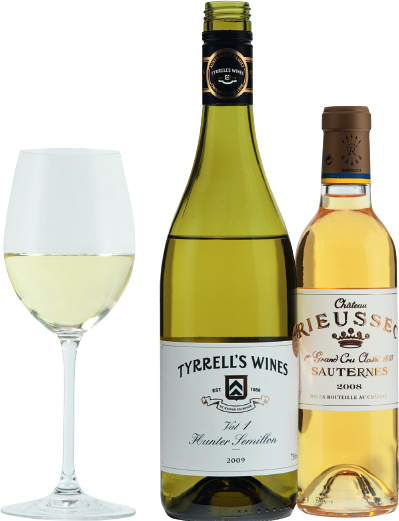
Tyrrell’s Vat 1 Semillon comes from vines dating back a century and more in the Hunter Valley. The wine is usually fairly low in alcohol and is bottled without any oak aging after only six months’ aging. It starts out life lean, lemony and leathery, but takes on an amazing, honeyed, waxy, toasty richness with age. Château Rieussec is one of the most unctuous and compelling of Sauternes wines, immensely rich, almost syrupy, when young but able to age to a majestic mix of honey, barley sugar, pineapple and marmalade after 10–20 years.
MATCHING SÉMILLON AND FOOD
Dry Bordeaux Blanc wines are excellent with fish and shellfish; fuller, riper New World Semillons are equal to spicy food and rich sauces, often going even better with meat than with fish. Sweet Sémillons can partner many puddings, especially rich, creamy ones. Sémillon also goes well with many cheeses, and Sauternes with Roquefort or other blue cheese is a classic combination.
CONSUMER INFORMATION
Synonyms & local names
Known in 19th-century South Africa as Wyndruif (‘winegrape’) or ‘groen’ (‘green’) grape and in Australia’s Hunter Valley as Hunter Valley Riesling. Called Boal in the Douro Valley, Portugal.
Best producers
FRANCE/Bordeaux/Graves and Pessac-Léognan Ardennes, Brondelle, Chantegrive, Dom. de Chevalier, Clos Floridène, Fieuzal, Domaine la Grave, Haut-Brion, Landiras, Laville-Haut-Brion, Latour-Martillac, Pape-Clément, Rahoul, Respide-Médeville, Roquetaillade-la-Grange, Seuil, Vieux Château Gaubert, Villa Bel Air; Sauternes/Barsac Bastor-Lamontagne, Climens, Clos Haut-Peyraguey, Coutet, Doisy-Daëne, Doisy-Védrines, Fargues, Filhot, Gilette, Guiraud, Haut-Bergeron, les Justices, Lafaurie-Peyraguey, Lamothe-Guignard, Laville, Malle, Myrat, Nairac, Piada, Rabaud-Promis, Raymond-Lafon, Rayne-Vigneau, Rieussec, Sigalas-Rabaud, Suau, Suduiraut, la Tour-Blanche, Yquem; other Bordeaux Birot, Carsin, Cayla, Chantegrive, Cros, Fayau, Grand Enclos du Château de Cérons, Haura, Lagarosse, Loubens, Loupiac-Gaudiet, les Miaudoux, Noble, Pavillon, la Rame, Reynon, Ricaud, Seuil, Sours, Toutigeac, Turcaud; Bergerac le Raz, Tour des Gendres; Monbazillac/Saussignac l’Ancienne Cure, Bélingard, Bellevue, la Borderie, Clos d’Yvigne, Grande-Maison, les Hébras, la Maurigne, Miaudoux, Richard, Theulet, Tirecul-la-Gravière, Treuilde-Nailhac, Verdots.
USA/California Amador Foothill, Chalk Hill, Far Niente, Peter Michael, Simi, Spottswoode, St Supéry, Swanson; Washington State Amavi, Chateau Ste Michelle, Columbia, L’Ecole No 41, Woodward Canyon.
AUSTRALIA Tim Adams, Brokenwood, Leo Buring, Cape Mentelle, Chain of Ponds, Cullen, D’Arenberg, De Bortoli, De Iuliis, Fermoy Estate, Huntington Estate, Peter Lehmann, Lindeman’s, McWilliams, Moss Wood, Mount Horrocks, Nepenthe, St Hallett, Stella Bella, Torbreck, Tyrrell’s, Vasse Felix, Westend, Yalumba.
NEW ZEALAND Alpha Domus, Pegasus Bay, Selaks, Seresin, Sileni.
SOUTH AFRICA Boekenhoutskloof, Cape Point, Cederberg Ghost Corner, Fairview, Mullineux, Neethlingshof, Sadie, Steenberg, Stellenzicht, Vergelegen.
RECOMMENDED WINES TO TRY
Classic sweet white Bordeaux
See Best producers for Sauternes/Barsac left.
Ten other French sweet white wines
Ch. d’Arche Sauternes
Ch. Bastor-Lamontagne Sauternes
Ch. Barréjats Sauternes
Grand Enclos du Château de Cérons Cérons
Ch. Loubens Ste-Croix-du-Mont
Ch. les Miaudoux Saussignac
Ch. du Noble Loupiac
Ch. la Rame Ste-Croix-du-Mont Réserve du Château
Ch. Theulet Monbazillac Cuvée Prestige
Ch. Tirecul-la-Gravière Monbazillac
Ten French Sémillon-dry blends
Ch. Bauduc Les Trois Hectares, Bordeaux Blanc
Ch. Carsin Bordeaux Blanc Cuvée Prestige
Ch. de Chantegrive Graves Cuvée Caroline
Clos Floridène Graves
Domaine la Grave Graves
Ch. Haut-Brion Pessac-Léognan
Ch. Laville-Haut-Brion Pessac-Léognan
Ch. le Raz Montravel Cuvée Grande Chêne
Ch. Reynon Bordeaux Blanc Vieilles Vignes
Ch. Tour des Gendres Bergerac Cuvée des Conti
Ten dry New World Semillon wines
Tim Adams Clare Valley (Australia)
Bethany Barossa Valley Wood Aged (Australia)
Boekenhoutskloof Franschhoek (South Africa)
Cederberg Ghost Corner Semillon (South Africa)
L’Ecole No 41 Columbia Valley Barrel-Fermented (Washington)
McWilliams Hunter Valley Mount Pleasant Lovedale (Australia)
Moss Wood Margaret River (Australia)
Sileni Semillon (New Zealand)
Stellenzicht Stellenbosch Reserve (South Africa)
Tyrrell’s Hunter Valley Vat 1 (Australia)
Five sweet New World Semillon wines
Tim Adams Clare Valley Botrytis (Australia)
Chateau Xanadu Margaret River Noble Semillon (Australia)
De Bortoli Noble One (Australia)
Swanson Crepuscule (California)
Yalumba Eden Valley Botrytis (Australia)
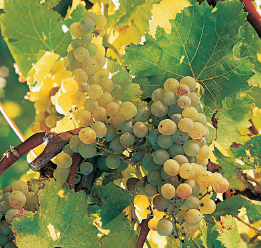
Sémillon ready to be picked. The green grapes have turned to gold and a few have even begun to speckle. Leave them and they will nobly rot for sweet wine if the weather permits. Pick them now and they may lack freshness but will add wax and lanolin texture.
Maturity charts
Sauternes and Pessac-Léognan can be drunk young, but greatly improve with age while unoaked Hunter Semillon demands age.
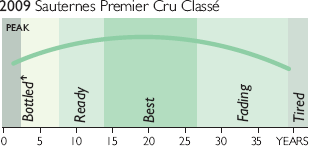
2009 Sauternes are outstanding, supremely sweet, wonderfully fresh, impressively structured. Lovely now, they will last and last.
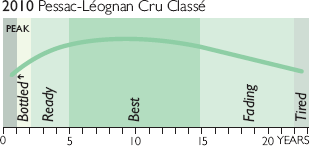
Modern Pessac-Léognan whites are delicious at bottling but gain fascinating depth and compexity with aging between 5 and 15 years.
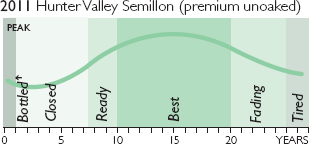
A warm, early vintage of waxy wines. The acidity starts high, but the wines emerge eventually into an amazing, toasty maturity..
SERCIAL 
One of the noble grape varieties of Madeira, now much reduced in area and really only found around Câmara de Lobos in the south of the island, and around Porto Moniz in the northwest. It is often grown at high altitude, and being in any case late ripening, it is the last variety to be picked.
It is high in acidity and makes the driest and lightest of all Madeira styles. Since 1993 any Madeira with the word ‘Sercial’ on the label must contain at least 85 per cent of that grape. Modernizing efforts by the island’s largest producer, the Madeira Wine Company, mean that its Sercial Madeiras are slowly becoming less austere in style, and retaining more fruit flavour. This is partly achieved by maturing the wine not by the short, sharp shock of a warm estufa (which nowadays is used only for the cheaper wines of Madeira), but by the gentler canteiro method, in vats stored under the roof. Since the brilliant, shocking tang of Sercial, and its astonishing longevity were two of the reasons for Sercial wine’s greatness, I hope modernization doesn’t mean ‘dumbing down’.
Sercial is the same grape as the Esgana Cão, or ‘Dog strangler’, of the Portuguese mainland (see here). Best producers: (Portugal) Barros e Sousa, Blandy, Cossart Gordon, Henriques & Henriques, Leacock.
SEYVAL BLANC 
A French hybrid vine that was produced by crossing two Seibel hybrids – Seibel (see here) being the name of a group of French hybrids. Seyval Blanc is a so-called Seyve-Villard hybrid, one of a group of about 100 French hybrids bred by Bertille Seyve and Victor Villard.
As it is not pure vinifera, it is forbidden by EU law from being used in Quality Wine. Ironically, it is one of the most successful varieties of all in England, producing well-structured wines which, at their best, have a strong, Chablis-like austerity to start with and attain a complex honeyed richness with bottle age. Seyval Blanc may be coarse and dull in warmer France, but every grape has a day of glory, and low-cropped Seyval in cool England can make a smashing dry white. The fact that the EU would like to stop England using it for quality wine is merely proof, for some, of a French-inspired conspiracy against poor old Blighty. The big investments in English wine, however, are directed at sparkling; so the spotlight has moved away from Seyval Blanc of its own accord. Elsewhere it is found in Canada, and the eastern USA. Best producers: (England) Breaky Bottom, Camel Valley, Chapel Down, Three Choirs; (USA) Benmarl, Wagner.
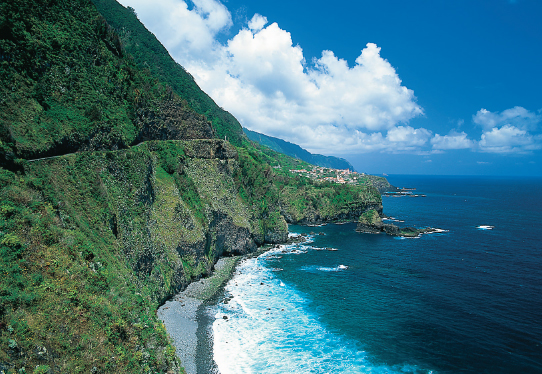
The northern coast of Madeira near the village of Seixal is one of the best spots for growing Sercial, but as always in Madeira, other vines – here, notably, the hybrid Jacquet – outnumber the noble variety.
SHIRAZ 
The Australian name for Syrah (see here) But it’s a lot more than that – to many drinkers, the very word Shiraz evokes images of rich, dark, spicy red wines that perfume the brain and fill the nostrils with billowing waves of flavours. Many of these drinkers would not know what Syrah was, but Australian Shiraz is their nirvana.
Nowadays you can often tell what style a winemaker is after by whether he or she labels the wine Syrah – for a more austere, less ebullient style, or Shiraz – for a richer, riper, more hedonistic experience. And consequently you may find the names Shiraz or Syrah in countries from Australia to Chile, South Africa and even France. To generalize, the Australian Shiraz style is richer than Rhône Syrah, with broader, sweeter fruit, and more flavours of chocolate and berries instead of the smoke and minerals of the northern Rhône. Syrah is generally thought to be the original name of the grape – but is it? The town of Shiraz in ancient Persia is one of the first recorded centres of winemaking and the Phoenicians went there and traded their vines around the Mediterranean. The vine, though, is now thought to have originated in the Rhône Valley.
SILVANER 
See here.
SÍRIA 
This is what we should really be calling the grapes we know as Spain’s Doña Branca and the Alentejo’s Roupeiro; it has a good few other synonyms as well, but the Dona Branca of Portugal is a separate vine. It’s an old variety that seems to have originated in northwest Iberia; it makes intensely aromatic wines – think of lime blossom and peach, with a lush texture – but it doesn’t keep its aromas for long because it oxidizes so easily and so early. Producers who take it seriously and address these problems can produce some lovely wines.
SOUSÃO 
Portuguese black grape found in the Douro Valley. It is not one of the five varieties recommended for planting by the port authorities, but plays a part in one of the greatest of all ports, Quinta do Noval’s Nacional, as well as in many others. It is normally thought of as a rather rustic grape that contributes intense colour and a certain raisiny fruit to the blend, but which does not age particularly well. It is the same grape as Vinhão (see here), which is the main grape grown for red Vinho Verde. It appears in Galicia as Sousón. In South Africa it is regarded as one of the better fortified wine varieties for its high sugar levels and deep colour. There is a little in Australia and California, too. Best producers: (Portugal) Quinta do Noval; (South Africa) Boplaas, Die Krans, KWV, Overgaauw.
SPANNA 
Nebbiolo is known by this name in the Vercelli and Novara hills of Piedmont. It is found under this name in the DOCs of Gattinara, Ghemme and several others, usually blended with other grapes. The wines have a reputation for being somewhat tough and stringy, but improved winemaking is yielding better results in the form of rounder fruit and riper tannins. See Nebbiolo here.
SPÄTBURGUNDER 
German name for Pinot Noir (see here). Styles of this wine have changed out of all recognition in Germany, with the pale, sweet wines of yore being superseded by dark, dry, sometimes overoaked international versions. The best wines come from the Pfalz and Baden regions. Best producers: (Germany) Bercher, Rudolf Fürst, Huber, Karl-Heinz Johner, Meyer-Näkel, Rebholz.
STEEN 
Traditional South African name for Chenin Blanc (see here), although the latter name is now generally used. On the decline, it now covers less than 18 per cent of the total vineyard area there, but it is still easily the most planted variety in the country. It is South Africa’s national workhorse grape, producing everything from dry table wine, through sweet and sparkling wines, to fortified wines and brandy. The growing band of producers determined to improve the quality and image of the grape in South Africa, and already producing some of South Africa’s most interesting whites, prefer the name of Chenin Blanc. Best producers: (South Africa) Cederberg, Glen Carlou, Hartenberg, L’Avenir, Mullineux, Stellenzicht, Villiera.
SUMOLL 
You’re most likely to come across this in the Canaries, though it’s also found occasionally in Catalonia. It makes fairly unremarkable but attractive wine: nicely fruity with good acidity and freshness. Sumoll Blanc, also found in Catalonia, is unrelated.
SILVANER 
Silvaner (see here) is spelled with a ‘y’ in all countries except Germany.
SYRAH 
See here.
SZÜRKEBARÁT 
Hungarian name for Pinot Gris (see here). At their best the wines are lively, with good earthy, spicy fruit, but winemaking and viticulture are of variable standards and a vaguely grubby flat flavour is still unfortunately more common than the bright, minerally, honeyed style it can achieve.
TAMÎIOASA 
The Romanian name for Muscat. Tamîioasa Alba or Tamîioasa Româneasca are names for Muscat Blanc à Petits Grains, while Tamîioasa Ottonel is Muscat Ottonel and Tamîioasa Hamburg or Neagra is Muscat of Hamburg.
Tamîioasa Româneasca is used, unusually, for nobly rotten wines in Romania (sweet Muscats are not usually achieved through noble rot), and the name may appear on the label as the only grape in such wines, although in the historic sweet wine region of Cotnari in the northeast of the country a blend of several grapes, including Grasa, Fetească Alba and Frîncusa as well as Tamîioasa Româneasca is supposed to be traditional. Noble-rotted versions of Tamîioasa lack the characteristic Muscat Blanc à Petits Grains aroma, and have instead a more typically botrytis spice and marzipan note. These are difficult times for Romanian wines, but there are still occasionally lovely examples of Tamîioasa, both young and old wines, to make you hope that, one day, Romania will begin to fulfil its massive potential once more. Best producers: (Romania) Cotnari Cellars, Dealul Mare Winery.
TAMINGA 
Recent Australian cross bred to withstand warm conditions. It yields generously, keeps its acidity, and gives aromatic, grapy-tasting wine, which makes it very useful for sprucing up otherwise flavourless blends.
TANNAT 
A grape of the Basque region of southwest France, seldom seen on wine labels there, but now making its mark as one of the more interesting grapes grown in South America.
In France its wines are most notable for their high tannin levels, and in Madiran the grape benefits from being blended with Cabernets Sauvignon and Franc as well as Fer, to make it more approachable. It also plays a part in Côtes de St-Mont, Irouléguy, Tursan and Béarn. All these reds have been or are being improved by modern winemaking methods, which emphasize fruit and soften tannins, but all can be tough to the point of astringency if not made well. The method of tannin-softening known as micro-oxygenation – bubbling small amounts of oxygen through the wine – was developed in Madiran for Tannat. A case of necessity being the mother of invention. The grape gives deep colours and takes well to oak aging. But it is generally in decline in France. This may be reversed by research showing that Tannat has record high levels of procyanidins, the heart-friendly chemical in red wine. Ninety-year-old men are surprisingly common – and healthy – in the deep southwest.
In Uruguay Tannat is increasing in quality every year, and ideally is marked by its fine, ripe tannins and elegant blackberry fruit. These wines seem far more European in style than most from South America, and it’s a matter of opinion whether they could actually use more of the juicy, ripe fruit that is so typically South American, or whether they should jealously guard their rather more severe European style. Plantings at Maldonado out on the Atlantic Coast may provide the perfect compromise.
Growers in Uruguay report a difference in character between their old vines, which are descendants of the original cuttings brought from southwest France, and the newest clones imported from France. The newer ones tend to give more powerful but more simple wines, with an extra degree of alcohol – 13–13.5 instead of 12–12.5 per cent – but less acidity. The best solution, if complexity and depth are the aims, might be to produce virus-free clones from the old vine stocks – but, of course, the removal of viruses can itself change the character of the wine. A few good examples in Argentina, California, Brazil and Virginia. Best producers: (France) Aydie, Barréjat, Berthoumieu, Brana, Cayrou, la Chapelle Lenclos, Crampilh, Montus, Producteurs Plaimont; (Uruguay) Establecimiento Juanico, Pisano, Castel Pujol, Hector Stagnari.
TARRANGO 
A modern Australian crossing, bred in 1965 from Touriga x Sultana to give wines of fair colour and acidity but low tannin – Beaujolais-style, in other words. Quality is pretty good and prices are low. Tarrango needs hot climates to ripen properly and is at its best in the torrid, irrigated Riverland region where producing a bright, breezy, juicy red in such semi-desert conditions is quite an achievement. Best producer: (Australia) Brown Brothers.
SILVANER
I used to look forward to Silvaner (or Sylvaner as the French and most other people spell it) wines in blind tasting competitions for the simple reason that it seemed to have almost no taste of its own, except for a certain green apple peel acidity when it came from a decent Alsace producer, and consequently, you could always taste the terroir. Well, the vineyard anyway. Actually what I really mean is the mud, the earth, and, if the wine was mature, it developed a strange taste of tomatoes. So I suppose I’m saying it never exactly tasted that clean, but I could sure as hell spot it in a blind line-up.
But that doesn’t mean it was necessarily unattractive because, in either Alsace or Germany, surrounded by wines that were either highly aromatic or definitely on the sweet side, this broody, earthy quality actually made it rather appetizing. However, having earthiness as your main taste characteristic is not going to endear you greatly to producers in new wine regions looking for new vines to plant. Despite having once been widespread throughout Central Europe, Silvaner is now in decline and has made virtually no mark at all on the New World, though California has a few vines, and one or two Australians have had a sniff of it.
It seems to have originated in Austria – Savagnin getting together with Osterreichisch Weiss. Savagnin’s alter ego is Traminer, and Osterreichisch Weiss can still be found very occasionally near Vienna. It was introduced to Germany in the replanting that followed the Thirty Years War.
It’s still Franken’s main speciality. It has that dry (usually less than 4 grams per litre of residual sugar), slightly earthy fruit, good apple peel acidity and a lightness that can veer towards the insubstantial, but at low yields it reflects the subtleties of its terroir and can last well for a few years. In the Rheinhessen it also occupies some good sites. I still find that earthy undertow in the wines, but it can make good apple-crisp dry whites as well as surprisingly long-lived, fat, sweet styles – Spätlese and Auslese. The old East German vineyards in Sachsen and Saale-Unstrut also produce good examples.
In Alsace most growers have turned from Sylvaner to Pinot Gris and Pinot Blanc, which is a shame, because from a serious grower it can be a weighty, structured delight. You can still find a little Sylvaner in Central and Eastern Europe – Hungary, Slovenia, Russia and the Czech Republic have some, and Austria has a few plots. But the only other places where it performs remotely memorably are Italy’s Alto Adige and Switzerland (it’s called Johannisberg there) where in some of the warmer sites in the Valais it can produce surprisingly deep, golden, minerally wine.
THE TASTE OF SILVANER
Even at its best, Silvaner seems to have more of a style than an actual flavour. In Germany its wines are dry, light and gently earthy, but never pungently so, and never at all aromatic. In Alsace it takes on the region’s prevailing smoky spice, together with greater breadth, but still has little in the way of identifiable flavour. Italy’s Alto Adige makes a fairly bright acid style and Switzerland can add a little earthy honey. But most examples won’t age and will start to taste of tomatoes if you do try to cellar them.
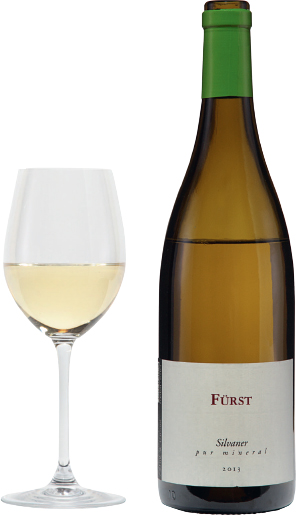
The Franken region, spread along the banks of the River Main to the east of Frankfurt, is unusual in Germany, in that the best wines are made from Silvaner rather than Riesling grapes. This is due to the area’s continental climate, which used to mean that winter could suddenly close in with its murderous frosts before the Riesling was fully ripe, yet the earlier-ripening Silvaner could have been picked at full maturity. So a lot of the best vineyard sites are also given over to Silvaner, and its dry, earthy, savoury make Franken Silvaner the best in the world. The Fürst family have been making wine at Bürgstadt since 1638, and the vines are from a steep, south-facing slope of warm, iron-rich weathered sandstone soils.
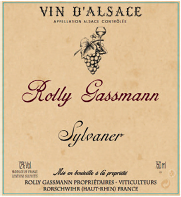
Domaine Rolly Gassmann
Sylvaner has been in decline in Alsace for a long time, but since 2005 some sites can now make Grand Cru Sylvaner and its earthy, savoury merits are starting to be appreciated.
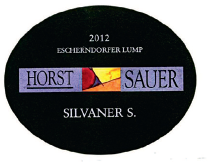
Horst Sauer
The Lump vineyard at Escherndorf in Franken has excellent southeast exposure: Silvaner gets very ripe here. Generally speaking, the vine doesn’t like the very hottest sites, but it’s not complaining chez Herr Sauer.
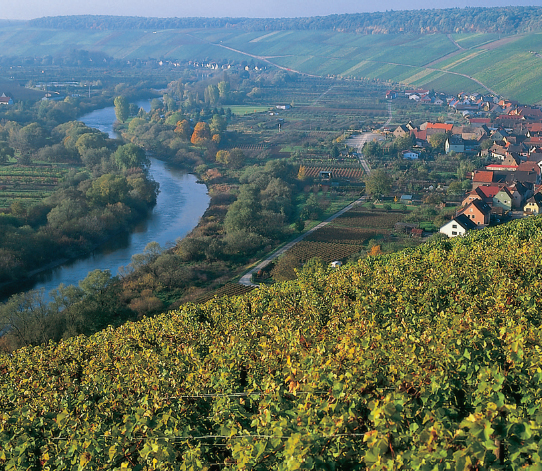
As is so often the case in Germany, the village – in this case, Escherndorf in Franken – is on the flat land beside the river, while vines are planted on the steep slopes above, benefiting from the sunny aspect. Here, the bends in the meandering River Main create several excellent vineyard sites.
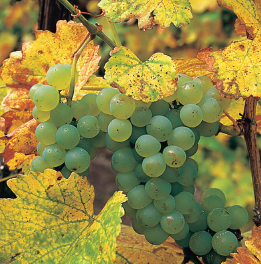
Growers in Germany like Silvaner for its early ripening and consistently high yields – higher than Riesling. In Franken it likes fairly warm sites with deep, rich soil and with good moisture retention. Its character is subtle rather than strong, but it can make wines of all levels of sweetness, up to Trockenbeerenauslese.
CONSUMER INFORMATION
Synonyms & local names
The grape is spelt Silvaner in Germany and Sylvaner in France and Austria. The Swiss have many synonyms for it, including Johannisberg in the Valais.
Best producers
FRANCE/Alsace Auther, P Blanck, Bott-Geyl, Albert Boxler, Bursin, Dirler-Cadé, Kientzler, Seppi Landmann, René Muré, Ostertag, Pfaffenheim co-op, Rolly Gassmann, Martin Schaetzel, Bruno Sorg, Marc Tempé, Weinbach.
GERMANY Bürgerspital, Rudolf Fürst, Fürstlich Castell’sches Domänenamt, Freiherr Heyl zu Herrnsheim, Staatliche Hofkeller, Juliusspital, U Lützkendorf, Horst Sauer, Schmitt’s Kinder, Störrlein.
ITALY Abbazia di Novacella co-op, Köfererhof, Peter Pliger/Kuenhof, Valle Isarco co-op.
SWITZERLAND Robert Gilliard, Caves Imesch.
AUSTRALIA Ballandean Estate.
SOUTH AFRICA Overgaauw.
RECOMMENDED WINES TO TRY
Ten German wines
Rudolf Fürst Bürgstadter Centgrafenberg Silvaner Kabinett
Fürstlich Castell’sches Domänenamt Casteller Hohnart Silvaner Kabinett Trocken
Freiherr Heyl zu Herrnsheim Niersteiner Rosenberg Silvaner QbA Trocken
Staatliche Hofkeller Würzburger Stein Silvaner Spätlese Trocken
Weingut Juliusspital Iphofer Julius-Echter-Berg Silvaner Spätlese Trocken and Würzburger Stein Silvaner Spätlese Trocken
U Lützkendorf Pfortener Köppelberg Silvaner Trocken
Horst Sauer Eschendorfer Lump Silvaner Auslese and Eschendorfer Lump Silvaner Spätlese Trocken
Schmitt’s Kinder Randsackerer Sonnenstuhl Silvaner Spätlese Trocken
Ten Alsace wines
Blanck Sylvaner Vieilles Vignes
Dirler Sylvaner Vieilles Vignes
Kientzler Sylvaner
René Muré Sylvaner Clos St-Landelin Cuvée Oscar
Domaine Ostertag Sylvaner Vieilles Vignes
Pfaffenheim co-op Sylvaner Vieilles Vignes
Rolly Gassmann Sylvaner Vallée Noble
Martin Schaetzel Sylvaner Vieilles Vignes
Bruno Sorg Sylvaner
Weinbach Sylvaner Réserve
Eight other Sylvaner wines
Abbazia di Novacella co-op Alto Adige Valle Isarco Sylvaner (Italy)
Ballandean Estate Late Harvest Sylvaner (Australia)
Robert Gilliard Johannisberg du Valais Porte de Novembre (Switzerland)
Caves Imesch Johannisberg du Valais Sylvaner (Switzerland)
Köfererhof Alto Adige Valle Isarco Sylvaner (Italy)
Overgaauw Stellenbosch Sylvaner (South Africa)
Peter Pliger/Kuenhof Alto Adige Valle Isarco Sylvaner (Italy)
Valle Isarco co-op Alto Adige Valle Isarco Sylvaner Dominus (Italy)
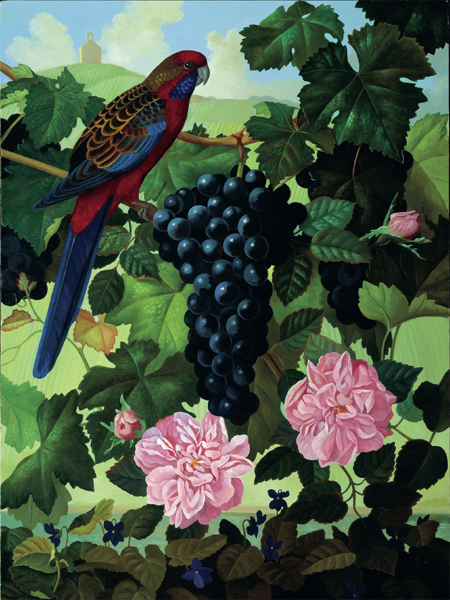
SYRAH/SHIRAZ
Syrah/Shiraz: from Grape to Glass
Geography and History here; Viticulture and Vinification here; Syrah/Shiraz around the World here; Enjoying Syrah/Shiraz here
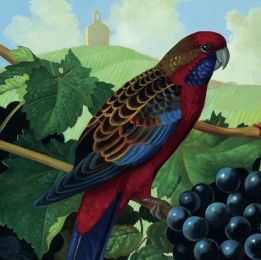
Whether it originated in the northern Rhône, its European heartland, in Syracuse in Sicily or was brought back from Shiraz in Persia, there is something exotic about this grape. It’s a nice idea but probably untrue that Syrah reached Europe at roughly the same time as the damask rose, and along the same route. In the far distance is the chapel on the Hermitage hill high above the river Rhône and in the foreground some of the wild violets that seem to perfume the wine itself. The parrot is an Adelaide Rosella whose habitat includes the Barossa Valley where Shiraz excels.
Most of the wine tastings I conduct each year are not for wine connoisseurs. But they are always for enthusiasts – and I want them to go away happy that they’ve learned a bit about this wine tasting lark. So I have to use wines with loads of flavour. For instance, I start out with Sauvignon Blanc from New Zealand because you’d have to have the palate of a lamppost not to appreciate and recognize some of the powerful fruit flavours there. And after roaming through the world of white and red, I need a grand finale: I need a great big walloping wine packed with personality and passion to finish off with. I need a wine to put a smile on people’s faces and start a jitterbug in their hearts. And I always choose Australian Shiraz, as Syrah is called there – from the Barossa Valley or McLaren Vale. But as the cult of Shiraz spreads, I can see myself using Californian, South African, Argentinian, Chilean or New Zealand examples. Or, of course, French – where they’d call it Syrah, if they put the name of the grape on the label at all, that is. And when I ask people what their favourite wine is – they chorus, ‘Shiraz’. And if I’d asked them what the greatest wine grape in the world was – they’d probably scream, ‘Shiraz’. And perhaps they’re right. Perhaps it is. You wouldn’t have found many supporters for that view a generation ago. The name Syrah was largely unknown to anyone who wasn’t a red Rhône fanatic. In Australia the name Shiraz was applied to a style of rich, ripe, ebullient red wine that was generally thought of as an old-fashioned alternative to Cabernet Sauvignon.
Ah, yes. Cabernet Sauvignon. The grape that has enjoyed a century and more revelling in its reputation as the world’s great red wine grape. And until the 1980s, there wasn’t a suggestion of any rival to its position. Bordeaux reds were thought of as the world’s greatest. Anyone in the New World wishing to be taken seriously would plant their best land with Cabernet Sauvignon and pray the wine turned out something like Bordeaux.
But why wasn’t anyone doing the same with Syrah? Well, the fact is that there was a large amount of good-quality Bordeaux red available and it had first been exported to northern Europe and then around the world more than 800 years ago. The great red wines of the Rhône, however, were very scarce, hardly written about, rarely exported and consequently few of the New World pioneers had ever tasted them, so why on earth would they even think of planting Syrah? Only Australia, pursuing its own merry path thousands of miles away in the southern Pacific, had significant plantings – and they were mostly for making port.
Well, luckily the Rhône began to get its share of the limelight during the 1990s – just at a time when Bordeaux was starting to look very expensive and, after a string of poor vintages, not very good value. And, what a surprise, Australia suddenly realized what a fantastic grape Shiraz was and how lucky they were to have so much of it. The 1990s was also a decade when warm climate flavours began to be appreciated more than cool climate ones, and if you have to look for France’s greatest warm-climate variety, Syrah is unquestionably the star. And if you have to decide on the most opinionated, bumptious, most irrepressibly self-confident of the warm climate nations, Australia takes the crown without breaking sweat. So the Aussies blew the Shiraz trumpet long and stridently, and the wine world listened and planted the vines furiously. But the 21st century has seen a quality breakout in the more restrained ‘Syrah’ style of the Rhône Valley, and the wine world listened again. Two great red wine originals at opposite ends of the taste spectrum, from one great grape variety, and if anything, the cooler, more scented ‘Syrah’ styles are beginning to overtake the richer, riper ‘Shiraz’ styles in popularity as growers seek out less sun-baked slopes to plant their vines. So what’s it to be? Shiraz or Syrah? Which one is fighting for the title of ‘greatest wine grape’? I’d say they both are.
GEOGRAPHY AND HISTORY
A map showing the spread of Syrah (or Shiraz, the name it takes in the New World) would have appeared very different 30 years ago. Then it would have looked like a grape in decline. And in any case, there would be only two patches on the map with any significant plantings at all – Australia and southern France. In Australia its vineyards were shrinking under the pressure to plant fashionable Cabernet Sauvignon, and indeed Chardonnay. Only in its homeland of the Rhône Valley – in particular Hermitage – and in the Midi, where it has long been regarded as an ‘improver’ vine, ideal for bolstering the aroma and flavour of otherwise tough reds, was it recovering from a long period of drab stagnation.
In the first half of the 19th century the picture would have looked different again. Bordeaux would have been highlighted on the map. There were small but significant amounts planted here, at châteaux as eminent as Cos d’Estournel, Lafite and Latour.

Syrah was also grown and vinified in the Rhône, to be blended with top-level red Bordeaux to add colour and structure; the resulting ‘improved’ wines were described as ‘Hermitagé’. As merchant Nathaniel Johnston wrote to his partner Monsieur Guestier in Bordeaux in the early 19th century, ‘The Lafitte of 1795, which was made up with Hermitage, was the best liked wine of any of that year’.
But while Syrah blends like a dream with other varieties and also makes some of the finest, most exotically aromatic of red wines on its own, it is quite fussy about where it grows. Now that it is fashionable again, it has spread rapidly across the world – into California, Spain, Switzerland and Chile, Argentina, South Africa and New Zealand, and even, more cautiously, into the vineyards of Austria, Italy, Bulgaria and Portugal. Growers are now more prepared to admit that in the right relatively cool conditions it can be more successful than Cabernet or Merlot. But its choosiness means that it is unlikely ever to become as widespread in every wine region of the world as Cabernet Sauvignon.
HISTORICAL BACKGROUND
It is somehow appropriate that a grape so startlingly perfumed should come laden with legend. Were the first vines on the hill of Hermitage in the Rhône planted by St Patrick as he made his way to the monastery of Lérins by the sea? Were they planted by a returning Crusader, Gaspard de Stérimberg? Did the Syrah vine originate in Persia and take one of its names from the city of Shiraz? Did it originate in Egypt, and travel to the Rhône via Syracuse in Sicily, gaining its name on the way? Or did it simply originate in the northern Rhône and stay there?
Sadly for romantics, it looks as though the last theory is the correct one, though mere reality won’t stop me preferring all the other stories. A vine known as Allobrogica was being cultivated in the northern Rhône by the Gallic tribe of that name, the Allobroges, during the Roman Empire, and seems to have been selected from vines growing wild in the locality. The wine rapidly gained a reputation for fine quality and an unusual tarry flavour.
Did this at some point develop into the vine we know as Syrah? DNA fingerprinting at the University of California at Davis has confirmed that Syrah’s parents are red Dureza, from the Ardèche, to the west of the Rhone, and Mondeuse Blanche, an old Savoie vine to the east. (It also turns out to be related to Pinot Noir, possibly as a descendant.) Syrah in the northern Rhône does, nevertheless, have enormous genetic variation, which would be expected if this was indeed its birthplace.
Syrah’s introduction to Australia is less of a mystery. Scottish-born James Busby (1801–71), often described as the father of Australian viticulture, settled in New South Wales in 1824. In 1832, during a four-month visit to Europe, he collected more than 400 vine cuttings; Syrah was one of the most successful at adapting to the hotter, drier conditions of its new homeland.
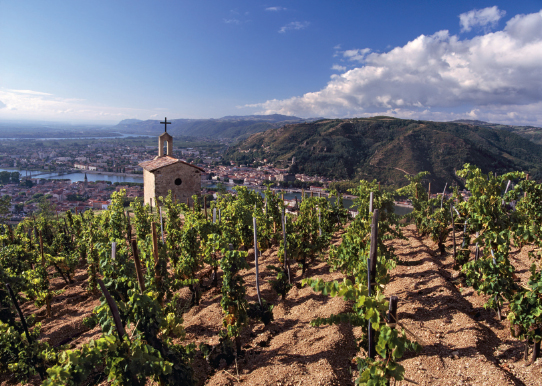
A little chapel dedicated to St Christopher sits on the peak of the hill of Hermitage in the Rhône. The hill is said to have got its name from Gaspard de Stérimberg who lived there as a hermit after his return from the 13th-century Crusades, though the name of Hermitage was not used for wine until the 16th century.
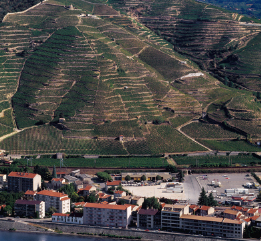
Vines have been grown on the hill of Hermitage (seen here across the Rhône) at least since the Romans occupied the area. The town at the foot of the hill is Tain, which the Romans knew as Tegna: Pliny and Martial both mention its wines by name.
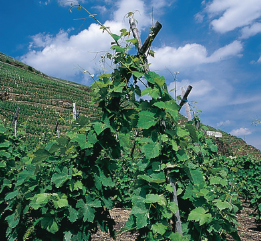
Vines on the Côte Blonde sector of Côte-Rotie. The traditional method of training vines here is up chestnut stakes arranged in a wigwam, to protect the vines from damage by the Mistral, the cold wind that blows down the Rhône Valley.
VITICULTURE AND VINIFICATION
Syrah’s reputation is for wines that seem positively to ooze sunshine and warmth, especially if you take the marvellous monsters of South Australia as your starting point. But if you start from the perfumed delicacy of, say, a Côte-Rôtie from the northern Rhône, you would think you were dealing with a much cooler climate vine. Syrah/Shiraz will lose its heavenly floral fragrance if the climate gets too hot – though if it gets too cold, as in a poor vintage on the Rhône, the wine will taste too much like root vegetables for comfort. And in the heat of Australia’s Barossa Valley or McLaren Vale, it can go from ripe to overripe in as little as a day.
It grows vigorously and gives its finest, most fascinating flavours on poor soils; on fertile soils the canopy must be open and well spread out. You can’t overcrop it and produce excellent wine, though pleasant light wine is possible at high yields. And as for aging it in new oak – well, it has so much personality it doesn’t need much new oak. Too much and it will taste like Barossa Shiraz – wherever it comes from.
Climate
Syrah has a low tolerance both of too much heat and too little. It buds late and ripens early to mid-season, and in too hot a climate will rush to overripeness. It is naturally resistant to most disease, though grey rot, bunch rot and certain viruses can be a problem.
In terms of climate the Rhône Valley is marginal. The vine needs sheltered, south-southeast- or southwest-facing sites here, where it is protected from the full strength of the Mistral, which originates further east and rips down the valley at speeds of up to 145km/h (90mph). The only virtue of such winds for the vine grower is that they help to dry the grapes after often violent rainstorms.
Hermitage has a mean temperature a couple of degrees higher than that of Côte-Rôtie, and Cornas can be hotter again, set as it is in a south-facing amphitheatre, protected from the wind. Growers in the northern Rhône seek the warmest spots for Syrah, and thus the greatest ripeness; in Australia, where Shiraz is frequently planted in regions considerably hotter than the Rhône, the last few decades have seen first a crisis of confidence, and then renewed enthusiasm for the heavyweight styles that result.
In the Barossa, source of Australia’s benchmark Shiraz, drought is a problem on the hot valley floor. The best Shiraz comes from old, old vines whose roots are deep enough to find what little water there is. Much top Shiraz from the Barossa is dry-farmed; irrigated vines here can require 5 litres of water per vine per day during the summer.
In Australia in the late 1980s a lot of effort went into seeking out cooler climates, in an attempt to mimic the climate of the Rhône. First results produced a lot of rather stringy wines, but good growers have persevered, and now the scented cool climate styles, coming especially from parts of Victoria, Canberra and Western Australia, are some of the most sought-after, several of them giving wines with something of the Barossa’s ripeness and something of Côte-Rôtie’s perfume.
Soil
This vigorous vine needs shallow, rocky, well-drained soils if it is to produce its most intense flavours. The best Rhône sites have soils derived from primary rock, especially granite, which retains the heat. Côte-Rôtie’s Côte Blonde vineyard has some gneiss (a form of granite), and the Côte Brune has mica schist (a heat-retaining schistose rock that is rich in potassium, magnesium and iron; mica weathers to clay); the granite of the southern slopes of Côte-Rôtie gives softer, more aromatic wines, while the schistose of the northern slopes gives greater tannic structure. Parts of Hermitage, Crozes-Hermitage and St-Joseph are planted on alluvial terraces, and Hermitage also has granitic soil in the west.
In the New World site selection has, as we’ve seen, traditionally been by climate rather than by soil, and many different soils are planted with Shiraz. In Australia’s McLaren Vale alone, major soil types include thin, shaly soil over limestone in the north, with next to no underground water; deep sandy soils to the southeast; clay on limestone, sand on marly limestone clay and grey loam on clay to the west and southwest; grey clay over limestone and red earth over limestone in Willunga Flats near the sea; and heavy red loam and shale in the foothills of the Southern Mount Lofty Ranges. These five major terroirs produce, respectively, concentrated, spicy, bold wines; fleshy, soft ones; wines with peppery, spicy, dark plum characters; wines with firm tannic structure; and potentially heavily cropped wines with a danger of lack of intensity.
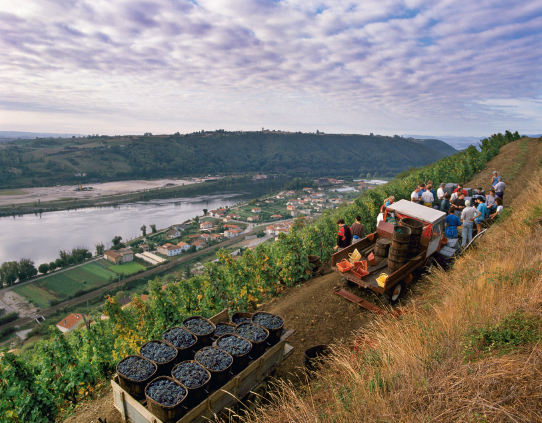
Breakfast time – on the flat road, not on the precipitous slopes – during the harvest at Côte-Rôtie. Picking has to be by hand on these slopes: much of Côte-Rôtie is terraced, making any sort of mechanization impossible. Spraying against rot, however, is often done by helicopter, which saves many man-hours.
Cultivation
When I think of the Rhône, I immediately think of stubby bush vines, gobelet-trained with one stake per vine, as in Hermitage, or Guyot simple-trained with four stakes per vine, as in Côte-Rôtie, for maximum protection against the wind. However, even within the Rhône Valley Syrah is subject to many variations in training, with training on wires increasingly popular on flatter ground where some mechanization is possible. It grows floppily, and where it is particularly vigorous it needs careful trellising to spread out its canopy: training methods elsewhere vary from bush, as in the oldest vines of the Barossa, to new systems of canopy management like Lyre and Smart-Dyson.
Yields
As usual, concentration goes hand in hand with excitement. The usual maximum permitted yield in the appellations of the northern Rhône is 40hl/ha, and while average yields have sometimes risen, particularly in Cornas, the steep hillside vineyards usually get less than this. Rhône producers maintain that at over 45hl/ha quality suffers; Australian viticulturalist Richard Smart, however, believes that it is possible to increase the crop to 10 tons/acre – that’s between 150 and 180hl/ha – with no loss of quality, through a combination of canopy management, correct pruning and water stress. (I’m still waiting to taste the results, Richard.) Barossa producer Charles Melton, by contrast, puts the limit for quality at 2 tons/acre (36hl/ha). (I’ve tasted his. Yummy.)
At the winery
The buzzword here is ‘co-fermentation’. Well, it’s not the buzzword in the Rhône, because there they’ve been doing it for aeons. In Australia, however, co-fermenting your Shiraz with a spot of Viognier, Côte-Rôtie-style, is now commonplace: it gives not just perfume but some extra silkiness of texture, but it can easily be overdone. Some producers reckon 2 per cent Viognier is enough; few would go higher than 5 per cent.
A grape as rich in colour-producing anthocyanins as Syrah can take hot fermentation temperatures of 30–35°C (86–95°F), and a maceration of anything from a few days to three weeks to maximize extraction. It used to be traditional in the Rhône to include all the stems in the fermentation vats, which made for some relentlessly tannic wines; now total or partial destemming is more common, with some growers even taking up an extreme anti-stem position. Everything we want from the grape is in the skins, they say: add the stems and you’re adding harsh tannins. Not if the stalks are ripe; and not if you vinify with care, then the stems add a haunting snappy perfume. It’s horses for courses, but a judicious addition of stems really does change the flavour and the texture.
You can still find old open fermenting tuns made of wood in the northern Rhône, but now closed vats and stainless steel are more common. In Australia some growers are returning to shallow, open fermenters with excellent results.
Later picking of riper grapes in France means that the wines are better suited to longer macerations (it also means, incidentally, that the stems, if used, are likely to be riper and less green), and to the small new oak barrels that are increasingly used for aging the wine. Côte-Rôtie has the biggest concentration of small new oak barrels – too many, I’d say; I’m longing for them to get older; Hermitage has fewer. Cornas, under the influence of enologist Jean-Luc Colombo, has been looking more kindly on new oak in recent years but I’m not convinced northern Rhônes benefit from much new oak. The oak here is French, more subtle in its flavours than American. Australian Shiraz is often run into new small American oak barrels before the fermentation is complete. Finishing the fermentation in new oak gives better integration of oak flavours, and helps to fix the colour. But new oak must, however, be handled with care: it can easily muffle the excitement of Syrah. Grange, the archetypal Australian Shiraz, has the concentration to withstand lashings of American oak; far too many of would-be Granges don’t.
SYRAH AS A BLEND
We’ve become so accustomed to varietal Syrahs and Shirazes (from the Rhône and the south of France, California and – in the form of Shiraz – from Australia) that it’s easy to forget that this is also a superlative blending grape. That was for long its role in the south of France, where it was being added as a cépage améliorateur (‘improver’ variety) to the appellation wines of Provence and Languedoc-Roussillon long before Australian-trained winemakers starting bottling it as a varietal vin de pays. In the southern Rhône, too, it plays its part in the blend along with such grapes as Grenache and Mourvèdre.
Even in the northern Rhône it has commonly been blended – and, more remarkably, with white grapes. Up to 20 per cent Viognier may be added in Côte-Rôtie – though with only five or six per cent of Viognier grown in the whole appellation, the figure is much less than that, and often zero. In Hermitage, the blending grapes are Marsanne and Roussanne: 15 per cent may be added, though again, it is increasingly rare to add any. The reasoning was that white grapes helped to soften Syrah’s high tannins; a function performed nowadays by picking at greater ripeness and better control of fermentation and maceration. New oak, too, can paradoxically help to polymerize and thus soften tannins, although one might think its only role would be to add more. So-called Rhône Ranger producers in California – lovers of all things Rhône-ish – produce some impressive blends of Syrah with the likes of Grenache and Mourvèdre; in the Napa Valley and Paso Robles, temperatures can be on the hot side for Syrah, making it less successful as a varietal. Areas like Carneros, Sonoma County and Santa Barbara further south are more successful.
Until the late 1990s the typical Australian red blend was Shiraz and Cabernet Sauvignon, mimicking an old 19th-century Bordeaux style. Cabernet/Merlot blends are now more popular, and most Shiraz is being planted for varietal wines. But blends with Viognier are flavour of the month here, too, for extra aroma and complexity. In Tuscany, Syrah blends well with Sangiovese, and in Sicily with Nero d’Avola; in Spain with Garnacha, Cabernet Sauvignon, Cariñena and Tempranillo, even all together.
SYRAH/SHIRAZ AROUND THE WORLD
You can tell a winemaker’s allegiance from the name he chooses for the grape. In France’s Rhône Valley it’s always Syrah, but then this is the archetype of the minerally, smoky herbs style. In the Languedoc it may sometimes change its name to Shiraz, reflecting brand loyalty to the Australian style of sweeter, more chocolaty fruit. In Australia it’s almost always Shiraz. In other countries like Spain, South Africa, Argentina and the USA you get both names, according to what role model the winemaker wants to adopt – French Hermitage or Australian Grange. If anything, I’d say the Syrah producers are making more progress.
France: Rhône Valley
Until the 1970s, the Syrah vineyards of the northern Rhône were struggling for survival. The terraces on the granite slopes overlooking the river had been replanted after phylloxera, but what was the point in working them? The wine sold for a pittance. Most wasn’t domaine bottled: it was either sold by the pichet in local bars, or taken away by the négociant houses – in fact, it is thanks to the latter that many of these vineyards survived at all. What changed was not the wine or the grape, but the market. People at home and abroad woke up to these wines: and the decades since have seen rapid improvements in winemaking and the expansion, not always for the best, of the vineyards.
Terroir matters here for Syrah just as much as it does for Pinot Noir in Burgundy, and the steepness of the slopes (up to 55 degrees in Côte-Rôtie) gives maximum exposure to the sun, which is crucial in a climate that is marginal for the grape. Unlike Pinot Noir in Burgundy, however, the best northern Rhône Syrahs are nearly always blends of several different terroirs.
Syrah in the northern Rhône tends to be peppery at lower ripeness levels (11–12 per cent potential alcohol), but fruity and perfumed at 12.5–13.5 per cent potential alcohol. Côte-Rôtie can be paler in colour than Hermitage and more aromatic, with floral and roasted characters on the nose. Hermitage is firm, minerally and tannic; Cornas is the darkest and most robust of the lot, but lacks the thrill of Hermitage. Crozes-Hermitages and St-Joseph are lighter versions, more peppery, sometimes coffeeish, sometimes floral, increasingly good. The reasons there are such differences in flavour between Syrahs grown close to each other are to do with aspect, temperature and soil. The Hermitage hill’s daunting slopes shouldn’t and don’t give the same flavours as the flatter vineyards of Crozes-Hermitage.
Let’s take the two main appellations of the northern Rhône as examples. The Côtes Brune and Blonde in Côte-Rôtie are both larger sectors and specific lieux-dits (named plots of land) within those sectors. The Côte Brune, the broad northern sector, has clay- and iron-rich soil and produces the denser, more long-lived wine; but Viognier, the aromatic white grape which is permitted to be blended with Syrah here, does better on the more gneiss and limestone soils of the Côte Blonde. However, since it ripens before Syrah yet must be picked at the same time (the grapes must be added at fermentation), it is generally picked overripe and quantities used in the wine, if any, are smaller than its 5 per cent share of the total vineyard would suggest.
Other key lieux-dits in Côte-Rôtie include La Mouline, which makes rich, balanced wines that fade slightly earlier than some others; La Landonne, that makes solid, backward wines which take longer to come round and which last for decades. La Turque is firm, concentrated and elegant. These are generalizations because the chief producer is Guigal whose wines are a) very oaky, and b) very, very expensive. Consequently, comparisons are rare.
At Hermitage, the granitic les Bessards vineyard makes dark, tough, concentrated wines that are the backbone of many blends. The loess soil of l’Hermite makes softer, more mellow wine; les Beaumes, with limestone and ferruginous clay, gives scented, complex wines with fairly low tannins; chalky le Méal gives supple wines; the brown limestone of les Greffieux also gives supple styles, but is even better for the inclusion of white grapes, Marsanne and Roussanne.
It is not just the soil which gives flavour differences in Hermitage. Jean-Louis Chave, arguably Hermitage’s greatest producer, believes that the remarkable smoky bacon depth of traditional Hermitage was due to an old Syrah type called Serine – with oval-shaped berries and now very rare. Certainly, Serine’s dense, savoury flavours seem completely different from the scented lush fruit displayed by many modern clones. He’s on a mission to preserve whatever’s left. If he’s in New Zealand, he might take a look at the ancient Busby clone there.
In the southern Rhône Syrah loses its monopoly of the red vineyards. The North is part of what the French label the Septentrionale zone; the South is in the Méridionale. The North’s climate is Continental, with cool winters and warm summers; the South is hotter and drier. Too hot, often, for Syrah, which can race to overripeness, and good producers give it the cooler, north-facing sites to slow it down a little. Grenache gets first refusal of the best sites in the South, though there are some high-altitude (up to 550m/1800ft) spots where the harvest can be two weeks later than the norm; it will be interesting to see if the vogue for Syrah produces some new cooler plantations here.
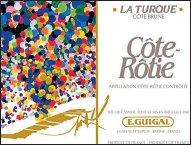
Guigal
The grapes for La Turque come from 1ha (2.5 acres) on the Côte Brune, just at the boundary with the Côte Blonde. The wine contains 5–7% Viognier.
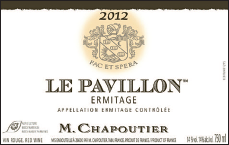
Chapoutier
Chapoutier’s Ermitage Le Pavillon uses Syrah vines that are on average 70 years old, giving a concentrated, perfumed wine.
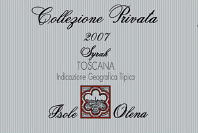
Isole e Olena
Paolo de Marchi first planted Syrah in Chianti to beef up his Sangiovese. Now it’s bottled alone and is fantastic – Syrah in fruit flavour but still Tuscan.
France: the South
Syrah plays a very important part both in Provence and in the Midi. It is mandatory in some appellations and optional in others, and along with Mourvèdre it is one of the main cépages améliorateurs. For varietal Syrah here one must usually look to the IPG category of wines, and in particular to those from the Languedoc, where it may even be rechristened Shiraz in deference to the national allegiance of the winemaker.
Australia
If the Australian settlers who first planted Shiraz in their new, untried country had been searching for a place that mimicked Hermitage, they would never have touched the Barossa or Hunter Valleys.
But of course they weren’t looking for ideal sites; they had a hot climate and wanted to plant a grape that could cope. For them Shiraz was a dream come true. It was first planted in the Hunter in the 1830s and in the Barossa in the 1840s, and from the 1860s until the 1970s and 1980s, when the vogue for Cabernet Sauvignon took over, Shiraz was the national workhorse grape. It could do anything: it could produce light, soft, jammy flavours and big, beefy reds. It could make sparkling wines (one producer used to strip the colour out with carbon) and it could make fortified wines. Not surprisingly, it was taken less than seriously and it was easy to presume that Cabernet Sauvignon seemed to be the grape of the future.
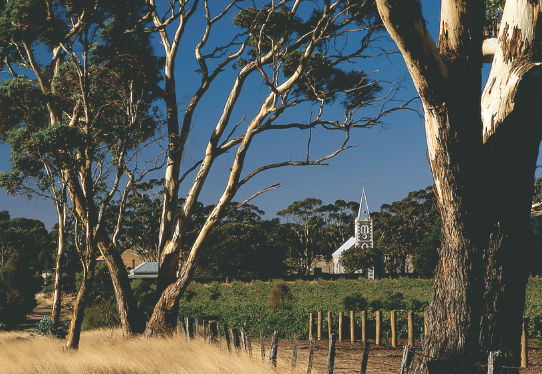
These Shiraz vines, in Henschke’s Hill of Grace vineyard, are over 100 years old. That makes them older than just about all the Syrah in the northern Rhône. The Henschkes call them ‘the grandfathers’, and the Barossa vines from which they were taken as cuttings some time in the 19th century were themselves brought to Australia from Hermitage before phylloxera struck the French vineyards. Hill of Grace Shiraz is now one of Australia’s most expensive wines.
In 1986 a government vine-pull scheme was the opportunity growers had been waiting for: they could get rid of their Shiraz, and be paid for doing so. Those who hung on could find themselves having to sell their grapes for Shiraz raisin muffins. Some of the biggest companies, however, did hang on, though not always enthusiastically. Penfolds, Lindemans, Wynns, Tyrrells and other major names continued to grow Shiraz, often blending it with the more fashionable Cabernet. What might have happened if the supply of virus-free Cabernet vines had been able to satisfy demand doesn’t bear thinking about; we should just be grateful that Australians came round in the nick of time to appreciating what they had in their own backyard.
Even after the vine-pull scheme had done its worst, there remained far more old, ungrafted Shiraz vines – often planted in the middle of the 19th century – in the Barossa and Hunter Valleys than anywhere else in the world. These vines had originally come as cuttings from the Rhône, and so, along with ancient Grenache and Mourvèdre, form a sort of living museum of pre-phylloxera France.
The knowledge of how to handle Shiraz had come from French expertise at around the same time, and had been handed down the generations even during the years when cheap fortified Shiraz was the rule. By the time Shiraz was resurrected in public esteem the knowledge still existed, though growers had forgotten its source. Barossa producer Robert O’Callaghan remembers meeting Rhône producers like Chapoutier and Jaboulet and being astounded that they knew the same things that he did.
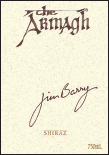
Jim Barry
Jim Barry’s The Armagh is about as big as Australian Shiraz can get – and that’s pretty big. American oak is part of the secret, great fruit the rest of it.
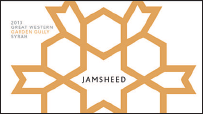
Jamsheed
A leader in the new generation of Australians making cool climate Syrah. Jamsheed grapes are from ancient vines in the Great Western region of Western Victoria.
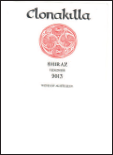
Clonakilla
Tim Kirk triumphantly pioneered the Côte Rôtie method of co-fermenting Syrah with Viognier in Australia from his vineyard near Canberra.
Shiraz is now Australia’s most significant red wine – it makes up one-quarter of the country’s total plantings and has easily surpassed the old favourite, Chardonnay. It gives spectacularly good results when taken seriously – it has become, in many respects, Australia’s premium varietal. After some ill-starred forays into too-cool climates, styles seem pretty established. Barossa makes dark chocolate-tasting wines to McLaren Vale’s milk chocolate; Eden Valley wines have more focused black fruit. Clare Valley’s fruit is more dark red. In Victoria the Grampians produces wines that have a touch of Rhône spice. Heathcote and Beechworth, with their aromatics, finesse and supple richness, could end up among the best. Geelong and Sunbury can have problems ripening, but make elegant, restrained styles, and the Hunter makes surprisingly elegant, gentle, balanced wines for such a subtropical place that used to be famous for the pong of the ‘sweaty saddle’. Canberra’s cool Shiraz is scented, Western Australia’s dark and peppery.
Fashionability has not put an end to Shiraz’s versatility in Australia. It continues to make port styles of high quality, and sparkling reds that have attained a small but devoted following abroad. There are two styles of these: those made with young base wines are simple and sweetly blackberryish; those made with aged base wine are remarkable – they taste like serious Shiraz – but with bubbles. Wicked! Shiraz could also have a future as a base grape for a fuller, richer, white sparkling wine with very different flavours to those of Champagne.
Much Shiraz, especially in South Australia, is descended from the 19th-century small-berried originals. Clonal variation in the Barossa, and in any vineyards planted with massal selections from old vineyards, reflects that in the traditional Rhône. The commercially available modern clones, are brighter, higher-yielding and sometimes beguilingly scented, but they have less potential.
USA: California
The first Syrah was planted here in the 1970s, but it took a loose-knit group of winemakers known as Rhône Rangers to show that it could be an alternative to the ubiquitous Cabernet: deeply coloured but less tannic, well-flavoured and food-friendly. Fashion has not been kind, though. In the 1990s, the Californians planted Shiraz like mad, but the American consumers never seemed to quite get it, and when they wanted an alternative to Cabernet and Merlot they preferred Pinot Noir. At one time, there was eight times as much Syrah being grown as was being drunk. A pity, because much Californian Syrah is delightful, particularly from Carneros, old plantings in Napa Valley, San Luis Obispo and Santa Barbara. And there’s French interest, too: the Perrins of Château de Beaucastel in Châteauneuf-du-Pape have a joint venture with their US importer, Robert Haas, called Tablas Creek Vineyards, growing Syrah west of Paso Robles.
THE GRANGE STORY
It was 1949 when the late Max Schubert (right) fell in love with the great reds of Bordeaux; he returned to Australia determined to recreate them in the Penfolds winery where he worked as winemaker. But there was hardly any Cabernet in Australia, which is why Grange is made from Shiraz – there was loads of that planted, though it was generally used to make sweet ‘port’. Schubert named his wine Grange Hermitage in honour of the famous Rhône red; in the 1980s the European Union insisted that Hermitage be dropped. The first commercial vintage was 1952; and in 1957 Schubert was told to stop making the wine. Nobody liked it; nobody wanted it. Did he obey? Well, no. And just as well: come 1960, those first vintages were tasting so superb that Penfolds revoked its order. Moral: never obey orders.
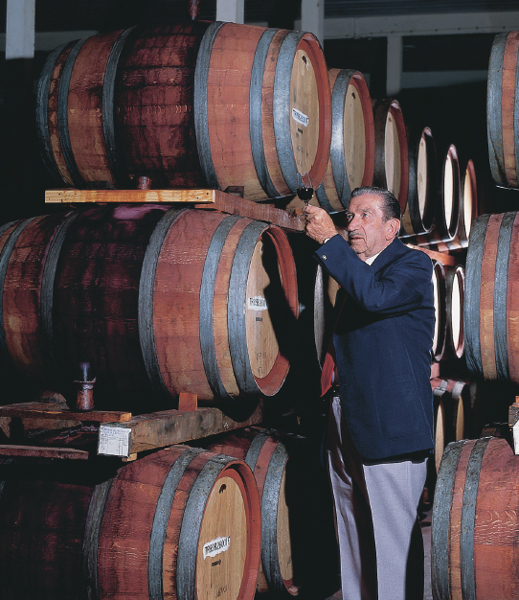
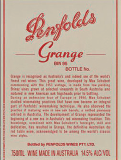
Penfolds
Grange (then known as Grange Hermitage) first found public acclaim in Australia in 1962 – after a decade of criticism. These days you’ll pay more for a single bottle of Grange than a whole ton of Shiraz grapes cost back in the wine’s early days.
As in Australia, there is a search for climate and style. The hottest parts of the Napa and the warmer sites in Paso Robles can be too hot, and Syrah is then best blended with Mourvèdre and Grenache. Here, as elsewhere, Syrah is a most obliging blender. Varietal Syrahs declare their allegiance on the label, with those calling themselves by the grape’s French name being generally spicier and meatier than the in-your-face fruit-first styles that go under the name of Shiraz. These ‘Shiraz’ are a more recent development in California, and they generally denote some Australian or New Zealand influence in the winery.
Syrah in California (which is usually larger berried than in Australia, either because it is a different clone or because of the climate) should not be confused with Petite Sirah. What California calls Petite Sirah is Durif; according to Dr Carole Meredith of UCD, ‘Durif/Petite Sirah is a seedling of Syrah. It was known that Durif was “derived” from Peloursin, but how so was not known. What we know now, from DNA research, is that Durif grew from a seedling resulting from a cross between Peloursin (mother) and Syrah (father). We think this cross was not deliberate because Dr Durif would certainly have reported the pollen source as Syrah if he had known it. It was probably just a chance pollination in his research plot.’
USA: Washington State
The first Syrah plantings were by David Lake MW of Columbia Winery in 1985 and since the mid-1990s there has been a rush of new plantings, and here consumers do seem to like what they taste: in 1999 for the first time new plantings overtook those of Merlot, the state’s second red grape. The hottest, earliest ripening vineyards give blackberry, cassis and plum flavours; cooler sites in the Yakima Valley are more mulberry and black cherry with some bacon fat. McCrea Cellars, for one, blends a little Viognier into its best cuvée.
South America
Argentina has the most, largely in Mendoza. Growers like it for its big crops of 12–14 tonnes/ha, but this cropping level stops it excelling. Even at this level, quality is respectable if canopy management is good, but the best producers are now working on yields only half as high with much improved results. Its favoured climates tend to be like the southern Rhône; in hotter spots it loses structure and acidity.
In Chile, where plantings are increasing fast, the grape seems to be perfectly at home, with more potential, some think, than either Merlot or Carmenère. A battle for bragging rights is developing between oaky, dense, warm-climate styles and thrillingly scented, cool-climate examples. Colchagua is making impressive warm styles led by Montes Folly, while the newer regions of San Antonio, Limari and Elqui are showing massive potential for richly fruited, scented reds of remarkable originality. I think I prefer these newer styles because they really are bringing an entirely new style to the Syrah table.
Rest of the world
As Shiraz it is being planted widely in South Africa, helped by the availability of better clones. Swartland is the most exciting area, producing some wines of remarkable scent and style and generally calling its wines Syrah. Paarl and Stellenbosch are also major producers with some fine examples when the oak has been kept in check.
In New Zealand it needs the warmest sites. The Gimblett Gravels area in Hawkes Bay, Martinborough and Waiheke Island have produced some beautiful wines, but expect to see exciting things from Marlborough in the future. In Austria’s Burgenland it is being planted in small quantities at the expense of lesser white varieties. In Switzerland’s Valais, where it has been planted in small quantities since 1920, it can make good, deep-coloured wines if the yields are kept down to 40hl/ha and the cap of skins and pips is well punched down during fermentation to maximize extraction. It is the first vine to bud in the spring, and one of the latest to ripen. Work is currently being done on selecting the best clones for the Valais.
Syrah is scattered in small quantities all over Italy, and blends well with local varieties like Sangiovese and Nero d’Avola as well as being made as a varietal. In Rioja it has experimental status only, but has made some interesting wines elsewhere in Spain, in Portugal and in Greece. It plays a small part in the blend at Chateau Musar in the Lebanon, and there is some, rather less distinguished, in Morocco and Tunisia. As with most of the major varieties Chinese Syrah will be coming your way soon.
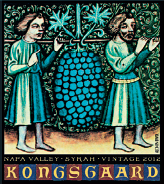
Kongsgaard
Memorable Syrahs aren’t common in California, but Kongsgaard uses fruit from volcanic soils in the cool Carneros region to brilliant, savoury, meaty effect, moderating its California power.
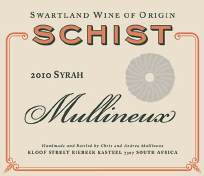
Mullineux
The Mullineux family are leaders of the new wave in South Africa producing wonderfully scented, amazingly smooth-textured Syrahs. Swartland is in the centre of this movement and even new vines give exciting wines.
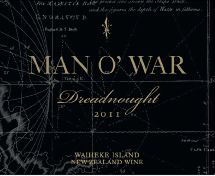
Man O’War
Syrah from dizzingly steep hillsides on Waiheke Island out in the bay opposite New Zealand’s capital Auckland. The wine is rich with blackberry fruit, but smoky, peppery and scented with violets.
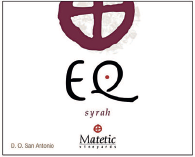
Matetic
Matetic expertly straddles the warm and the cool in Chile’s San Antonio Valley a few miles in from the sea. The granite soils suit Syrah perfectly and the wine is rich, but fresh and scented.
ENJOYING SYRAH/SHIRAZ
Our knowledge of how Syrah ages might, at first glance, seem rather limited. Until the 1960s Cornas was seldom domaine-bottled. Hermitage and Côte-Rôtie were domaine-bottled earlier than that, but it was common until the 1970s to bottle wines on demand rather than when the development of the wine in cask called for it. Wines could vary dramatically according to whether they were bottled early or late.
Hermitage is the longest-living and slowest-maturing wine in the Rhône. Good vintages need 10 or more years to loosen up, though the palate can remain tight and tannic even after the bouquet has developed plummy, spicy characters. Lesser vintages may be ready in five or six years. Top Côte-Rôties take nearly as long as Hermitage, though the Côte Blonde is earlier maturing than the Côte Brune, and top Cornas can need nearly a decade, going through a dumb phase between two and six years. Each vintage sees more good Crozes-Hermitage and St-Joseph, and they are often delicious after about three years though they can age well.
Syrah’s influence in Châteauneuf-du-Pape is waning because, with climate change, it’s difficult to stop Syrah overripening. Even so, most Châteauneuf is ready to drink by five years old but lasts much longer. Languedoc Syrahs are getting richer, but are usually good from two years old.
Most Australian Shirazes can be drunk within five years, though top old-vine versions, and especially Grange, may need up to a decade and will keep easily for 20 years or more. Cool-climate Chilean, South African and New Zealand Syrahs are excellent on release and will age a decade. eeee
The taste of Syrah/Shiraz
Young Syrah often smells, surprisingly for a red wine, of exotically scented flowers like carnations and violets. To those flavours add woodsmoke, perhaps with a few sprigs of rosemary thrown on to the fire, plus raspberries, blackberries and blackcurrants. Côte-Rôtie is more perfumed than Hermitage, which in turn is more blackcurranty, and both share a whiff of wood smoke. Hermitage, too, has a centre of tremendous succulence and richness – though if you open a bottle too young, you may wonder where this is – and it keeps this richness longer than any comparable French red wine. With age it gains gamy, leathery smells, an almost chocolatey character, and a whiff of violets and tobacco.
In Australia, flavours are creamier and more chocolatey, with blackcurrant and black cherry fruit. Hunter Valley Shiraz is leather-scented and mellow; Barossa versions are all black cherry, chocolate and spice. Clare wines have purer fruit and fine structure and Coonawarra fruit is bright and peppery. The Victoria style mixes peppery fruit with floral scents and increasingly lush texture. Nearly all Aussie Shiraz gains a thick dark taste of liquorice, prunes and black chocolate as it ages, but a few stay perfumed and blackcurranty.
The chemical compound that gives pepperiness to the grape is alpha-ylangene, and it’s found in peppercorns, as well as in other grape varieties. It’s present in Shiraz at just a few parts per billion. But if you can’t smell it, don’t worry: 20 per cent of us can’t.
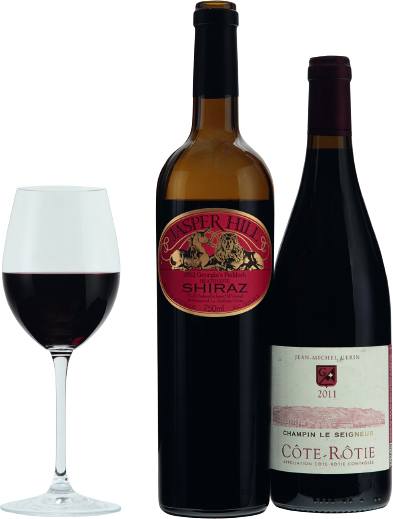
The ancient, Cambrian soils of Heathcote are so red even the sheep are crimson. Honest! I’ve seen them. But these deep, red-stained, gravelly loam soils grow brilliant Shiraz grapes for Jasper Hill. At a height of 300m (1000ft), with the Mount Camel Range funnelling cold winds onto the vines, ripening is slow and the wines have impenetrable colour yet palate-soothing tannins. Gerin’s Côte-Rôtie is made from 17 different plots of land shared between the granitic Côte Blonde and the schistous Côte Brune. Between 5 and 10% Viognier is included and, unusually, a small proportion of American as well as French oak is used.
MATCHING SYRAH/SHIRAZ AND FOOD
Whether from France (in the northern Rhône), Australia, California or South Africa, this grape needs food with plenty of flavour. Northern Rhône Syrah goes well with game, beef and venison; the same goes for the more concentrated, leathery or smoky Australian Shiraz. Australian and South African versions are perfect for picking up the smoky flavours of barbecued food.
Lighter, more berryish wines are good with turkey, guinea fowl, lamb casseroles and even chicken, providing the chicken has some flavour. Liver is a good partner, too. Light Shiraz can be a good match for the subtle spices of Indian dishes, but Chinese or Thai flavours are seldom successful with this grape. Hard English cheeses like Cheddar are good.
CONSUMER INFORMATION
Synonyms & local names
It’s called Syrah in France and Shiraz in Australia. Most producers in other regions use either name depending on the style of wine being made. Also called Petite Syrah in the northern Rhône. However, it is not to be confused with Petite Sirah, a grape grown mainly in California and Central and South America.
Best producers
FRANCE/Rhône Valley Allemand, F Balthazar, G Barge, A Belle, Chapoutier, J-L Chave, Y Chave, Clape, Clusel-Roch, Dom. du Colombier, Courbis, Coursodon, Yves Cuilleron, Delas Frères, Duclaux, E & J Durand, B Faurie, Ferraton, Pierre Gaillard, J-M Gérin, Gonon, A Graillot, Gripa, Guigal, Jamet, P Jasmin, S Ogier, V Paris, Rostaing, M Sorrel, Tardieu-Laurent, G Vernay, F Villard; Languedoc-Roussillon J-M Alquier, Estanilles, Gauby.
ITALY Stefano Amerighi, Bertelli, Cottanera, D’Alessandro, Fontodi, Isole e Olena, Le Macchiole, Planeta.
SPAIN Abadía Retuerta, Casa Castillo, Finca Sandoval, Enrique Mendoza, Pago de Vallegarcia.
PORTUGAL Cortes de Cima, Quinta do Monte d’Oiro.
USA/California Alban, Araujo, Beckmen, Dehlinger, Dutton-Goldfield, Kongsgaard, Krupp Brothers, Lagier Meredith, Andrew Murray, Pax, Qupé, Ramey, Sean Thackrey, Truchard; Washington State Betz, Cayuse, Gramercy, Hedges, Syncline.
CANADA Church & State, Colaneri, Creekside, Jackson-Triggs, Moon Curser, Painted Rock.
AUSTRALIA Tim Adams, Jim Barry, Best’s, Rolf Binder, Brokenwood, Grant Burge, Chapel Hill, Clonakilla, Craiglee, Dalwhinnie, D’Arenberg, De Bortoli, Dutschke, John Duval, Gemtree, Hardys, Henschke, Hewitson, Jamsheed, Jasper Hill, Peter Lehmann, Majella, Charles Melton, Mount Langi Ghiran, S C Pannell, Penfolds, Rockford, Seppelt, Shaw & Smith, Torbreck, Turkey Flat, Tyrrell’s, Wendouree, The Willows, Wirra Wirra, Yalumba, Yering Station.
NEW ZEALAND Bilancia, Craggy Range, Dry River, Elephant Hill, Esk Valley, Fromm, Man O’War, Millton, Passage Rock, Stonecroft, Te Awa, Te Whare Ra, Trinity Hill, Vidal, Villa Maria.
CHILE Casa Marín, De Martino, Errázuriz, Falernia, Lapostolle, Viña Leyda, Loma Larga, Matetic, Maycas del Limarí, Montes, Tabalí, Tamaya, Undurraga.
SOUTH AFRICA Boekenhoutskloof, De Trafford, Eagles’ Nest, Fairview, The Foundry, Hartenberg, Mullineux, Porseleinberg, Sadie Family, Saxenburg.
RECOMMENDED WINES TO TRY
Twelve classic northern Rhône Syrah
Chapoutier Ermitage le Pavillon
Jean-Louis Chave Hermitage
Auguste Clape Cornas
Clusel-Roch Côte-Rôtie les Grandes Places
Dom. du Colombier Hermitage
Delas Frères Hermitage les Bessards
Ferraton Crozes-Hermitage le Grand Courtil
Alain Graillot Crozes-Hermitage la Guiraude
Jamet Côte-Rôtie
Dom. du Mortier St-Joseph
Réne Rostaing Côte-Rôtie Côte Blonde
Marc Sorrel Hermitage
Eighteen other classic Shiraz/Syrah wines
Bilancia La Collina Syrah (New Zealand)
Brokenwood Graveyard Vineyard Shiraz (Australia)
Clonakilla Shiraz (Australia)
Elephant Hill Syrah (New Zealand)
Fromm Syrah (New Zealand)
Hedges Bel Villa (Washington State)
Henschke Hill of Grace Shiraz (Australia)
Jamsheed Garden Gully Syrah (Australia)
Kongsgaard Syrah (California)
Viña Leyda Syrah Reserva (Chile)
Man O’War Dreadnought Syrah (New Zealand)
Matetic Syrah (Chile)
Moon Curser Contraband Syrah (Canada)
Mullineux Schist Syrah (South Africa)
Penfolds RWT (Australia)
Porseleinberg Syrah (South Africa)
Sean Thackrey Orion Old Vines Rossi Vineyard (California)
Trinity Hill Homage Syrah (New Zealand)
Five sparkling Shiraz wines
Fox Creek Vixen Sparkling Shiraz Non-vintage (Australia)
Peter Lehmann Black Queen (Australia)
Charles Melton Sparkling Shiraz (Australia)
Rockford Black Shiraz Non-vintage (Australia)
Seppelt Show Sparkling Shiraz Vintage (Australia)
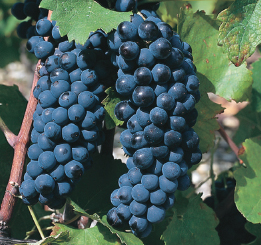
Shiraz is the comeback kid: one moment growers were pulling it up as fast as they could and the next the whole world was crying out for old-vine Shiraz. Or failing that, any Shiraz at all. And there’s a massive difference between old-vine Shiraz and young, high-yielding Shiraz.
Maturity charts
This grape is still new to most regions except the Rhône Valley and Australia, so identifying national styles is tricky.
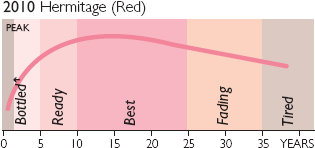
After the intensely rich 2009s, 2010 was a more typical Rhône vintage and the wines are dark, dry, rich but beautifully balanced for aging.
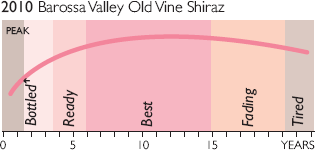
Styles here vary, but the most intense wines can combine early drinkability with the ability to age for a couple of decades or more.
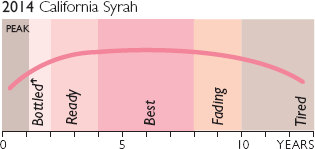
A typical California Syrah or Shiraz does not yet exist. Most wines are made to be drunk well within 3–4 years; gutsier ones are good young but will last longer.
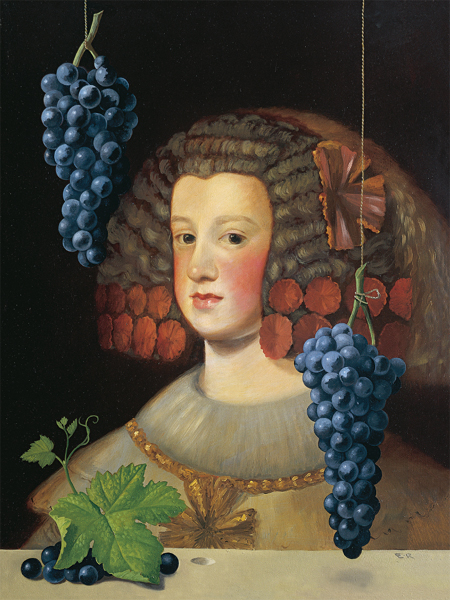
TEMPRANILLO
Tempranillo: from Grape to Glass
Geography and History here; Viticulture and Vinification here; Tempranillo around the World here; Enjoying Tempranillo here
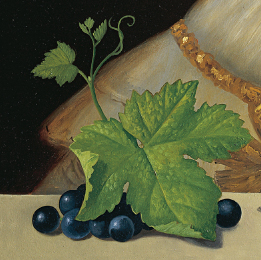
The history and grandeur of Tempranillo is conveyed by references to two Spanish artists of the 17th century: first, Diego Velázquez, the great Spanish court painter whose paintings of the royal family, including the Infanta Maria Teresa depicted here, were much admired at the time, and second, Juan Sánchez Cotán, who is best known for his still lifes with their detailed realism.
It must be tremendous to be the dominant grape variety in one of the world’s greatest wine countries. In the new age of wine becoming a global village, it must be delightful to watch other countries in both hemispheres taste with delight your handiwork in a myriad of famous wines, and you need only sit and wait for them to head back home clutching cuttings, determined to see whether they can match the mighty original.
What a pity that this is just a dream inside your head, because hardly anyone knows your name, or what wines you’re responsible for. It must make things even worse when fine bottles are broached and people coo about your qualities – and then they call you something completely different.
And that’s the problem with being Tempranillo. An awful lot of people drink your wine and think it’s smashing. But they don’t know you provided the grapes. Yet the great majority of top red wines in Spain do come from the Tempranillo in Spain, where there are about three times as many plantings as there now are of Garnacha, traditionally the dominant grape, much of whose vineyard space has been taken over by Tempranillo, even where Garnacha is much more suited (as in Rioja Baja). So why isn’t it better known?
Well, in Rioja it is well known. Tempranillo is called Tempranillo there, but it’s only in relatively recent times that Rioja has been accorded any great fame and respect outside Spain. And remember that when the Californians and Australians and South Africans and the rest were looking for grape varieties to transplant back to their distant lands, they were obsessed by the French classics – they wanted to make Bordeaux lookalikes and never cast a glance south of the Pyrenees. But if they had glanced at Ribera del Duero – and they could have done since Vega Sicilia has been Spain’s most famous and expensive red wine for a century – they’d have discovered that the main grape was called – well, Tinto Fino, actually. Where’s this taking me? Ah, the grape is actually Tempranillo, but they don’t use the name. Convenient. What about port then, over the border in Portugal? Ah, you must be thinking of Tinta Roriz. Or Aragonez. Again, what’s the relevance here? Roriz and Aragonez are Tempranillo. Yet again, they don’t use the name.
And we’re not finished yet. Back in Spain, Tempranillo is the major grape in most of the other top red wines. But Toro’s best grape is Tinto de Toro. Valdepeñas and La Mancha boast about their Cencibel. Penedès swears by the Ull de Llebre – and so it goes on, through province after province. Always an excellent red grape, always called something different. But always actually Tempranillo. I can’t think of any red grape that so completely dominates a country’s quality wines as Tempranillo does Spain’s – and which hides under so many aliases, with Portugal willingly adding a few of its own.
Since the New World winemakers are the ones who have made grape varieties famous by putting their names on the labels, you have to attract these trailblazers if your grape is to achieve any renown. Tempranillo was in the wrong place – nobody wanted to copy Spanish wines. And Tempranillo was never on the label, anyway. Spain and Portugal followed the French appellation idea of naming their wines after areas, not grapes. And since table winemaking in Iberia was dreadfully old-fashioned, who would care to spend time and money finding out if their grapes were actually any good?
It was only when a few ‘flying winemakers’ turned up in Iberia that the vineyards actually got a close look. Such winemakers have turned Iberia’s wine into some of the most exciting in Europe. And time and again, they’ve discovered that the local grape which they’ve transformed into the best grog was – the Tempranillo. Which is why Australian wineries such as Pondalowie and Gemtree and New Zealanders like Trinity Hill and Elephant Hill, having made delicious experimental wines, are taking a punt that of all the emerging new grape varieties in their countries, Tempranillo is the one to back.
GEOGRAPHY AND HISTORY
Suddenly, everyone’s talking Tempranillo. If you’re one of those who’s not, let me explain. Tempranillo is the great Spanish grape that is at the heart of Rioja and Ribera del Duero, Spain’s most famous red wines. It turns up almost everywhere else in Spain under a variety of names like Cencibel, Tinta de Toro and the rest, and could rightly be said to express the fundamental character of Spanish red wines from the cool high vineyards of the northeast to the arid plains way south of Madrid. As such, we’ve all drunk Tempranillo wines, even if we’ve not seen the name on the label. But Spain’s explosion of quality in the last few years has meant that its own grape varieties have suddenly come under examination by growers worldwide keen to find commercial alternatives to Cabernet Sauvignon and Merlot.

Southern France has had experimental plantings for quite a while. Portugal has a good deal under the names Tinta Roriz and Aragonez, and Argentina has old vines. Italy has some, but usually calls it Malvasia Nera. But it is the current wave of interest from such places as Australia, California, Washington State, and possibly New Zealand that just might make the name Tempranillo internationally famous. What’s the attraction? The world is mad for red wine – but it wants it to be both reliable and different. It wants lush textures and appealing fruit, low tannin and not too much acidity. And it wants a grape that tastes recognizable, no matter what the geographical source. Tempranillo can do all this. It has the right exuberant flavour, and what it lacks in perfume can be supplied by other grapes. It takes to new oak like a dream. It lacks acidity, but that can be rectified by canny blending. It will grow obligingly in warm climates, and it will produce anything from light young wines to older, oak-aged ones. It may not easily reflect terroir, or be that complex, but it will taste of itself and be utterly, utterly seductive.
HISTORICAL BACKGROUND
Tempranillo probably originated in Rioja or Navarra, but it’s very difficult to guess when. The earliest reliable mention is in 1807. It could be a lot older than that, or just a bit older; we don’t know.
From Spain it spread to Portugal and to Argentina and Mexico – and, more surprisingly, to Italy, where the Malvasia Nera of Tuscany and Basilicata is none other than Tempranillo. Its arrival in the Douro Valley seems to date from the 18th century, when it was planted at Quinta de Roriz by the quinta’s Scottish owner, Robert Archibald and obligingly called Roriz. Archibald is also thought to have introduced Tinta Francisca to the Douro.
In Portugal, its Spanish origins are reflected in its local name of Aragonez. In the Setúbal Peninsula it is known as Tinto de Santiago, again pointing to a Spanish source.
In Spain, local names include the Catalan Ull de Llebre (Ojo de Liebre in Spanish) in Penedès; Tinto Fino in Ribera del Duero; Cencibel in Valdepeñas; and Tinto de Madrid, Tinto de la Rioja, Tinta del País and Tinta de Toro in other parts. All these regions tend to claim that their Tempranillo is a local clone that gives a unique character to their wines; the truth is that no fewer than 552 different clones have been identified. Cencibel and Tinto Fino are not local clones; they are merely local names for a vine which may well behave slightly differently in different conditions. Variations include Tempranillo Peludo, or Hairy Tempranillo, which has more down on the back of the leaf, and Tempranillo Blanco, a chance mutation found some years ago and now authorized for use in the Rioja blend.
The name comes from the Spanish word temprano, meaning early, and reflects its early ripening nature; it also buds late, and needs only quite a short growing season. Which is why it clearly suits the cool conditions of much of Rioja, but it makes me question whether it should really be so widely planted in warmer parts of Spain.

The house of the Rodriguez family on the beautiful Remelluri estate up in the hills above Labastida in Rioja Alavesa. For many years Remelluri, a single-estate wine, was a rarity in Rioja, a region where bodegas have traditionally bought grapes from many different spots. Now there is an increasing focus on individual terroirs.
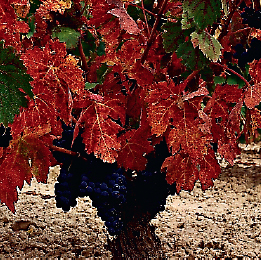
A traditionally bush-trained Tempranillo vine in Rioja: the local name for this form of training is en vaso. More and more growers, succumbing to the delights of mechanization, are training their vines on wires.
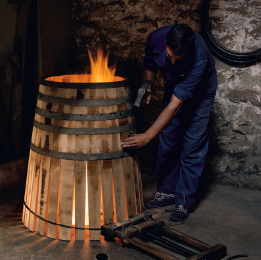
Oak barrel-aging is crucial to the character of Rioja and nowhere more so than at Bodegas Muga, where every step of red winemaking is carried out in oak, and they retain their own cooper.
VITICULTURE AND VINIFICATION
Climate and winemaking seem to be the main influences on the flavour of Tempranillo – in fact, until quite recently the flavour most associated with it was the vanilla softness of American oak. This was because the only widely known Tempranillo-based wine was Rioja, whose reputation during the 1970s and 1980s had been built almost entirely on the felicitous marriage of vanilla-scented oak and strawberry-flavoured Tempranillo. There is no long tradition of single-vineyard wines in Spain, and little emphasis until recently on the importance of different terroirs to the styles of individual wines. Most Tempranillo was and is a blend of different soils and climates and, especially in Rioja and Ribera del Duero, different grapes; more emphasis on individuality might lead to greater understanding of how the vine reacts to different terroirs. The most likely place for this to occur is Ribera del Duero, though single-vineyard Riojas are now beginning to make their presence felt.
Climate
To get elegance and acidity out of Tempranillo, you need a cool climate. But to get high sugar levels and the thick skins that give deep colour you need heat. In Spain these two opposites are best reconciled in the continental climate but high altitude of Ribera del Duero. Here, at up to 850m (2800ft), summer daytime temperatures may hit 40°C (104°F), which gives sugar and colour, but fall dramatically by up to 20°C (68°F) at night, thus conserving acidity. Summers are short here and winters long and hard: there may be as few as a hundred frost-free days a year.
Nearby Toro also has a short, hot ripening season, though at 230 days it is significantly longer than Ribera del Duero’s 171 to 198 days. Vines are planted here at between 600 and 750m (2000 and 2500ft), Rioja Alta is appreciably lower at 500–600m (1650–2000ft), and Rioja in general is less continental in climate: producers point to the temperate, Atlantic-influenced west wind that blows across their vineyards, while the Sierra de Cantabria mountains give shelter from the colder north wind. The result is lower alcohol in Rioja – typically 12.5–13 per cent, compared to 13.5–14 per cent in Toro – and less pronounced structure and fruit than in Toro and Ribera del Duero. In Portugal’s part of the Douro Valley, vineyards are planted at almost all altitudes, with the highest ones giving wines with the greatest acidity, and ripening two to three weeks after the lowest ones, but even late-ripening sites can usually produce grapes with pronounced perfume and fruit.
Soil
Soils in Rioja are relatively homogeneous compared to some regions: in the north they are mostly clay-based, and in Rioja Alta and Rioja Alavesa there are patches of chalky or iron-rich subsoil. The best wines, as is so often the case, come from the chalky clays: chalk gives acidity and elegance, clay gives body. But the ferruginous clays are full of trace elements that can add complexity.
In Toro most of the soils are alluvial, and there is some limestone in the subzone of Morales; an admixture of clay, because it holds water, enables the vines to survive the hot summers.
Both in Ribera del Duero and in the Douro Valley further west, the river Duero/Douro flows through schist. At the Spanish end there is also a lot of chalk: limestone and chalk comprise a third of the soils in the west of Ribera del Duero, and over half the soils in the east. Limestone and chalk, here again, give acidity. Aragonez from the Alentejo in southeast Portugal lacks the acidity of Tinta Roriz from the Douro, but can be a delicious, juicy mouthful.
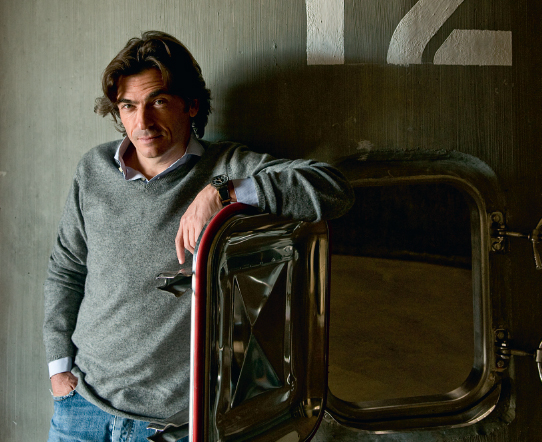
Telmo Rodríguez has been behaving like a one-man revolution in Spanish wine since the late 1980s. Based in Rioja, but active in Valdeorras, Rueda, Ribera del Duero, Toro, Alicante, Cigales and Malaga – phew! – he and his partner Pablo Eguzkiza fight to save old vineyards, preserve and propagate ancient genetic material, and re-create the traditional field blends of the different areas. They also make inspiring wines mixing the best of tradition with modern imagination.
Cultivation
The traditional pruning method for Tempranillo in Spain is the same as for so many Spanish grapes: en vaso, or gobelet. Three or four branches are left, with about 20 fruiting buds in all. Mechanization is not possible with this system, and so training on wires, usually with double cordon, is on the increase. Indeed, it seems to suit the vigour and upright habit of the vine. Densities for mechanical harvesting are lower: about 2200 vines per hectare, compared to the more traditional figure of 2500–3000 per ha. In the Douro Valley training on wires is the norm.
Tempranillo crops generously: sometimes too generously for quality because, like Pinot Noir, it is considered a very yield-sensitive vine. In the Alentejo, 1.5 to 2 kilos per vine is about the limit for quality: go to twice that and the wine will be dilute. In the Douro, seven tonnes per hectare (equivalent to about 49hl/ha) is considered quite high; in Argentina, however, 12 tonnes per hectare is considered quite low. In Argentina’s warmer, most heavily irrigated spots the vine will give 30 tonnes per hectare (or about 200hl/ha) of dilute wine, but as a simple soft glugger sold at a low price – well, it still has enough flavour to perform that task rather better than most other varieties.
In Rioja the legal limit is 45hl/ha (49hl/ha in Ribera del Duero), but while many vineyards produce less than this, there’s no doubt much of the region overproduces – particularly on newer valley-floor vineyards. Indeed, dilution through overcropping has been one of Rioja’s major problems in recent years. Training on wires increases yields, and in addition to this, irrigation was introduced in the late 1990s.
At the winery
Ribera del Duero is leading the way in Spain, producing the sort of dark, rich wines that fashion requires. Rioja is following, with longer maceration times, shorter oak aging and more use of French oak in place of the American oak that used to be the norm; some of the newest and priciest Riojas are unrecognizable as traditional Rioja. But that is because Rioja’s traditional style is one that comes from long oak aging rather than from terroir or particular fruit characters. Now the flavour profile of Tempranillo is shifting more towards plums and black cherries, and away from strawberries, toffee and spice.
Winemakers are just beginning to understand what Tempranillo can do, and so far what it seems to be best at is wines in the full but soft Merlot mould. This might point to a bright future in California and Australia. It’s prone to reduction if fermented in closed containers. Maceration times vary enormously, though too much extraction can give oily, rancid flavours, since the pips are less hard than those of Cabernet Sauvignon, and need to be handled gently. For the more modern wines, the malolactic fermentation is done in barrel to fix the colour and tannins. But the crucial difference between old-style and modern Rioja winemaking is in the length of wood aging. Tempranillo is particularly resistant to oxidation, so is able to take a lot more wood aging than many varieties – even when the crop is high and the colour and structure are light. But such wines, even if they’re technically healthy, aren’t a great mouthful because the creamy oak will completely dominate the mild fruit. A lot of Rioja is still made in this style, particularly at Reserva level, but more modern wines are usually vinified to maximize fruit and bottled earlier, for freshness.
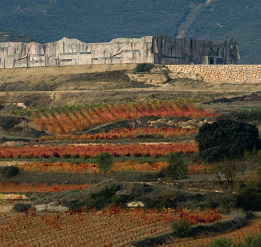
There are few wine regions except, perhaps, California’s Napa Valley, where architects have been given such a free rein as in Rioja. There are some simply stunning modern buildings, and there are elegant, subtle buildings like Torres’ new eco-friendly Labastida winery, doing all it can to blend in with the landscape rather than dominate it.
Carbonic maceration is also very popular in many regions, either for a part of or the whole of the blend, for early-drinking wines, and the Viño Joven – young wine – made from Tempranillo is very successful: deep, soft and bursting with fruit.
Much Tempranillo is blended. It may only need a seasoning of other varieties – Garnacha, Mazuelo, Graciano, Cabernet Sauvignon, Merlot, Syrah and so forth – to add perfume, acidity, flesh, or whatever the particular lack might be. But that seasoning can make all the difference. Although Tempranillo resists oxidation successfully, many unblended Tempranillo wines seem to gain little with extended aging. A seasoning with other grapes adds the spark which makes for a complex, interesting maturity.
TEMPRANILLO AND OAK
The taste of oak, which has long been associated with Rioja and thus with Tempranillo, traditionally comes from 225 litre barricas bordelesas of American oak. These were introduced by French merchants who came prospecting for wine during France’s phylloxera crisis in the 1860s and ’70s. (Phylloxera did not hit Rioja until slightly later, in 1901.)
Tempranillo and American oak get on like a house on fire: the rich vanilla flavour of the oak suits the ebullient fruit of the grape. But new oak flavours are not the ones generally found in Rioja: instead the wine gets its character from long aging in old barrels. The wine acquires a mature character over the years from all its exposure to air, and needs no further aging in bottle, although it nevertheless seems to be able to survive in bottle – albeit in what can sometimes seem a mummified form – for many, many more years.
These are the rules in Rioja: Crianza and Reserva reds must spend at least a year in oak; Gran Reservas must spend at least two years. Joven wines are unoaked. There are also legal minima for the time wines must spend in bottle or tank before release. Traditional Rioja may be given much longer in old oak barrels than the law demands. Not surprisingly, there are an awful lot of barrels in Rioja: more than 600,000 at the last count.
However, the trend in Spain is towards shorter oak aging, and a greater use of new oak – and French oak at that. The lead was given by Ribera del Duero, which pioneered a style of more youthful fruit and more pronounced new oak. More and more Rioja bodegas are now busy making wines in the same style.
But alongside the move towards new oak – seen not just in these classic regions, but in every part of Spain where Tempranillo is grown – there is an equal move towards unoaked, juicily fruited Tempranillo, even in such oak-obsessed areas as Rioja and Ribera del Duero. Given the amount of Tempranillo growing all over Spain, even in less well-known regions, this is an encouraging trend. Wines aged for many years in old oak are no longer the norm: in fact, they are rapidly becoming a niche market – even, just possibly, an endangered one.
TEMPRANILLO AROUND THE WORLD
Is Tempranillo a great grape? The jury is still out on this one. Just as Italy’s Nebbiolo has excelled only in Piedmont thus far, so it’s only Spain that has produced world-class Tempranillo – as yet. But Portugal’s new wave winemakers have made some lovely examples, and since it is basically a forgiving grape I’d expect it quickly to find fans among New World producers.
Rioja
The region of Rioja is flourishing. Prices for these wines have risen and the Spanish market seems to have an insatiable demand for Alta Expresion wines: super-premium bottles sold for high prices pulled out of the air. Even the producers admit that such prices have no relationship to costs. Not surprisingly, producers are eyeing every patch of half-decent land not yet planted with grapes. Obtaining planting rights is a problem, particularly for bodegas – the authorities prefer to give planting rights to growers – but the price of such potential vineyard land continues to rise. Rioja has been in this foment of investment and exploitation for a while now. It’s up to the authorities to try to balance demand for planting rights with the need to protect quality.
To be honest, almost all the region’s top vineyards were in production 30 years ago. You could argue that if more planting rights are not granted, then growers will simply overproduce even more to meet demand. Depressing, but true. And already production has shot up: in 1970, around 40,000ha (98,900 acres) were under vine in Rioja. By 2013 it had risen to 61,840ha (152,810 acres) – but production had more than doubled.
In Rioja Alavesa, the only part of the Rioja region located in the Basque country, and thus under different local government, there is a policy of encouraging growers to become bodegas. In the long run this must surely produce greater individuality in Rioja. Single-vineyard wines, along with special cuvées, are becoming more popular, and are very much in line with fashionable thinking, but Tempranillo does not seem to reflect its terroir as clearly as some other grapes. So a single-vineyard wine will not necessarily be more interesting than a carefully created blend.
There are, however, differences between the three parts of Rioja. Rioja Alavesa produces the most delicate, scented wines; those from Rioja Alta, where 66 per cent of the region’s Tempranillo is planted, are firmer, darker, richer. Overall more than 86 per cent of Rioja’s vineyards are planted with Tempranillo, but further east in the hotter Rioja Baja Garnacha takes over as the main grape, and makes the best wine, though too much Tempranillo is planted and its wines are frequently rather thick and stewy.
Ribera del Duero
This region, where Tempranillo covers some 80 per cent of the vineyard, owes its fame in the first place to Vega Sicilia, which was making world-class wine here more than 100 years ago. More recently a raft of new bodegas has been established: in the late 1990s there were fewer than 60, but by 2013 there were nearly 300. The vineyard area has not, however, increased by the same amount; grape prices have shot up.
Many of the wines are sold as Jovenes, full of blackberry and mulberry fruit; Crianzas and Reservas have one year’s oak aging, and Gran Reservas have two years. Reservas and Gran Reservas must have additional aging in tank or bottle before release. At least 75 per cent of the wines must be Tinto Fino; the rest may be Cabernet Sauvignon, Garnacha, Malbec, Merlot or Albillo. The most complex wines are generally the blends. Although it is easy to blame Rioja for too much oak and over-extraction in the winery, Rioja is actually on the mend, with gob-smacker black-hearted reds far less common now than a few years ago. Yet excessive use of oak and dense textures are still a problem in Ribera del Duero – such a pity when the local Tempranillo is capable of some of the most beautiful blackcurranty fruit and savoury acid balance in the whole of Spain.
Other Spanish Tempranillos
There are few places in Spain where Tempranillo does not pop up: in fact, Spanish growers are planting more Tempranillo than Cabernet Sauvignon, Merlot and Syrah put together. In Navarra it can be silky and voluptuous; in La Mancha anything from light, pale, fresh and blended with white grapes, to surprisingly intense and juicy; in Cataluña red-fruited and generally blended; in Somontano perhaps a little green; in Toro, increasingly fashionable and often massively oaky, dark, savoury, solid, low in acidity and high in alcohol; in Costers del Segre well balanced and savoury.
Portugal
In the Douro Valley, Tinta Roriz is one of the five official grape varieties recommended for port, and, with Tinta Franca, is often favoured by growers over the others. It flourishes in all parts of the region, but prefers soils that are rich in minerals. The wine can be almost astringently tannic but can have a heavenly scent, so new wave winemakers are finding ways of taming this harshness and emphasizing its raspberry and mulberry fruit and floral fragrance. It has less colour than some other port grapes, but its ability to resist oxidation means that it keeps its colour well; this lighter tint also makes it highly suitable in the blends for tawny ports.
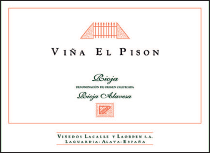
El Pison
Exceptional dense but scented and exciting ‘special cuvée’. Many producers do these ‘High Expression’ wines; only a few, like Artadi’s, are successful.
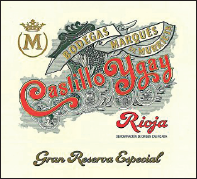
Marqués de Murrieta
Murrieta’s Gran Reserva Especial has been known to spend up up to 216 months in barrel – and still taste wonderful. This 2005 made do with 30 months.
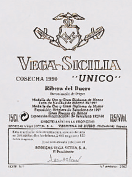
Bodegas Vega Sicilia
Vega Sicilia’s legendary Unico is traditionally Spain’s most famous red wine. Tinto Fino (Tempranillo) makes up 65–80% of the blend,.
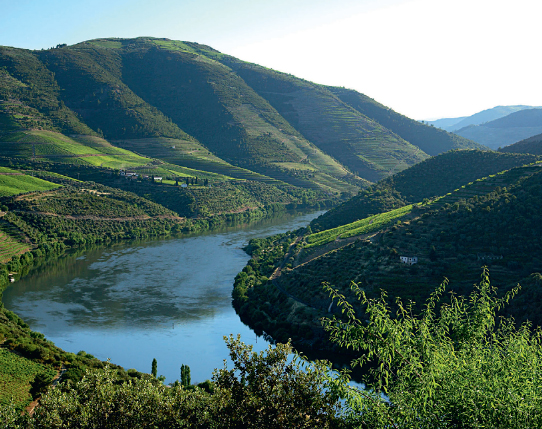
It was a Scot who first planted Tempranillo in Portugal at his Quinta de Roriz in the Douro Valley – hence the Tinta Roriz name – and, as so often in the Douro, the view simply takes one’s breath away. Douro properties always grow a number of varieties, but Tinta Roriz is the second most planted after Touriga Franca.
Further south, in the Alentejo where it is known as Aragonez, it has less tannin and acidity than it does in the Douro and this has in the past consigned it to a subsidiary role since it quickly loses colour and freshness. But new wave winemakers are now finding ways to capitalize on its lower tannin and acidity and we are now seeing gorgeous, juicy, plummy, spicy reds, ready to guzzle as soon as they are bottled.
Will these wines age? That’s not the point. In Dão the giant Sogrape company is persuading its growers to graft over to Aragonez, in an attempt to add some perfume and fruit to what is traditionally a rather lean wine and plantings in Portugal have increased rapidly since the mid-1990s.
Australia
This is one of Australia’s fastest growing varieties in percentage terms. The big wine companies like Tempranillo because it has the natural acidity to deal with hot regions like Riverland; smaller producers are starting to express frustration with its high yields. They are the main reason why Australia has yet to produce any really impressive examples. You may want 5 tons per acre, but the wretched vines want to give you 15. But then even in Rioja the clones weren’t designed for low yields. There’s nothing wrong with either climate or winemaking, though, and juicy examples are starting to appear.
South America
Tempranilla, as the grape is sometimes called in Argentina, is used as a workhorse grape, and until recently was never thought of for good wine. But that’s largely because the Argentinians grossly overproduce it. With lower yields, companies like Finca El Retiro and O J Fournier have made some really serious wines, but the toughness of the tannins shows the variety is wrestling with the warm conditions.
Rest of the world
I’ve had quite nice examples from Mexico and it has been grown in the south of France, particularly in the Aude department, for over 20 years. It’s being tried in Bulgaria, too.
In California it is probably the same as the variety known as Valdepeñas, a grape in decline and little regarded. But only a couple of Napa producers have had a go with it. Expect young tyros to take it more seriously in the next few years, expecially since it can make wines similar in softness and texture to Merlot. Globetrotting viticulturist Richard Smart feels it has potential in Oregon, either in the warmer south or in the cooler Willamette Valley; and there have been some successful attempts in Washington and Texas.
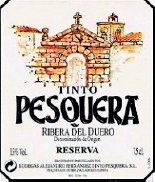
Bodegas Alejandro Fernandez
Alejandro Fernandez is known as the ‘King of Tempranillo’, which he calls the ‘Queen of Grapes’ – Pesquera is 100% Tempranillo.
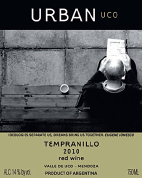
O. Fournier
Argentina’s Uco Valley has some exceptional old Tempranillo vines, but it took Spanish wine producer O. Fournier to give them some respect. .
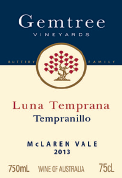
Gemtree
McLaren Vale is one of Australia’s most experimental wine regions. Gemtree excel with their Tempranillo grown on limestone soils cooled by sea breezes.
ENJOYING TEMPRANILLO
Straight Tempranillo can be absolutely gorgeous young – crunchy, juicy, herb-scented, irresistible. But its reputation, established in places like Rioja and Ribera del Duero, is as a wine that ages. Well, pure Tempranillo rarely evolves much with age; it cries out for a slug of something else – Graciano, Mazuelo, Cabernet Sauvignon – and in wines destined for aging it usually gets it.
Although Rioja was the first region to make a name for itself, Ribera del Duero has grabbed the mantle of making Tempranillo’s most age-worthy wines – and it’s interesting that the soil (a lot of limestone) and the climate (massive temperature differences between day and night) encourage acid retention and development of perfume and fruit. If only they’d use less oak. Here the finest Gran Reservas can last up to perhaps 30 years – I just had a positively virile 1953 – and even lesser wines can last a decade quite happily. But wines labelled Joven or Crianza, here as everywhere in Spain, are not intended to be aged: Joven wines should be drunk within a year or so, and most Crianza wines within a couple of years. The best Riojas are only slightly less age-worthy – a couple of beguiling 1964 Gran Reservas this year have proved the point. But traditionally made Rioja, which has been aged for several years in old oak barrels, follows a different aging pattern to more modern wines that are bottled earlier. Traditional Rioja seems to age relatively fast in its first few years in bottle, before reaching a plateau which continues for a couple of decades before gradually fading. Is this a form of mummification? The wines seem to evolve little in this period; they couldn’t be said to improve. But they certainly last. Tempranillo and Tempranillo blends from elsewhere in Spain age according to the nature of the blend: five to 10 years is probably the limit.
In Portugal, new-wave Roriz from the Douro Valley and Aragonez from the Alentejo should be drunk young, but port lasts for donkey’s years and Tempranillo/Roriz plays an important part in the blend. For more details see Touriga Nacional here.
The taste of Tempranillo
Think of a cross between Cabernet Sauvignon and Pinot Noir, and you have the flavour of Tempranillo. Well, sort of. It has the deep colour and rich flavour of the one, plus the strawberry fruit of the other – yet the complexity of neither at its best. But complexity is not the point of Tempranillo: its attractions are its lush texture and its supple, exuberant fruit, all blackberries and black cherries, mulberries and raspberries. In Ribera del Duero and Toro these flavours have a sensational savoury butter and blackcurrant slant when young and move towards tobacco, plums, prunes and cocoa with age. In lightweight Tempranillo intended for early drinking, the taste is more of strawberries and plum jam. Overripe Tempranillo is figgy and sweet; with long oak aging the flavours become savoury and strawberryish, with a touch of coffee bean and dried fruits.
Acidity can vary from low to quite high, and tannins are generally soft and ripe, though Toro and Ribera del Duero are sometimes a bit tough, as can be Roriz in the Douro. In lesser Ribera del Duero wines the acidity and oak between them can outpace the fruit in a poor year. Both tannins and acidity are, however, essential if the wine is to improve for more than a year or two.
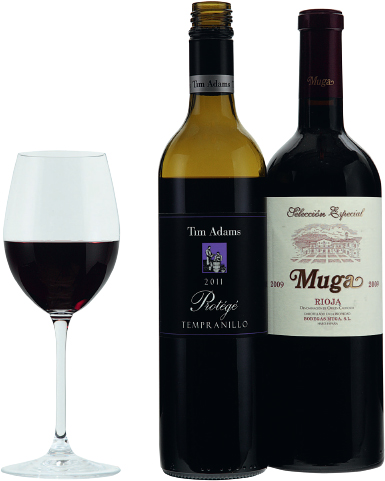
When Tempranillo was introduced to Australia, it rapidly became the fastest-expanding variety in the country. Its popularity was easy to understand – Tempranillo is easy to grow and ripen, and its best results have been in slightly cooler parts of the country like South Australia’s Clare Valley, where Tim Adams makes a particularly juicy example. Tempranillo is now grown all over Spain, under an array of pseudonyms, but Rioja makes the most famous examples. Muga is an exemplary producer, using wood rather than metal or concrete for every part of the production process, and creating sensual but structured reds easy to enjoy young, but able to improve for a generation.
MATCHING TEMPRANILLO AND FOOD
Spain’s best red native grape makes aromatic wines for drinking young, and matures well to a rich and usually oaky flavour. Northern Spanish cuisine is well suited to the gentle oaky flavours of Navarra and Rioja, as well as the more intense fruit of Ribera del Duero. Tempranillo is good with game, local cured smoked hams and sausages, especially spicy chorizo, casseroles and meat grilled with herbs; it is particularly good with roast lamb. It can partner some Indian dishes and goes well with soft cheeses such as ripe Brie.
CONSUMER INFORMATION
Synonyms & local names
Tempranillo has many synonyms in Spain – the Ribera del Duero uses Tinto Fino and the La Mancha region, especially Valdepeñas, uses the name Cencibel. Other synonyms include Tinto del País, Tinto de Toro, Tinto de Madrid and (in Penedès) Ull de Llebre (Catalan) and Ojo de Liebre (Spanish); in Portugal it is known as (Tinta) Roriz or (Tinta) Aragonez/Aragonês. Sometimes called Tempranilla in Argentina.
Best producers
SPAIN/Castilla-La Mancha Dehesa del Carrizal, Uribes Madero, Manuel Manzaneque; Rioja Allende, Altos de Lanzaga/Telmo Rodriguez, Artadi, Baron de Ley, Bilbaínas, Campillo, Campo Viejo, Contador, Contino, CVNE, DSG Vineyards, Faustino, Viña Ijalba, López de Heredia, Marqués de Cáceras, Marques de Murrieta, Marqués de Riscal, Marqués de Vargas, Martinez Bujanda, Abel Mendoza, Montecillo, Muga, Viñedos de Páganos, Palacios Remondo, Remelluri, Fernando Remírez de Ganuza, la Rioja Alta, Riojanas, Olivier Rivière, Roda, Señorio de San Vicente, Sierra Cantabria, Torres, Valdemar, Valenciso, Valpiedra, Valsacro; Ribera del Duero, Aalto, Alión, Alonso del Yerro, Arzuaga, Aster, Los Astrales, Balbás, Hijos de Antonio Barceló, Briego, Casajús, Cillar de Silos, Convento San Francisco, O Fournier, Goyo García Viadero, Hacienda Monasterio, Hacienda Solano, Matarromera, Montecastro, Emilio Moro, Pago de los Capellanes, Pago de Carraovejas, Pedrosa/Pérez Pascuas, Pesquera, Pingus, Protos, Rodero, Hermanos Sastre, Tarsus, Torres, Valduero, Valtravieso, Vega Sicilia; Navarra Chivite, Guelbenzu, Ochoa, Orvalaiz; other Spanish wines Albet I Noya, Pirineos, Romero Almonazar, San Isidro, Schenk, Viñas del Vero.
PORTUGAL Quinta dos Carvalhais, Cortes de Cima, Esporão, João Portugal Ramos, Quinta dos Roques, Quinta de la Rosa, Quinta do Vale da Raposa.
USA/California Bokisch, Justin, Twisted Oak, Viader, Kenneth Volk; Oregon Abacela; Washington State Cayuse.
AUSTRALIA Tim Adams, Crittenden, Delatite, Gemtree, La Linea, Mayford, Nepenthe, Pondalowie, Sanguine, Tar & Roses, Willunga 100, Yalumba/Running with Bulls.
NEW ZEALAND Elephant Hill, Trinity Hill.
ARGENTINA Anubis, Finca El Retiro, O Fournier, Salentein, Zuccardi.
RECOMMENDED WINES TO TRY
Ten classic Ribera del Duero (or equivalent) wines
Abadía Retuerta El Campanario
Bodegas Alión
Ismael Arroyo Val Sotillo Gran Reserva
Alejandro Fernández Pesquera Janus
Condado de Haza Alenza
Bodegas Mauro Vendimia Seleccionada
Pedrosa Gran Reserva
Dominio de Pingus Pingus
Teófilo Reyes Crianza
Vega Sicilia Unico
Ten classic Rioja wines
Finca Allende Rioja Aurus
Artadi Rioja Reserva Pagos Viejos
Bodegas Bretón Rioja Alba de Bretón
Contino Viña del Olivos
Marqués de Griñon Rioja Coleccion Personal
Marqués de Murrieta Rioja Reserva Dalmau
Marqués de Vargas Rioja Reserva Privada
Muga Rioja Reserva Especial Torre Muga
Remelluri Rioja Gran Reserva
Bodegas Roda Rioja Reserva Roda II
Señorío de San Vicente Rioja Tempranillo
Ten other Spanish Tempranillo wines
Albet I Noya Penedès Tempranillo Collecció
Chivite Navarra Gran Feudo Viñas Viejas
Guelbenzu Navarra Tinto
Ochoa Navarra Tempranillo Crianza
Orvalaiz Navarra Crianza
Pirineos Señorio de Lazán Reserva
Romero Almonazar Ribera del Guadiana
San Isidro Castillo de Maluenda Calatayud
Schenk Las Lomas Utiel-Requena
Viñas del Vero Somontano Tempranillo
Ten non-Spanish Tempranillo wines
Anubis Tempranillo (Argentina)
Quinta dos Carvalhais Dão Tinta Roriz (Portugal)
Cortes de Cima Alentejo Aragonez (Portugal)
Finca El Retiro Tempranillo (Argentina)
O Fournier Tempranillo (Argentina)
Gemtree Tempranillo (Australia)
Quinta dos Roques Dão Tinta Roriz (Portugal)
Quinta de la Rosa Tinta Roriz (Portugal)
Trinity Hill Tempranillo (New Zealand)
Quinta do Vale da Raposa Douro Tinta Roriz (Portugal)
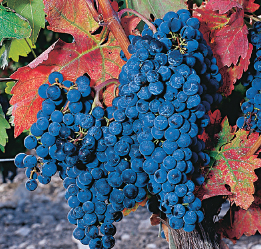
Can we expect a flood of Tempranillo from all corners of the earth in the next few years? Australian growers are planting it furiously, and it could be terrific in South America. Washington Tempranillo is pretty smart.
Maturity charts
Most Tempranillo can be drunk quite early. Only a few top Ribera del Dueros and Riojas need extended aging.
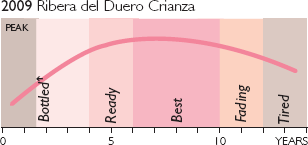
A hot dry year saved by September rains produced outstanding Ribera del Deuros, drinkable young, but capable of long aging.
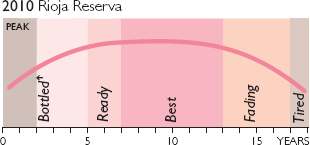
A tremendous vintage in Rioja, with a little more restraint and style than the richly impressives 2009s. Good for aging.
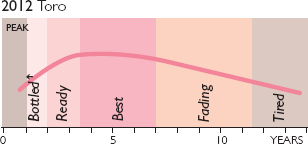
Toro seldom gains complexity in bottle, and is at its best within four or five years of the vintage. More modern styles are still chunky and chewy but easier to drink young.



































































































